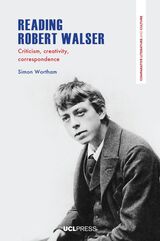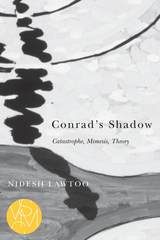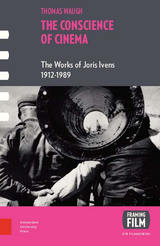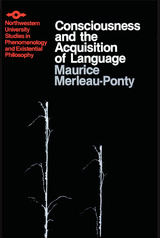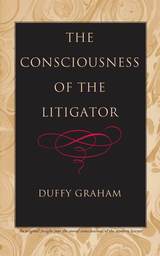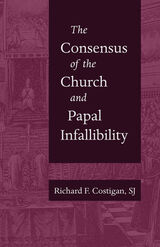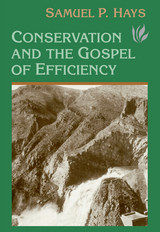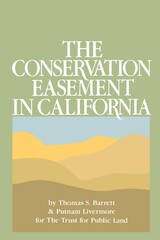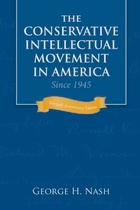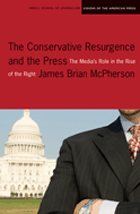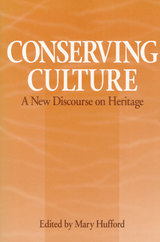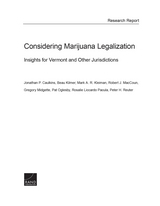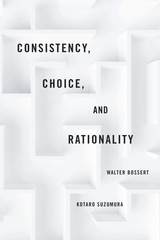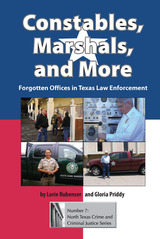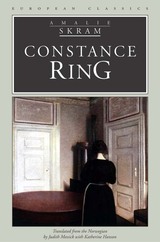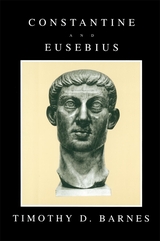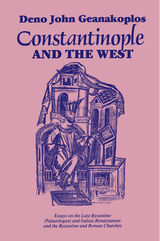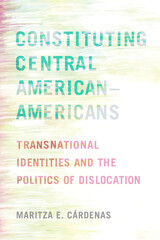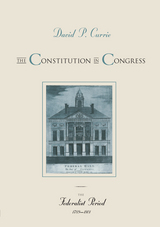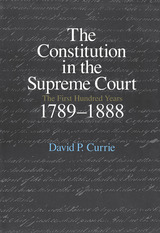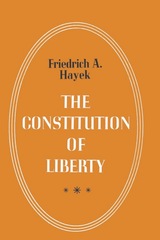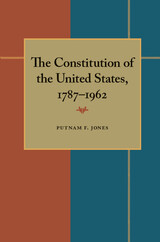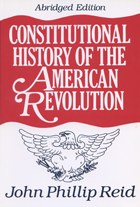 Conquering Heroines: How Women Fought Sex Bias at Michigan and Paved the Way for Title IX
Sara Fitzgerald
University of Michigan Press, 2020 In 1970, a group of women in Ann Arbor launched a crusade with an objective that seemed beyond reach at the time—force the University of Michigan to treat women the same as men. Sex discrimination was then rampant at U-M. The school’s admissions officials sought to maintain a ratio of 55:45 between male and female undergraduate entrants, turning away more qualified female applicants and arguing, among other things, that men needed help because they were less mature and posted lower grades. Women comprised less than seven percent of the University’s faculty members and their salaries trailed their male peers by substantial amounts. As one administrator put it when pressed about the disparity, “Men have better use for the extra money.”
Galvanized by their shared experiences with sex discrimination, the Ann Arbor women organized a group called FOCUS on Equal Employment for Women, led by activist Jean Ledwith King. Working with Bernice Sandler of the Women’s Equity Action League, they developed a strategy to unleash the power of another powerful institution—the federal government—to demand change at U-M and, they hoped, across the world of higher education. Prompted by a complaint filed by FOCUS, the U.S. Department of Health, Education, and Welfare soon documented egregious examples of discrimination in Michigan’s practices toward women and threatened to withhold millions of dollars in contracts unless the school adopted remedies. Among the hundreds of similar complaints filed against U.S. colleges in 1970–1971, the one brought by the Michigan women achieved the breakthrough that provided the historic template for settlements with other institutions.
Drawing on oral histories from archives as well as new interviews with living participants, Conquering Heroines chronicles this pivotal period in the histories of the University of Michigan and the women’s movement. An incredible story of grassroots activism and courageous women, the book highlights the kind of relentless effort that has helped make inclusivity an ongoing goal at U-M.
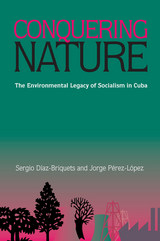 Conquering Nature: The Enviromental Legacy of Socialism in Cuba
Sergio Diaz-Briquets
University of Pittsburgh Press, 2000
Conquering Nature provides the only book-length analysis of the environmental situation in Cuba after four decades of socialist rule, based on extensive examination of secondary sources, informed by the study of development and environmental trends in former socialist countries as well as in the developing world. It approaches the issue comprehensively and from interdisciplinary, comparative, and historical perspectives. Based on the Cuban example, Díaz-Briquets and Pérez-López challenge the concept that environmental disruption was not supposed to occur under socialism since it was alleged that guided by scientific policies, socialism could only beget environmentally benign economic development. In reality, the socialist environmental record proved to be far different from the utopian view.
Between the early 1960s and the late 1980s the environmental situation worsened despite Cuba’s achieving one of the lowest population growth rates in the world and having eliminated extreme living standard differentials in rural areas, two of the primary reasons often blamed for environmental deterioration in developing countries. The government’s approach was to “conquer nature” and under its central planning approach, it did not take local circumstances into consideration. This disregard for the environmental consequences of development projects continues to this day despite official allegations to the contrary—as the country pursues an economic survival strategy based on the crash development of the tourist sector and exploitation of natural resources. An underlying conclusion of the book is that the environmental legacy of socialism will present serious challenges to future Cuban generations.
Conquering Nature provides, for the first time, a relevant analysis of socialist environmental policies of a developing country. It will be of interest to students and scholars of Cuba and those interested in environmental issues in developing countries.
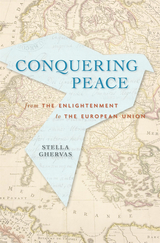 Conquering Peace: From the Enlightenment to the European Union
Stella Ghervas
Harvard University Press, 2021 A bold new look at war and diplomacy in Europe that traces the idea of a unified continent in attempts since the eighteenth century to engineer lasting peace.
Political peace in Europe has historically been elusive and ephemeral. Stella Ghervas shows that since the eighteenth century, European thinkers and leaders in pursuit of lasting peace fostered the idea of European unification.
Bridging intellectual and political history, Ghervas draws on the work of philosophers from Abbé de Saint-Pierre, who wrote an early eighteenth-century plan for perpetual peace, to Rousseau and Kant, as well as statesmen such as Tsar Alexander I, Woodrow Wilson, Winston Churchill, Robert Schuman, and Mikhail Gorbachev. She locates five major conflicts since 1700 that spurred such visionaries to promote systems of peace in Europe: the War of the Spanish Succession, the Napoleonic Wars, World War I, World War II, and the Cold War. Each moment generated a “spirit” of peace among monarchs, diplomats, democratic leaders, and ordinary citizens. The engineers of peace progressively constructed mechanisms and institutions designed to prevent future wars.
Arguing for continuities from the ideals of the Enlightenment, through the nineteenth-century Concert of Nations, to the institutions of the European Union and beyond, Conquering Peace illustrates how peace as a value shaped the idea of a unified Europe long before the EU came into being. Today the EU is widely criticized as an obstacle to sovereignty and for its democratic deficit. Seen in the long-range perspective of the history of peacemaking, however, this European society of states emerges as something else entirely: a step in the quest for a less violent world.
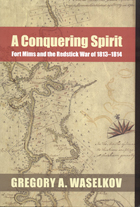 A Conquering Spirit: Fort Mims and the Redstick War of 1813–1814
Gregory A. Waselkov
University of Alabama Press, 2009 Nationwide repercussions to a bloody battle on the southern frontier. The Fort Mims massacre changed the course of American history in many ways, not the least of which was the ensuing rise of one Andrew Jackson to the national stage. The unprecedented Indian victory over the encroaching Americans who were bent on taking their lands and destroying their culture horrified many and injured the young nation’s pride. Tragedies such as this one have always rallied Americans to a common cause: a single-minded determination to destroy the enemy and avenge the fallen. The August 30, 1813, massacre at Fort Mims, involving hundreds of dead men, women, and children, was just such a spark. Gregory Waselkov tells compellingly the story of this fierce battle at the fortified plantation home of Samuel Mims in the Tensaw District of the Mississippi Territory. With valuable maps, tables, and artifact illustrations, Waselkov looks closely at the battle to cut through the legends and misinformation that have grown around the event almost from the moment the last flames died at the smoldering ruins. At least as important as the details of the battle, though, is his elucidation of how social forces remarkably converged to spark the conflict and how reverberations of the battle echo still today, nearly two hundred years later. A Dan Josselyn Memorial publication
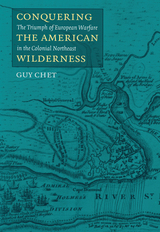 Conquering the American Wilderness: The Triumph of European Warfare in the Colonial Northeast
Guy Chet
University of Massachusetts Press, 2003 A study of military tactics and strategy before the War of Independence, this book reexamines the conquest of the North American wilderness and its native peoples by colonial settlers. Historians have long believed that the peculiar conditions of the New World, coupled with the success of Indians tactics, forced the colonists to abandon traditional European methods of warfare and to develop a new "American" style of combat. By combining firearms with guerrilla-like native tactics, colonial commanders were able not only to subdue their Indian adversaries but eventually to prevail against more conventionally trained British forces during the American Revolution. Yet upon closer scrutiny, this common understanding of early American warfare turns out to be more myth than reality. As Guy Chet reveals, clashes between colonial and Indian forces during the seventeenth and eighteenth centuries did not lead to a reevaluation and transformation of conventional military doctrine. On the contrary, the poor performance of the settlers during King Philip's War (1675–76) and King William's War (1689–1697) prompted colonial magistrates to address the shortcomings of their military forces through a greater reliance on British troops and imperial administrators. Thus, as the eighteenth century wore on, growing military success in the New England colonies reflected an increasing degree of British planning, administration, participation, and command. The colonies' military and political leadership, Chet argues, never rejected the time-tested principles of European warfare, and even during the American War of Independence, the republic's military leadership looked to Europe for guidance in the art of combat.
 The Conquerors
André Malraux
University of Chicago Press, 1991 The Conquerors describes the struggle between the Kuomintang and the Communists in the Cantonese revolution of the 1920s. It is both an exciting war story and a gallery of intellectual portraits: a ruthless Bolshevik revolutionary, a disillusioned master of propaganda, a powerful Chinese pacifist, and a young anarchist. Each of these "conquerors" will be crushed by the revolution they try to control.
In a new Foreword, Herbert R. Lottman discusses the political background of the book, and the extent to which Malraux invented the history he wrote about.
"[The Conquerors] is a valuable introduction to Malraux himself, who would, like his fictional counterpart, become an analgam of talents as novelist, essayist, Leftist and Gaullist, Resistance hero and art critic. He was among the most 'universal' of French men of letters."—Choice
"The novel can be enjoyed as a remarkable work of modernism. With images derived from the silent cinema and prose from the telegraph, it moves at a tremendous pace. Canton all comes to violent life, seen as though from a speeding car."—Kirkus
"No other writer of the 20th century had the same capacity to translate his personal adventure into a meeting with history and a dialogue of civilization."—Carlos Fuentes, New York Times Book Review
 Conquest and Agrarian Change: The Emergence of the Hacienda System on the Peruvian Coast
Robert Keith
Harvard University Press, 1976 The colonial society and economy of Latin America were based on local communities of three principal types: Spanish towns, Indian villages, and landed estates or haciendas. Of these, it was the latter that provided the economic foundations for the aristocratic social system. This book tells how and why the Spaniards who settled the Peruvian coastal valleys originally came to establish their estates. Some of the questions it attempts to answer are: Why did the hacienda system arise in the second half of the sixteenth century? Was it primarily a product of Spanish history and culture? Was it an inevitable result of the conquest? What did it owe to Indian customs and traditions? To local geography? To economic and social conditions?
Concentrating on seven major valleys of the central coast, the author investigates varying local conditions and circumstances as they appear in wills, bills of sale, contracts, and other notarial documents. The story begins with the indigenous coastal societies before the conquest and concludes with the consolidation of the hacienda system in the early seventeenth century.
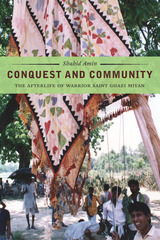 Conquest and Community: The Afterlife of Warrior Saint Ghazi Miyan
Shahid Amin
University of Chicago Press, 2016 Few topics in South Asian history are as contentious as that of the Turkic conquest of the Indian subcontinent that began in the twelfth century and led to a long period of Muslim rule. How is a historian supposed to write honestly about the bloody history of the conquest without falling into communitarian traps?
Conquest and Community is Shahid Amin's answer. Covering more than eight hundred years of history, the book centers on the enduringly popular saint Ghazi Miyan, a youthful soldier of Islam whose shrines are found all over India. Amin details the warrior saint’s legendary exploits, then tracks the many ways he has been commemorated in the centuries since. The intriguing stories, ballads, and proverbs that grew up around Ghazi Miyan were, Amin shows, a way of domesticating the conquest—recognizing past conflicts and differences but nevertheless bringing diverse groups together into a community of devotees. What seems at first glance to be the story of one mythical figure becomes an allegory for the history of Hindu-Muslim relations over an astonishingly long period of time, and a timely contribution to current political and historical debates.
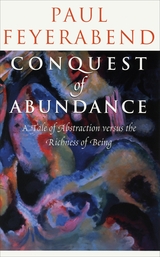 Conquest of Abundance: A Tale of Abstraction versus the Richness of Being
Paul Feyerabend
University of Chicago Press, 1999 From flea bites to galaxies, from love affairs to shadows, Paul Feyerabend reveled in the sensory and intellectual abundance that surrounds us. He found it equally striking that human senses and human intelligence are able to take in only a fraction of these riches. "This a blessing, not a drawback," he writes. "A superconscious organism would not be superwise, it would be paralyzed." This human reduction of experience to a manageable level is the heart of Conquest of Abundance, the book on which Feyerabend was at work when he died in 1994.
Prepared from drafts of the manuscript left at his death, working notes, and lectures and articles Feyerabend wrote while the larger work was in progress, Conquest of Abundance offers up rich exploration and startling insights with the charm, lucidity, and sense of mischief that are his hallmarks. Feyerabend is fascinated by how we attempt to explain and predict the mysteries of the natural world, and he looks at the ways in which we abstract experience, explain anomalies, and reduce wonder to formulas and equations. Through his exploration of the positive and negative consequences of these efforts, Feyerabend reveals the "conquest of abundance" as an integral part of the history and character of Western civilization.
"Paul Feyerabend . . . was the Norman Mailer of philosophy. . . . brilliant, brave, adventurous, original and quirky."—Richard Rorty, New Republic
"As much a smudged icon as a philosophical position holder, [Feyerabend] was alluring and erotic, a torch singer for philosophical anarchy."—Nancy Maull, New York Times Book Review
"[A] kind of final testament of Feyerabend's thought . . . Conquest of Abundance is as much the product of a brilliant, scintillating style as of an immense erudition and culture. . . . This book is as abundant and rich as the world it envisions."—Arkady Plotnitsky, Chicago Tribune
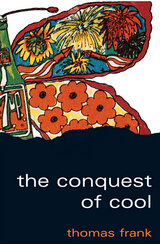 The Conquest of Cool: Business Culture, Counterculture, and the Rise of Hip Consumerism
Thomas Frank
University of Chicago Press, 1997 While the youth counterculture remains the most evocative and best-remembered symbol of the cultural ferment of the 1960s, the revolution that shook American business during those boom years has gone largely unremarked. In this fascinating and revealing study, Thomas Frank shows how the youthful revolutionaries were joined—and even anticipated —by such unlikely allies as the advertising industry and the men's clothing business.
"[Thomas Frank is] perhaps the most provocative young cultural critic of the moment."—Gerald Marzorati, New York Times Book Review
"An indispensable survival guide for any modern consumer."—Publishers Weekly, starred review
"Frank makes an ironclad case not only that the advertising industry cunningly turned the countercultural rhetoric of revolution into a rallying cry to buy more stuff, but that the process itself actually predated any actual counterculture to exploit."—Geoff Pevere, Toronto Globe and Mail
"The Conquest of Cool helps us understand why, throughout the last third of the twentieth century, Americans have increasingly confused gentility with conformity, irony with protest, and an extended middle finger with a populist manifesto. . . . His voice is an exciting addition to the soporific public discourse of the late twentieth century."—T. J. Jackson Lears, In These Times
"An invaluable argument for anyone who has ever scoffed at hand-me-down counterculture from the '60s. A spirited and exhaustive analysis of the era's advertising."—Brad Wieners, Wired Magazine
"Tom Frank is . . . not only old-fashioned, he's anti-fashion, with a place in his heart for that ultimate social faux pas, leftist politics."—Roger Trilling, Details
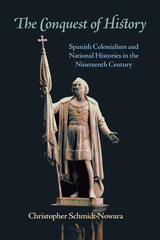 The Conquest of History: Spanish Colonialism and National Histories in the Nineteenth Century
Christopher Schmidt-Nowara
University of Pittsburgh Press, 2008
As Spain rebuilt its colonial regime in Cuba, Puerto Rico, and the Philippines after the Spanish American revolutions, it turned to history to justify continued dominance. The metropolitan vision of history, however, always met with opposition in the colonies.
The Conquest of History examines how historians, officials, and civic groups in Spain and its colonies forged national histories out of the ruins and relics of the imperial past. By exploring controversies over the veracity of the Black Legend, the location of Christopher Columbus’s mortal remains, and the survival of indigenous cultures, Christopher Schmidt-Nowara’s richly documented study shows how history became implicated in the struggles over empire. It also considers how these approaches to the past, whether intended to defend or to criticize colonial rule, called into being new postcolonial histories of empire and of nations.
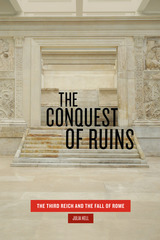 The Conquest of Ruins: The Third Reich and the Fall of Rome
Julia Hell
University of Chicago Press, 2019 The Roman Empire has been a source of inspiration and a model for imitation for Western empires practically since the moment Rome fell. Yet, as Julia Hell shows in The Conquest of Ruins, what has had the strongest grip on aspiring imperial imaginations isn’t that empire’s glory but its fall—and the haunting monuments left in its wake.
Hell examines centuries of European empire-building—from Charles V in the sixteenth century and Napoleon’s campaigns of the late seventeenth and early eighteenth centuries to the atrocities of Mussolini and the Third Reich in the 1930s and ’40s—and sees a similar fascination with recreating the Roman past in the contemporary image. In every case—particularly that of the Nazi regime—the ruins of Rome seem to represent a mystery to be solved: how could an empire so powerful be brought so low? Hell argues that this fascination with the ruins of greatness expresses a need on the part of would-be conquerors to find something to ward off a similar demise for their particular empire.
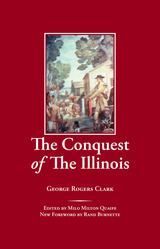 The Conquest of The Illinois
George Rogers Clark. Foreword by Rand Burnette
Southern Illinois University Press, 2001 Written only a decade after George Rogers Clark’s conquest of Illinois, this firsthand account shows the region as it existed in the 1770s, explains how British occupation affected Kentucky settlers, and exhibits Clark’s enormous diplomatic skills in convincing the French settlers and Indians along the rivers of Illinois that they were better off under the jurisdiction of the Americans rather than the British. In his new foreword to this book, Rand Burnette refers to Clark as a psychologist and an expert in human relations. Believing the British responsible for Indian raids on the people of Kentucky, Clark determined to capture that area, which was claimed by his home state of Virginia. “His plan, which he presented to Governor Patrick Henry,” Burnette notes, “was to take possession of the Illinois country by defeating the British at Kaskaskia, win the support of the French in that area, and thus control both the Mississippi and the Ohio Rivers. The British support of the Indians, who raided the Kentucky settlements from the Illinois country, would be at an end.” Clark’s stirring narrative—written between 1789 and 1791 and covering 1773–1779—chronicles the events in the Old Northwest in the second half of the eighteenth century. Life on the frontier was dangerous and uncertain at this time. As Clark points out and Milo Milton Quaife underlines in his footnotes, death came to many at the hands of Indians or in military battles and skirmishes. First published in 1920 and long out of print, the Quaife edition of Clark’s The Conquest of The Illinois reprinted here is for the modern reader superior to the original. First, Quaife provided an index. Equally important for modern readers, he standardized Clark’s spelling. (Clark had little formal education, and his spelling was even more eccentric than that found in a typical eighteenth-century account.) Finally, Quaife’s footnotes often include biographical sketches of the people in the book.
The Conquest of the Microchip
Hans Queisser
Harvard University Press, 1988 Hans Queisser tells the exciting story behind the birth of a new industry and a new knowledge that has resulted not only in a restructuring of science, technology, and industry but also in major rearrangements of political and economic power. Queisser observed at first hand the hectic growth, the triumphs and defeats, during the early days of this new era. His fascinating book provides a unique perspective that readers--even those without technical knowledge--will find extraordinarily informative.
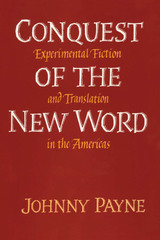 Conquest of the New Word: Experimental Fiction and Translation in the Americas
By Johnny Payne
University of Texas Press, 1993 Latin American fiction won great acclaim in the United States during the 1960s, when many North American writers and critics felt that our national writing had reached a low ebb. In this study of experimental fiction from both Americas, Johnny Payne argues that the North American reception of the "boom" in Latin American fiction distorted the historical grounding of this writing, erroneously presenting it as mainly an exotic "magical realism." He offers new readings that detail the specific, historical relation between experimental fiction and various authors' careful, deliberate deformations and reformations of the political rhetoric of the modern state. Payne juxtaposes writers from Argentina and Uruguay with North American authors, setting up suggestive parallels between the diverse but convergent practices of writers on both continents. He considers Nelson Marra in conjunction with Donald Barthelme and Gordon Lish; Teresa Porzecanski with Harry Mathews; Ricardo Piglia with John Barth; Silvia Schmid and Manuel Puig with Fanny Howe and Lydia Davis; and Jorge Luis Borges and Luisa Valenzuela with William Burroughs and Kathy Acker. With this innovative, dual-continent approach, Conquest of the New Word will be of great interest to everyone working in Latin American literature, women's studies, translation studies, creative writing, and cultural theory.
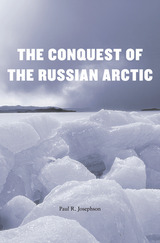 The Conquest of the Russian Arctic
Paul R. Josephson
Harvard University Press, 2014 Spanning nine time zones from Norway to the Bering Strait, the immense Russian Arctic was mostly unexplored before the twentieth century. This changed rapidly in the 1920s, when the Soviet Union implemented plans for its conquest. The Conquest of the Russian Arctic, a definitive political and environmental history of one of the world’s remotest regions, details the ambitious attempts, from Soviet times to the present, to control and reshape the Arctic, and the terrible costs paid along the way.
Paul Josephson describes the effort under Stalin to assimilate the Arctic into the Soviet empire. Extraction of natural resources, construction of settlements, indoctrination of nomadic populations, collectivization of reindeer herding—all was to be accomplished so that the Arctic operated according to socialist principles. The project was in many ways an extension of the Bolshevik revolution, as planners and engineers assumed that policies and plans that worked elsewhere in the empire would apply here. But as they pushed ahead with methods hastily adopted from other climates, the results were political repression, destruction of traditional cultures, and environmental degradation. The effects are still being felt today. At the same time, scientists and explorers led the world in understanding Arctic climes and regularities.
Vladimir Putin has redoubled Russia’s efforts to secure the Arctic, seen as key to the nation’s economic development and military status. This history brings into focus a little-understood part of the world that remains a locus of military and economic pressures, ongoing environmental damage, and grand ambitions imperfectly realized.
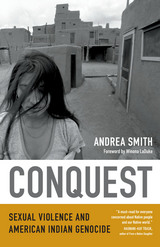 Conquest: Sexual Violence and American Indian Genocide
Andrea Smith
Duke University Press, 2005 In this revolutionary text, prominent Native American studies scholar and activist Andrea Smith reveals the connections between different forms of violence—perpetrated by the state and by society at large—and documents their impact on Native women. Beginning with the impact of the abuses inflicted on Native American children at state-sanctioned boarding schools from the 1880s to the 1980s, Smith adroitly expands our conception of violence to include the widespread appropriation of Indian cultural practices by whites and other non-Natives; environmental racism; and population control. Smith deftly connects these and other examples of historical and contemporary colonialism to the high rates of violence against Native American women—the most likely to suffer from poverty-related illness and to survive rape and partner abuse. Smith also outlines radical and innovative strategies for eliminating gendered violence.
 Conquest: The English Kingdom of France, 1417–1450
Juliet Barker
Harvard University Press, 2012 For thirty dramatic years, England ruled a great swath of France at the point of the sword—an all-but-forgotten episode in the Hundred Years’ War that Juliet Barker brings to vivid life in Conquest.
Following Agincourt, Henry V’s second invasion of France in 1417 launched a campaign that would place the crown of France on an English head. Buoyed by conquest, the English army seemed invincible. By the time of Henry’s premature death in 1422, nearly all of northern France lay in his hands and the Valois heir to the throne had been disinherited. Only the appearance of a visionary peasant girl who claimed divine guidance, Joan of Arc, was able to halt the English advance, but not for long. Just six months after her death, Henry’s young son was crowned in Paris as the first—and last—English king of France.
Henry VI’s kingdom endured for twenty years, but when he came of age he was not the leader his father had been. The dauphin whom Joan had crowned Charles VII would finally drive the English out of France. Barker recounts these stirring events—the epic battles and sieges, plots and betrayals—through a kaleidoscope of characters from John Talbot, the “English Achilles,” and John, duke of Bedford, regent of France, to brutal mercenaries, opportunistic freebooters, resourceful spies, and lovers torn apart by the conflict.
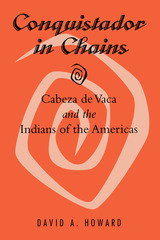 Conquistador in Chains: Cabeza de Vaca and the Indians of the Americas
David A. Howard
University of Alabama Press, 1996 A fascinating account of a Spanish conquistador who attempted to rule in South America with respect for justice and law for indigenous peoples but was returned to Spain in chains
Unlike many Spanish conquistadores who brought to the Americas a wave of disease, destruction, and oppression, Cabeza de Vaca’s stated intention was to pursue a different kind of conquest—one that would be just and humane, true to Spanish religion and law, and one that safeguarded liberty and justice for the indigenous peoples of the New World.
Bringing to South America skills and experiences earned with native peoples in North America, however, Cabeza de Vaca both failed to understand the indigenous peoples in the south and alienated many Spanish settlers in the Rio de la Plata Province, whose economic interests he threatened. Eventually the Spanish colonists formed a conspiracy to remove him from power and return him to Spain in chains.
That Cabeza de Vaca was overthrown is not surprising. His ideas and policies opposed the self-interest of most of the first Spaniards who had come to America, although he inspired the support of many even after his humiliating return to Spain. In Conquistador in Spain, historian David Howard provides a fascinating account of the rise and fall of this colonial idealist.
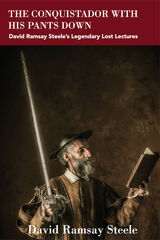 The Conquistador with His Pants Down: David Ramsay Steele’s Legendary Lost Lectures
David Ramsay Steele
St. Augustine's Press, 2024 The Conquistador with His Pants Down: David Ramsay Steele’s Legendary Lost Lectures assembles fourteen of the penetrating, provocative presentations by this controversial libertarian speaker and writer. The targets of Steele’s acerbic and witty criticisms include Scott Adams, Mattias Desmet, Sigmund Freud, Sam Harris, Karl Marx, George Orwell, Jordan Peterson, Ayn Rand, and all things conventionally Wokish. Steele’s heroes encompass Immanuel Kant, Robert Michels, Ludwig von Mises, Dexter Morgan, Karl Popper, and all who, howsoever confusedly, come down on the side of liberty, truth, and unsocial justice.
“Why Do We See Lysenko-Type Mass Delusions in Western Democracies?”
We’ve learned enough to know that Global Warming Catastrophism and the mass homicide of the Covid “vaccines” are totalitarian insanities. But can Mattias Desmet’s theory fully account for these recurring outbreaks of mass psychosis?
“Here’s Why There Can Never Be a Marxist Revolution”
There are two irrefutable reasons why genuine Marxism can never succeed. But failed fake Marxism is a real threat to all of us, especially the working class.
“The Five Times George Orwell Changed His Mind”
We can best understand George Orwell’s thinking by looking at the five occasions when he underwent a major change in his political outlook.
“The Most Evil Man in History”
Ayn Rand and her slavish worshipers depict Immanuel Kant as the Fountainhead of Evil. But in point of fact, Kant was a far greater friend of liberty and objective truth than the muddleheaded Miss Rand could ever be.
“Sam Harris and How to Spot Dangerous Ideas”
Sam Harris made his fame and his fortune by claiming that suicide bombings occur because of what the Quran tells Muslims. But the truth is that suicide bombings—by Muslims, atheists, and, yes, Christians—occur because they are the most cost-effective means for militarily weak populations to hit back against oppressive foreign occupation.
“Dexter the Busy Bee”
The serial killer Dexter Morgan confers a huge social benefit by deleting bad guys, illustrating the point made by Dr. Bernard Mandeville, that viciously-motivated behavior may give us a valuable public outcome.
“The Conquistador with His Pants Down”
Dr. Sigmund Freud, who likened himself to a conquistador, marketed a deceptive story about what his patients had told him. This false tale has been thoroughly exposed, and the slippery doctor doesn’t come out smelling like a rose.
“Dr. Peterson! Clean Up Your Theory!”
Jordan Peterson is a teller of stories and of stories about stories. But his stories about stories are provably false, and his interpretations of the stories are no more than Rorschach patterns for his own subjective fantasies.
“Is It a Fact that Facts Don’t Matter?”
Scott Adams denigrates truth, yet he continually appeals to facts. And the fact is that truth is a powerful influence in human affairs.
“An Inconceivably Humble Defense of the Inconceivably Holy Book”
In the year 112,075, humankind has recovered from the latest Ice Age and founded a new religion based on an ancient book. You’ll be surprised what our future descendants make of this charming tale recovered from our time.
“Some Second Thoughts on Atheism”
The author of Atheism Explained comes back to look again at this messy topic and mop up some of the mess.
David Ramsay Steele is the author of The Mystery of Fascism: David Ramsay Steele’s Greatest Hits (2019), Orwell Your Orwell: A Worldview on the Slab (2017), Therapy Breakthrough: Why Some Psychotherapies Work Better than Others (with Michael R. Edelstein and Richard K. Kujoth, 2013), Atheism Explained: From Folly to Philosophy (2008), Three Minute Therapy: Change Your Thinking, Change Your Life (with Michael R. Edelstein, 1997), and From Marx to Mises: Post-Capitalist Society and the Challenge of Economic Calculation (1992).
Rave Reviews of Dr. Steele’s earlier books:
The Mystery of Fascism
“From Mussolini to The Matrix, from vegetarianism to mental illness, Steele’s relentless logic jolts us awake.”
—Thomas E. Woods, author of The Politically Incorrect Guide to American History
Orwell Your Orwell
“an absolutely dazzling book on Orwell, casting a brilliant new light, not just on Orwell himself, but on the entire intellectual history of our time.”
—Yuri Maltsev, editor of Requiem for Marx
Therapy Breakthrough
“Prepare to embark upon a rollicking yet highly informative journey through the intense world of psychotherapy!”
—Debbie Joffe Ellis, author of How to Hug a Porcupine
Atheism Explained
“Covers essentially all the arguments for and against God, in science, philosophy, and theology, with sympathy for the believer’s views even as they are shown to be untenable,”
—Victor J. Stenger, author of God and the Atom
Three Minute Therapy
“Of all the books that explain REBT in simple, clear, and highly usable form, Three Minute Therapy is one of the very best.”
—Albert Ellis, founder of REBT
From Marx to Mises
“a well written and tightly argued defense of Mises’s position that does much to dispel the ‘mystery’ of the socialist calculation debate.”
—Mark Blaug, Economic Journal
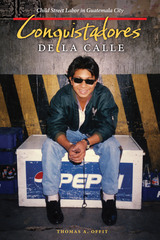 Conquistadores de la Calle: Child Street Labor in Guatemala City
By Thomas A. Offit
University of Texas Press, 2008 The first comprehensive, book-length study of its kind, Conquistadores de la Calle presents the findings of nearly two years of ethnographic research on the streets of Guatemala City, toppling conventional wisdom that the region's youth workers are solely victims, or that their labor situations are entirely the result of poverty and family breakdown. Documenting the voices and experiences of the city's working children, this fascinating study reveals counterintuitive motivations for those who choose to abandon schooling in favor of participating more fully in their families' economies. The processes of developing skills and planning for their social and economic futures are covered in depth, presenting evidence that many members of this population operate well above survival level and are decidedly not marginalized or members of an underclass. Conquistadores de la Calle also makes important distinctions between these young workers—a generation of Maya and Ladino boys and girls—and the homeless children or gang youth who have been so much more widely studied. Contextualizing a variety of data, ranging from detailed ethnographic portraits of the children's lives and the monthly income of children engaged in common street vocations (such as shining shoes or serving as porters) to educational histories and socialization activities, Thomas Offit has produced a rich trove of findings in a significant segment of urban economics that is tremendously important for anthropologists, Latin Americanists, and those interested in the lives and labors of children in the cities of the developing world.
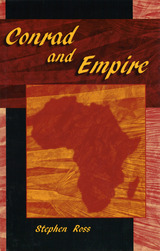 Conrad and Empire
Stephen Ross
University of Missouri Press, 2004
In Conrad and Empire, Stephen Ross challenges the orthodoxy of the last thirty years of Conrad criticism by arguing that to focus on issues of race and imperialism in Conrad’s work is to miss the larger and more important engagement with developing globalization undertaken there. Drawing on the conceptual model provided by Arjun Appadurai and by Michael Hardt and Antonio Negri, Ross maintains that Conrad’s major novels confront an emergent new world order that replaces nation-state-based models of geopolitics with the global rule of capitalism, and shows how Conrad supplements this conceptualization by tracing the concrete effects of such a change on the psyches of individual subjects. Borrowing from Slavoj Žižek and Jacques Lacan, Ross contends that Conrad’s major novels present us with an astute vision of a truly global world order.
Devoting a chapter to each novel, the author analyzes Heart of Darkness,Lord Jim, Nostromo, and The Secret Agent to expose their social vision, their concern with individual experience, and their philosophical synthesis of the two. After showing how Conrad sets the stage, Ross considers selected characters’ personal histories and the family romances by which Conrad sheds light on individual characters’ motives, exposing the penetration of ideological forces into personal lives. He then shows how the drama of slave morality in each of the novels synthesizes their critique of social organization and their attention to personal history by revealing how each novel follows an individual character’s doomed attempt to transcend the totalizing dimensions of Empire.
Ross claims that though postcolonial criticisms of Conrad’s work have produced excellent insights, they remain inadequate to understanding its complexity. Instead, he argues, Conrad’s novels should be read for their compellingly prescient vision of a postnational world under the sway of global capitalism. Although Conrad’s vision of that world is undeniably bleak, Ross believes, his almost willful reaffirmation of the very values he has shown to be bankrupt constitutes a “weak idealism.” Consequently, Ross argues, Conrad’s fiction is profoundly ethical and pertinent to the pressing project of how to live in a bewilderingly variable world.
 Conrad’s Models of Mind
Bruce Johnson
University of Minnesota Press, 1971 Conrad's Models of Mind was first published in 1971. Minnesota Archive Editions uses digital technology to make long-unavailable books once again accessible, and are published unaltered from the original University of Minnesota Press editions. In a new approach to understanding the psychological assumptions that lie behind the creation of a work of fiction, Professor Johnson analyzes a number of Joseph Conrad's novels and short stories, identifying and explaining Conrad's changing conceptions or models of mind. As he points out in his introduction: "Every writer makes assumptions about the nature of the mind, whether they may be elaborate theories, metaphors that seem simple but imply a great deal, downright beliefs, or vague gestalten. And such assumptions color his whole creation, the way his characters think and feel and react, possibly even his choice of subject matter." The author traces Conrad's steady progression away from deductive psychology, involving such entities as will, passion, ego, or sympathy, toward a flexible, and, for the period, new psychology that had implications for his entire development as a writer. Professor Johnson finds certain affinities between Conrad's models of mind and those of a number of other writers, among them, Schopenhauer, Sartre, and Pascal. He shows that one aspect of Conrad's psychology was closely allied to the Schopenhauerian concept of will but that when he wrote Lord Jim, Heart of Darkness, and Nostromo Conrad moved toward an existential concept of self-image and self-creation similar to Sartre's psychology in Being and Nothingness. Finally, Professor Johnson examines Conrad's novel The Rescue and shows how hopeless it was for Conrad to return to earlier conceptions of mind after he had explored the new existential models.
Conrad's Shadow: Catastrophe, Mimesis, Theory
Nidesh Lawtoo
Michigan State University Press, 2016 Western thought has often dismissed shadows as fictional, but what if fictions reveal original truths? Drawing on an anti-Platonic tradition in critical theory, Lawtoo adopts ethical, anthropological, and philosophical lenses to offer new readings of Joseph Conrad’s novels and the postcolonial and cinematic works that respond to his oeuvre. He argues that Conrad’s fascination with doubles urges readers to reflect on the two sides of mimesis: one side is dark and pathological, and involves the escalation of violence, contagious epidemics, and catastrophic storms; the other side is luminous and therapeutic, and promotes communal survival, postcolonial reconciliation, and plastic adaptations to changing environments. Once joined, the two sides reveal Conrad as an author whose Janus-faced fictions are powerfully relevant to our contemporary world of global violence and environmental crisis.
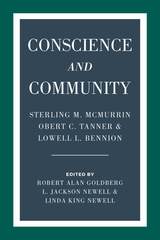 Conscience and Community: Sterling M. McMurrin, Obert C. Tanner, and Lowell L. Bennion
Edited by Robert Alan Goldberg, L. Jackson Newell, and Linda K. Newell
University of Utah Press, 2018 Lowell Bennion, Sterling McMurrin, and Obert Tanner were colleagues whose lives often intertwined. All professors at the University of Utah, these three scholars addressed issues and events of their time; each influenced the thought and culture of Mormonism, helping to institute a period of intellectual life and social activism. In Conscience and Community multiple scholars, family members, and others look at the private and public aspects of three lives and examine the roles they played in shaping their communities inside and out of their university and church.
Lowell Bennion was founding director of the LDS Institute of Religion and professor of sociology at the University of Utah. He established multiple community service entities. Sterling McMurrin was distinguished professor of philosophy and history, dean of the graduate school, and former commissioner of education under JFK. He dismissed dogma and doctrine as barriers to a search for moral and spiritual understanding. Obert Tanner, also of the university’s Philosophy Department, excelled in teaching and business and became especially well known for philanthropy. The lives and work of these three men reveal the tensions between faith and reason, conscience and obedience. Their stories speak to us today because their concerns remain our concerns: racial justice, women’s equality, gay rights, and the meaning of integrity and conscience.
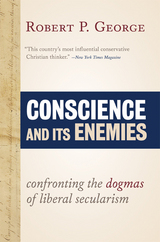 Conscience and Its Enemies: Confronting the Dogmas of Liberal Secularism
Robert P. George
Intercollegiate Studies Institute, 2013
“Brilliant . . . Should be required reading.” —Commentary
“As a critic of liberalism, George is devastating.” —National Review
“Puts George’s highly burnished philosophical and constitutional learning on full display . . . George speaks for a sizable number of conscientious objectors to America’s ruling liberal secularism.” —New York Times Book Review
“Could not be more timely. A treasure trove of thought-provoking reflections by one of the best minds of our time.” —Mary Ann Glendon, Harvard Law, from the foreword to the updated and expanded paperback edition of Conscience and Its Enemies
Assaults on religious liberty and traditional morality are growing fiercer. Here, at last, is the counterattack.
This revised and updated paperback edition of the acclaimed Conscience and Its Enemies showcases the talents that have made Robert P. George one of America’s most influential thinkers. Here George explodes the myth that the secular elite represents the voice of reason. In fact, it is on the elite side of the cultural divide where the prevailing views are little more than articles of faith. Conscience and Its Enemies reveals the bankruptcy of these too often smugly held orthodoxies while presenting powerfully reasoned arguments for classical virtues.
In defending what James Madison called the “sacred rights of conscience”—rights for which government shows frightening contempt—George grapples with today’s most controversial issues: same-sex marriage, abortion, transgenderism, genetic manipulation, euthanasia and assisted suicide, religion in politics, judicial activism, and more. His brilliantly argued essays rely not on theological claims or religious authority but on established scientific facts and a philosophical tradition that extends back to Plato and Aristotle.
Conscience and Its Enemies sets forth powerful arguments that secular liberals are unaccustomed to hearing—and that embattled defenders of traditional morality so often fail to marshal.
 Conscience and Memory: Meditations in a Museum of the Holocaust
Harold Kaplan
University of Chicago Press, 1994 Prompted by the suicides of Jean Amery and Primo Levi, Harold Kaplan sought to ask what the Holocaust can be said to affirm even even in the face of its overwhelming negation of meaning. "I wrote this book," he explains, "to translate the Holocaust out of the moral and intellectual shock which contemplates the alienation of humanity from itself. I wished to understand the 'crime against humanity' as a viable category of the moral reason. And I wished to respond to the written testimony of Holocaust victims and survivors as if the issue of their survival were present to us today."
Kaplan simulates the response to a long visit to the new Holocaust museum in Washington, D.C., which, crucially for Kaplan, is sited in direct view of the Jefferson and Lincoln monuments, powerful symbols of humanist democracy. He insists the Holocaust be viewed not only in terms of personal ethics but modern political ethics as well: for Kaplan the affirmative legacy of the Holocaust is its focus on the dangers of nationalism, racism, and all forms of separatist group identities. It challenges the historicism, cults of power, and scientistic politics of modernity. And it challenges the moral passivity and relativism of mass politics in Western and Eastern societies.
The opening of the Holocaust museum has sparked a debate that reflects a larger debate over the Holocaust's "meaning," its translatability for ordinary understanding. Some deny any possible response except that of overwhelming grief and horror. For others, the "lesson" of the Holocaust implies, in the words of Robert Nozick, that "mankind has fallen. . . . Humanity has lost its claim to continue." The moral life and political institutions will remain endlessly tormented by the Holocaust. That, Kaplan tells us, is the ultimate content of its "meaning," and is what makes the discussion of "meaning" much more than a mourner's symposium.
The Museum itself, according to Kaplan, has become an impressive memorial to the principle of humanism, instructing the collective memory of this democracy and that of nations everywhere which aspire to civil existence. Out of its awful darkness the Holocaust throws the light of conscience for those capable of receiving it.
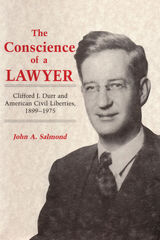 The Conscience of a Lawyer: Clifford J. Durr and American Civil Liberties, 1899–1975
John A. Salmond
University of Alabama Press, 1990 A powerful portrait of principle and protest in the life of a Southern lawyer who stood for civil liberties. Clifford Judkins Durr was an Alabama lawyer who played an important role in defending activists and other accused of disloyalty during the New Deal and McCarthy eras. His uncompromising commitment to civil liberties and civic decency caused him to often take unpopular positions.
In 1933, Durr moved to Washington to work as a lawyer for the Reconstruction Finance Corporation, a creation of Roosevelt’s new Democratic administration, becoming a dedicated New Dealer in the process. He was then appointed by President Franklin D. Roosevelt to the Federal Communications Commission (FCC), a politically sensitive position as FDR sought to counter the increasing power and concentration of broadcasters, many of whom were opponents of the New Deal. Durr resigned from the FCC in 1948 and after brief employment with the National Farmers Union in Colorado, the Durrs eventually returned to Montgomery, Alabama in the hope of returning to a more prosperous, less controversial life.
Durr continued to practice in Montgomery as counsel for black citizens whose rights had been violated and ultimately, in December, 1955, when police arrested Rosa Parks for refusing to give her bus seat to a white man he stepped in and lent his extensive legal prowess to her case and the continuing quest for civil rights. Closing his firm in 1964 Durr began to lecture in the United States and abroad. He died at his grandfather's farm in 1975.
 The Conscience of Care: Navigating Health in the Culture Wars
Dov Fox
Harvard University Press, 2025 Amid historic restrictions on abortion, puberty blockers, and assisted suicide, a health-law expert exposes America’s broken system of medical conscience, which shields clinicians who refuse evidence-based care yet offers no protections to those who provide prohibited treatment.
Pitched battles over abortion, puberty blockers, and assisted suicide have turned American healthcare into a legal minefield. Faced with mounting restrictions on medical practice, doctors and nurses who follow their conscience to provide standard treatments risk being fined, fired, or even imprisoned, while clinicians who conscientiously deny evidence-based care are shielded without condition from any such consequences. Dov Fox argues that by ceding the moral vocabulary of conscience to refusers alone, the lopsided law of medical conscience selectively burdens providers, drives vulnerable patients underground, and impoverishes the dynamic pluralism of medicine.
The Conscience of Care lays bare the broken system of medical conscience and sets out to fix it. Fox canvases a landscape of contested services that include IVF, IUDs, opioids, psychedelics, organ transplants, and advance directives. He develops practical reforms that rebalance conscience protection by introducing measured safeguards for providers and scaling back the categorical refuge afforded to refusers. The Conscience of Care articulates a bold vision of medicine that reclaims the lost promise of conscience to bridge social divides on matters of life and death, impairment and identity.
The Conscience of Cinema
Thomas Waugh
Amsterdam University Press, 2016 This is the first book to survey the entire career of Joris Ivens, a prolific documentary filmmaker who worked on every continent over the course of seven decades. More than a biography of a leftist committed to changing the world through film, The Conscience of Cinema is also a microcosmic history of the documentary and its form, culture, and place within twentieth-century world cinema. Ivens worked in almost every genre, including the essay, compilation, hybrid dramatization, socialist realism, and more. Whether in his native Netherlands, the Soviet Union, the United States, Vietnam, or beyond, he left an indelible artistic and political mark that continues to resonate in the twenty-first century.
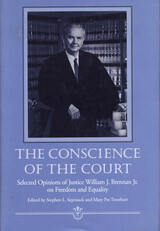 The Conscience of the Court: Selected Opinions of Justice William J. Brennan Jr. on Freedom and Equality
Edited by Stephen L. Sepinuck and Mary Pat Treuthart
Southern Illinois University Press, 1999
The Conscience of the Court celebrates the work of Justice William J. Brennan Jr., who served on the United States Supreme Court for thirty-four years (1956–1990).
Stephen L. Sepinuck and Mary Pat Treuthart introduce and present selected judicial opinions written by Justice Brennan on issues involving personal freedom, civil liberties, and equality. Brennan is ranked by many as the best writer ever to have served on the Supreme Court, and his written opinions depict real people, often in desperate, emotional situations. Remarkable for their clarity of analysis, for their eloquence, and for their forcefulness and persuasiveness, his opinions demonstrate that judicial thought need not be a proprietary enclave of lawyers or the intellectual elite.
The extended excerpts selected by Sepinuck and Treuthart highlight Brennan's approach to judicial decision making. Concerned always with how each decision would actually affect people's lives, Brennan possessed a rare quality of empathy. In Brennan, the editors note, "people and groups who lacked influence in society—Communists and flag burners, children and foreigners, criminal defendants and racial minorities"—found a champion they could count on "to listen to their causes and judge them unmoved by the passions of the politically powerful."
In their introduction to each opinion, the editors provide background facts, discuss how the excerpted opinion transformed the law or otherwise fit into the realm of constitutional jurisprudence, and delve into Justice Brennan's judicial philosophy, his method of constitutional interpretation, and the language he used.
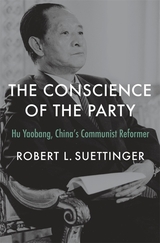 The Conscience of the Party: Hu Yaobang, China’s Communist Reformer
Robert L. Suettinger
Harvard University Press, 2024 The definitive story of a top Chinese politician’s ill-fated quest to reform the Communist Party.
When Hu Yaobang died in April 1989, throngs of mourners converged on the Martyrs’ Monument in Tiananmen Square to pay their respects. Following Hu’s 1987 ouster by party elders, Chinese propaganda officials had sought to tarnish his reputation and dim his memory, yet his death galvanized the nascent pro-democracy student movement, setting off the dramatic demonstrations that culminated in the Tiananmen massacre.
The Conscience of the Party is the comprehensive, authoritative biography of the Chinese Communist Party’s most avid reformer and its general secretary for a key stretch of the 1980s. A supremely intelligent leader with an exceptional populist touch, Hu Yaobang was tapped early by Mao Zedong as a capable party hand. But Hu’s principled ideas made him powerful enemies, and during the Cultural Revolution he was purged, brutally beaten, and consigned to forced labor. After Mao’s death, Hu rose again as an ally of Deng Xiaoping, eventually securing the party’s top position. In that role, he pioneered many of the economic reforms subsequently attributed to Deng. But Hu also pursued political reforms with equal vigor, pushing for more freedom of expression, the end of lifetime tenure for CCP leaders, and the dismantling of Mao’s personality cult. Alarmed by Hu’s growing popularity and increasingly radical agenda, Deng had him purged again in 1987.
Historian and former intelligence analyst Robert L. Suettinger meticulously reconstructs Hu’s life, providing the kind of eye-opening account that remains impossible in China under state censorship. Hu Yaobang, a decent man operating in a system that did not always reward decency, suffered for his principles but inspired millions in the process.
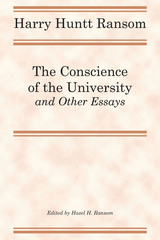 The Conscience of the University, and Other Essays
By Harry Huntt Ransom
University of Texas Press, 1982 In 1982, a century after the laying of the cornerstone of its first building, the University of Texas was ranked by the New York Times among the best in the nation. No one had more to do with that extraordinary achievement than Harry Huntt Ransom. From 1935 to his death in 1976, he served the University in positions ranging from instructor in English to chancellor of The University of Texas System. In the fifties, sixties, and seventies, he held a succession of administrative posts requiring him to face a myriad of perplexing problems. Among the critical issues calling for analysis and decision in those years were the post-Sputnik pressure for greater emphasis on science and technology, the student revolts during the 1960s, and the defection of growing numbers of university faculty to industry and government. Harry Huntt Ransom did not merely respond to the problems of the times. He had his own large ambitions for the University of Texas, in particular the improvement of student programs, the development of a vigorous faculty, and—the achievement for which he is best remembered—the building of a world-renowned library. He was concerned with the role of the university in society, what the university should do and do well, and what it should not do. Always he viewed these matters in broad perspective, and his approach to them was far-sighted and deeply philosophical. As dean, vice-president, president, and chancellor, Ransom wrote and spoke often on these and other important subjects. Aside from the books that he wrote and edited, he left a prodigious amount of material, some of which had been published in various journals and some of which had been delivered as lectures and addresses and never made available in printed form. For the last twenty-five years of Ransom's life his wife, Hazel, was his closest companion and confidant. At the urging of Harry's friends, colleagues, and admirers, she undertook the task of sifting through her late husband's papers in an effort to organize and preserve some of the important contributions he had made to the thought and planning that were so instrumental in shaping the University of Texas and higher education in general. In these essays we see the force of reasoning and grace of style for which Ransom was so widely admired. It was he who reminded us that books last longer than buildings. This is a book of lasting importance that Harry Ransom himself might have given us had he lived longer.
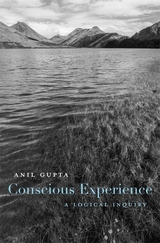 Conscious Experience: A Logical Inquiry
Anil Gupta
Harvard University Press, 2019 A distinguished philosopher offers a novel account of experience and reason, and develops our understanding of conscious experience and its relationship to thought: a new reformed empiricism.
The role of experience in cognition is a central and ancient philosophical concern. How, theorists ask, can our private experiences guide us to knowledge of a mind-independent reality? Exploring topics in logic, philosophy of mind, and epistemology, Conscious Experience proposes a new answer to this age-old question, explaining how conscious experience contributes to the rationality and content of empirical beliefs.
According to Anil Gupta, this contribution cannot be determined independently of an agent’s conceptual scheme and prior beliefs, but that doesn’t mean it is entirely mind-dependent. While the rational contribution of an experience is not propositional—it does not, for example, provide direct knowledge of the world—it does authorize certain transitions from prior views to new views. In short, the rational contribution of an experience yields a rule for revising views. Gupta shows that this account provides theoretical freedom: it allows the observer to radically reconceive the world in light of empirical findings. Simultaneously, it grants empirical reason significant power to constrain, forcing particular conceptions of self and world on the rational inquirer. These seemingly contrary virtues are reconciled through novel treatments of presentation, appearances, and ostensive definitions.
Collectively, Gupta’s arguments support an original theory: reformed empiricism. He abandons the idea that experience is a source of knowledge and justification. He also abandons the idea that concepts are derived from experience. But reformed empiricism preserves empiricism’s central insight: experience is the supreme epistemic authority. In the resolution of factual disagreements, experience trumps all.
Consciousness and the Acquisition of Language
Maurice Merleau-Ponty
Northwestern University Press, 1979 The tools, concepts, and vocabulary of phenomenology are used in this book to explore language in a multitude of contexts.
 Consciousness and the Novel: Connected Essays
David Lodge
Harvard University Press, 2002 Human consciousness, long the province of literature, has lately come in for a remapping--even rediscovery--by the natural sciences, driven by developments in Artificial Intelligence, neuroscience, and evolutionary biology. As the richest record we have of human consciousness, literature, David Lodge suggests, may offer a kind of understanding that is complementary, not opposed, to scientific knowledge. Writing with characteristic wit and brio, and employing the insight and acumen of a skilled novelist and critic, Lodge here explores the representation of human consciousness in fiction (mainly English and American) in light of recent investigations in the sciences.
How does the novel represent consciousness? And how has this changed over time? In a series of interconnected essays, Lodge pursues these questions down various paths: How does the novel's method compare with that of other creative media such as film? How does the consciousness (and unconscious) of the creative writer do its work? And how can criticism infer the nature of this process through formal analysis? In essays on Charles Dickens, E. M. Forster, Evelyn Waugh, Kingsley and Martin Amis, Henry James, John Updike, and Philip Roth, and in reflections on his own practice as a novelist, Lodge is able to bring to light--and to engaging life--the technical, intellectual, and sometimes simply mysterious working of the creative mind.
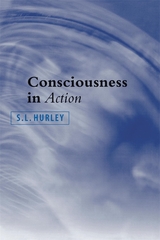 Consciousness in Action
S. L. Hurley
Harvard University Press, 1998 In this important book, Susan Hurley sheds new light on consciousness by examining its relationships to action from various angles. She assesses the role of agency in the unity of a conscious perspective, and argues that perception and action are more deeply interdependent than we usually assume. A standard view conceives perception as input from world to mind and action as output from mind to world, with the serious business of thought in between. Hurley criticizes this picture, and considers how the interdependence of perceptual experience and agency at the personal level (of mental contents and norms) may emerge from the subpersonal level (of underlying causal processes and complex dynamic feedback systems). Her two-level view has wide implications, for topics that include self-consciousness, the modularity of mind, and the relations of mind to world. The self no longer lurks hidden somewhere between perceptual input and behavioral output, but reappears out in the open, embodied and embedded in its environment.
Hurley traces these themes from Kantian and Wittgensteinian arguments through to intriguing recent work in neuropsychology and in dynamic systems approaches to the mind, providing a bridge from mainstream philosophy to work in other disciplines. Consciousness in Action is unique in the range of philosophical and scientific work it draws on, and in the deep criticism it offers of centuries-old habits of thought.
The Consciousness of the Litigator
Duffy Graham
University of Michigan Press, 2005 "An important and thought-provoking addition to the literature on the ethics of lawyers."
---Kimberly Kirkland, Franklin Pierce Law Center
The Consciousness of the Litigator investigates the role of the lawyer in modern American political and social life and in the judicial process, and plumbs lawyers' perceptions of themselves, their work, and, especially, their sense of right and wrong.
In so doing, the book sheds light on the unique and little-examined subject of the moral mind of the litigator, whose work extends to all corners of society and whose primary expertise---making legal arguments---is the fundamental skill of all lawyers.
The Consciousness of the Litigator stands with Michael Kelly's Lives of Lawyers as a must-read for the many law students, scholars, and practicing litigators who struggle to balance ethical questions with the dictates of their highly commercialized profession.
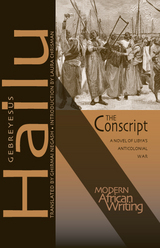 The Conscript: A Novel of Libya’s Anticolonial War
Gebreyesus Hailu
Ohio University Press, 2013 Eloquent and thought-provoking, this classic novel by the Eritrean novelist Gebreyesus Hailu, written in Tigrinya in 1927 and published in 1950, is one of the earliest novels written in an African language and will have a major impact on the reception and critical appraisal of African literature. The Conscript depicts, with irony and controlled anger, the staggering experiences of the Eritrean ascari, soldiers conscripted to fight in Libya by the Italian colonial army against the nationalist Libyan forces fighting for their freedom from Italy’s colonial rule. Anticipating midcentury thinkers Frantz Fanon and Aimé Césaire, Hailu paints a devastating portrait of Italian colonialism. Some of the most poignant passages of the novel include the awakening of the novel’s hero, Tuquabo, to his ironic predicament of being both under colonial rule and the instrument of suppressing the colonized Libyans. The novel’s remarkable descriptions of the battlefield awe the reader with mesmerizing images, both disturbing and tender, of the Libyan landscape—with its vast desert sands, oases, horsemen, foot soldiers, and the brutalities of war—uncannily recalled in the satellite images that were brought to the homes of millions of viewers around the globe in 2011, during the country’s uprising against its former leader, Colonel Gaddafi.
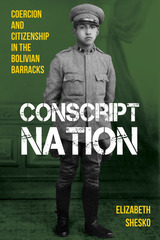 Conscript Nation: Coercion and Citizenship in the Bolivian Barracks
Elizabeth Shesko
University of Pittsburgh Press, 2020 Military service in Bolivia has long been compulsory for young men. This service plays an important role in defining identity, citizenship, masculinity, state formation, and civil-military relations in twentieth-century Bolivia. The project of obligatory military service originated as part of an attempt to restrict the power of indigenous communities after the 1899 civil war. During the following century, administrations (from oligarchic to revolutionary) expressed faith in the power of the barracks to assimilate, shape, and educate the population. Drawing on a body of internal military records never before used by scholars, Elizabeth Shesko argues that conscription evolved into a pact between the state and society. It not only was imposed from above but was also embraced from below because it provided a space for Bolivians across divides of education, ethnicity, and social class to negotiate their relationships with each other and with the state. Shesko contends that state formation built around military service has been characterized in Bolivia by multiple layers of negotiation and accommodation. The resulting nation-state was and is still hierarchical and divided by profound differences, but it never was simply an assimilatory project. It instead reflected a dialectical process to define the state and its relationships.
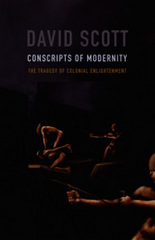 Conscripts of Modernity: The Tragedy of Colonial Enlightenment
David Scott
Duke University Press, 2004 At this stalled and disillusioned juncture in postcolonial history—when many anticolonial utopias have withered into a morass of exhaustion, corruption, and authoritarianism—David Scott argues the need to reconceptualize the past in order to reimagine a more usable future. He describes how, prior to independence, anticolonialists narrated the transition from colonialism to postcolonialism as romance—as a story of overcoming and vindication, of salvation and redemption. Scott contends that postcolonial scholarship assumes the same trajectory, and that this imposes conceptual limitations. He suggests that tragedy may be a more useful narrative frame than romance. In tragedy, the future does not appear as an uninterrupted movement forward, but instead as a slow and sometimes reversible series of ups and downs. Scott explores the political and epistemological implications of how the past is conceived in relation to the present and future through a reconsideration of C. L. R. James’s masterpiece of anticolonial history, The Black Jacobins, first published in 1938. In that book, James told the story of Toussaint L’Ouverture and the making of the Haitian Revolution as one of romantic vindication. In the second edition, published in the United States in 1963, James inserted new material suggesting that that story might usefully be told as tragedy. Scott uses James’s recasting of The Black Jacobins to compare the relative yields of romance and tragedy. In an epilogue, he juxtaposes James’s thinking about tragedy, history, and revolution with Hannah Arendt’s in On Revolution. He contrasts their uses of tragedy as a means of situating the past in relation to the present in order to derive a politics for a possible future.
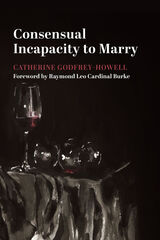 Consensual Incapacity to Marry
Catherine Godfrey-Howell
St. Augustine's Press, 2019 The anthropology that supports marriage perceives justice to be a particular reality, and for this reason marriage will always be a subject of law and of great interest to jurists and sociologists alike. With respect to the realization of justice in marriage, understood as the moment the bond is created, Catholic ecclesiology and canon law articulate an original legal category––namely, the consensual incapacity to marry. In the last fifty years, however, and despite the juridical innovations provided by the current Code of Canon Law promulgated in 1983, American canonical practice in the sphere of marriage law has lost its foundation. The consequences of this include mechanisms of judgment that are rendered incoherent although not inactive, particularly in local tribunals reviewing claims of marriage nullity. In other words, the application of law in the Catholic Church moves forward without a clear indication of its anthropological basis. Canon law, then, on the issue of marriage is perceived to be purposefully oppressive or absolutely meaningless. Jurists, scholars, and members of the Roman Curia acknowledge that, more than a general response to this crisis of law and marriage, what might be needed most is greater scrutiny of the canon in which the formula for consensual incapacity appears. It is furthermore acknowledged that American canonical practice is perhaps the most influential in the world, and is responsible for shaping and sustaining the global attention given to this issue. To fully grasp the crisis and the best way forward, a profile of this canon in American jurisprudence is fundamental and demanded presently. The new course charted by canonical studies and formation of jurists, as well as the new developments in ecclesiastical legislation, will find guidance in this study provided by Catherine Godfrey-Howell, and further insight in the foreword given by the American Cardinal prelate and former Prefect of the Apostolic Signatura, Raymond Leo Cardinal Burke.
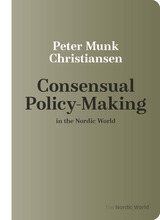 Consensual Policy-making in the Nordic World
Peter Munk Christiansen
University of Wisconsin Press, 2023 This book examines the model developed in the Scandinavian countries for handling labor market relations between employers and employees—a model that has secured flexible and well-functioning labor market relations with comparatively high remuneration in case of sickness or unemployment. Consensual—and comparatively efficient—policies have likewise been pursued in agricultural, industrial, environmental policies, and in many policies related to public services.
The preconditions for these policies are strong civil societies, that is, strong capacities for collective mobilization and collective action among groups, relatively strong unitary states, and high levels of generalized trust. The institutional apparatus of these consensual policies has been labeled corporatism. Scandinavian corporatism has implied consent to a norm of affected interests. Groups that are supposedly affected by state policies have access to the processes leading up to political decision-making and are involved in the implementation of policies. This access often has public commissions or committees charged with preparing political decisions and delivering advice, as well as policy implementation committees.
Corporatist and consensual policymaking come at a price. The exchange between interest groups (in pursuit of policy influence) and state actors (in pursuit of information and political support from groups) tends to be time-consuming and confined to solutions that are accepted by all actors. Corporatist policies are consequently not very conducive to more radical reforms. After the heyday of corporatist policymaking in the 1970s, all the Scandinavian countries have loosened their corporatist structures to pave the way for reforms.
The Consensus of the Church and Papal Infallibility: A Study in the Background of Vatican I
Richard F. Costigan, S.J.
Catholic University of America Press, 2005 After a concise introduction that defines the two schools of theology, Richard Costigan examines the thought of nine major theologians on the subject: Bossuet, Tournely, Orsi, Ballerini, Bailly, Bergier, La Luzerne, Muzzarelli, and Perrone.
Consent and Coercion to Sex and Marriage in Ancient and Medieval Societies
Angeliki E. Laiou
Harvard University Press, 1993 This collection of essays addresses a number of questions regarding the role of consent in marriage and in sexual relations outside of marriage in ancient and medieval societies. Ranging from ancient Greece and Rome to the Byzantine Empire and Western Medieval Europe, the contributors examine rape, seduction, and the role of consent in establishing the punishment of one or both parties; the issue of marital debt and spousal rape; and the central question of what is perceived as coercion and what may be the validity or value of coerced consent. Other concepts, such as honor and shame, are also investigated.
Because of the wide range--in time and place--of societies studied, the reader is able to see many different approaches to the question of consent and coercion as well as a certain evolution, in which Christianity plays an important role.
 The Consent of the Governed: The Lockean Legacy in Early American Culture
Gillian Brown
Harvard University Press, 2001 What made the United States what it is began long before a shot was fired at a redcoat in Lexington, Massachusetts in 1775. It began quietly in homes and schoolrooms across the colonies in the reading lessons women gave to children. Just as the Protestant revolt originated in a practice of individual reading of the Bible, so the theories of reading developed by John Locke were the means by which a revolutionary attitude toward authority was disseminated throughout the British colonies in North America that would come to form in the United States. Gillian Brown takes us back to the basics to understand why Americans value the right to individual self-determination above all other values. It all begins with children.
Locke crucially linked consent with childhood, and it is his formulation of the child's natural right to consent that eighteenth-century Americans learned as they learned to read through Lockean-style pedagogies and textbooks. Tracing the Lockean legacy through the New England Primer and popular readers, fables, and fairy tales, Brown demonstrates how Locke's emphasis on the liberty--and difficulty--of individual judgment became a received notion in the American colonies.
After the revolution, American consent discourse features a different prototype of individuality; instead of wronged children, images of seduced or misguided women predominate postrevolutionary culture. The plights of these women display the difficulties of consent that Locke from the start realized. Individuals continually confront standards and prejudices at odds with their own experiences and judgments. Thus, the Lockean legacy to the United States is the reminder of the continual work to be done to endow every individual with consent and to make consent matter.
What emerged in America was a new and different attitude toward authority in which authority does not belong to the elders but to the upcoming generations and groups. To effect this dramatic a change in the values of humankind took a grassroots revolution. That's what this book is about.
Consent Practices in Performing Arts Education
Edited by Elaine DiFalco Daugherty and Heather Trommer-Beardslee
Intellect Books, 2024 How to bring consent practices to the classroom.
This book explores consent as a foundational principle to guide practices and policies in university-level performing arts education. It includes descriptions of the structural power dynamics present in educational spaces and provides tools for mitigating them. It adapts the consent protocols that are foundational to theatrical intimacy direction and applies them to classroom and rehearsal spaces across performing arts disciplines.
The book discusses consent, opening lines of communication, personal boundaries, and modeling behaviors that respect those boundaries. Additionally, contributors use experiential reflections to address the real-world challenges that teachers face as they work to reshape their teaching habits and processes to include consent practices.
 The Consequences of Counterterrorism
Martha Crenshaw
Russell Sage Foundation, 2010 The 9/11 terrorist attacks opened America's eyes to a frightening world of enemies surrounding us. But have our eyes opened wide enough to see how our experiences compare with other nations' efforts to confront and prevent terrorism? Other democracies have long histories of confronting both international and domestic terrorism. Some have undertaken progressively more stringent counterterrorist measures in the name of national security and the safety of citizens. The Consequences of Counterterrorism examines the political costs and challenges democratic governments face in confronting terrorism. Using historical and comparative perspectives, The Consequences of Counterterrorism presents thematic analyses as well as case studies of Britain, France, Germany, Spain, Japan, and Israel. Contributor John Finn compares post-9/11 antiterrorism legislation in the United States, Europe, Canada, and India to demonstrate the effects of hastily drawn policies on civil liberties and constitutional norms. Chantal de Jonge Oudraat and Jean-Luc Marret assert that terrorist designation lists are more widespread internationally than ever before. The authors examine why governments and international organizations use such lists, how they work, and why they are ineffective tools. Gallya Lahav shows how immigration policy has become inextricably linked to security in the EU and compares the European fear of internal threats to the American fear of external ones. A chapter by Dirk Haubrich explains variation in the British government's willingness to compromise democratic principles according to different threats. In his look at Spain and Northern Ireland, Rogelio Alonso asserts that restricting the rights of those who perpetrate ethnonationalist violence may be acceptable in order to protect the rights of citizens who are victims of such violence. Jeremy Shapiro considers how the French response to terrorist threats has become more coercive during the last fifty years. Israel's "war model" of counterterrorism has failed, Ami Pedahzur and Arie Perliger argue, and is largely the result of the military elite's influence on state institutions. Giovanni Cappocia explains how Germany has protected basic norms and institutions. In contrast, David Leheny stresses the significance of change in Japan's policies. Preventing and countering terrorism is now a key policy priority for many liberal democratic states. As The Consequences of Counterterrorism makes clear, counterterrorist policies have the potential to undermine the democratic principles, institutions, and processes they seek to preserve.
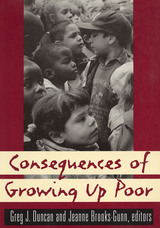 Consequences of Growing Up Poor
Greg J. Duncan
Russell Sage Foundation, 1997 One in five American children now live in families with incomes below the povertyline, and their prospects are not bright. Low income is statistically linked with a variety of poor outcomes for children, from low birth weight and poor nutrition in infancy to increased chances of academic failure, emotional distress, and unwed childbirth in adolescence. To address these problems it is not enough to know that money makes a difference; we need to understand how. Consequences of Growing Up Poor is an extensive and illuminating examination of the paths through which economic deprivation damages children at all stages of their development. In Consequences of Growing Up Poor, developmental psychologists, economists, and sociologists revisit a large body of studies to answer specific questions about how low income puts children at risk intellectually, emotionally, and physically. Many of their investigations demonstrate that although income clearly creates disadvantages, it does so selectively and in a wide variety of ways. Low-income preschoolers exhibit poorer cognitive and verbal skills because they are generally exposed to fewer toys, books, and other stimulating experiences in the home. Poor parents also tend to rely on home-based child care, where the quality and amount of attention children receive is inferior to that of professional facilities. In later years, conflict between economically stressed parents increases anxiety and weakens self-esteem in their teenaged children. Although they share economic hardships, the home lives of poor children are not homogenous. Consequences of Growing Up Poor investigates whether such family conditions as the marital status, education, and involvement of parents mitigate the ill effects of poverty. Consequences of Growing Up Poor also looks at the importance of timing: Does being poor have a different impact on preschoolers, children, and adolescents? When are children most vulnerable to poverty? Some contributors find that poverty in the prenatal or early childhood years appears to be particularly detrimental to cognitive development and physical health. Others offer evidence that lower income has a stronger negative effect during adolescence than in childhood or adulthood. Based on their findings, the editors and contributors to Consequences of Growing Up Poor recommend more sharply focused child welfare policies targeted to specific eras and conditions of poor children's lives. They also weigh the relative need for income supplements, child care subsidies, and home interventions. Consequences of Growing Up Poor describes the extent and causes of hardships for poor children, defines the interaction between income and family, and offers solutions to improve young lives. JEANNE BROOKS-GUNN is Virginia and Leonard Marx Professor of Child Development at Teachers College, Columbia University. She is also director of the Center for Young Children and Families, and co-directs the Adolescent Study Program at Teachers College.
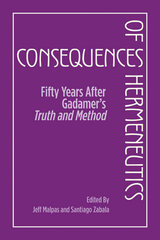 Consequences of Hermeneutics: Fifty Years After Gadamer's Truth and Method
Jeff Malpas
Northwestern University Press, 2010 The publication of Hans-Georg Gadamer’s magnum opus Truth and Method in 1960 marked the arrival of philosophical hermeneutics as a dominant force in philosophy and the humanities as a whole. Consequences of Hermeneutics celebrates the fiftieth anniversary of the publication of one of the most important philosophical works of the twentieth century with essays by most of the leading figures in contemporary hermeneutic theory, including Gianni Vattimo and Jean Grondin. These essays examine the achievements of hermeneutics as well as its current status and prospects for the future. Gadamer’s text provides an important focus, but the ambition of these critical reappraisals extends to hermeneutics more broadly and to a range of other thinkers, such as Heidegger, Ricoeur, Derrida, and Rorty. Forcefully demonstrating the continuing relevance and power of hermeneutics, Consequences of Hermeneutics is a fitting tribute to Gadamer and the legacy of his thought.
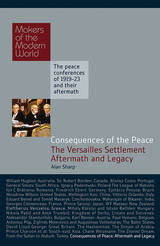 Consequences of Peace: The Versailles Settlement - Aftermath and Legacy
Alan Sharp
Haus Publishing, 2010 Consequences of Peace: The Versailles Settlement - Aftermath and Legacy. This final volume in the Paris Peace Conference series will evaluate the immediate and later effects of the last great peace gathering which sought to settle the world's affairs at a stroke - something that was not attempted after either the Second World War or the Cold War. The Versailles settlement has not enjoyed a great reputation. It has been blamed for causing a second major conflict within a generation, thus apparently fulfilling Marshal Foch's gloomy prediction that "This is not a peace, it is an armistice for twenty years." More recently commentators have suggested that the post-1989 ethnic disturbances in the Balkans and on the fringes of the former Soviet Union are "the old chickens of Versailles coming home to roost." The contemporary world still struggles to come to terms with the implications of President Woodrow Wilson's troublesome principle of national self-determination, and remains embroiled in the ambiguities and complexities of the Middle East, an area for whose boundaries and problems the Great War and settlement bear significant responsibility. We are also still seeking to realise more effectively some of the nobler ambitions of the peacemakers, expressed in the Covenant of the League of Nations, in their concern for the human rights of minority nationalities left on the wrong side of the new borders that they sanctioned, and in their attempt to extend criminal responsibility for war beyond the operational irregularities of combatants to political and military leaders. Ninety years on, the settlement still casts a long shadow.
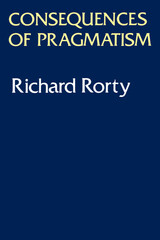 Consequences Of Pragmatism: Essays 1972-1980
Richard Rorty
University of Minnesota Press, 1982 Rorty seeks to tie philosophy’s past to its future by connecting what he sees as the positive (and neglected) contributions of the American pragmatic philosophers to contemporary European developments. What emerges from his explorations is a revivified version of pragmatism that offers new hope for the future of philosophy.“Rorty’s dazzling tour through the history of modern philosophy, and his critical account of its present state (the best general introduction in print), is actually an argument that what we consider perennial problems--mind and body, consciousness and objects, the foundations of knowledge, the fact/value distinction--are merely the dead-ends this picture leads us into.” Los Angeles Times Book Review“It can immediately be said that Consequences of Pragmatism must be read by both those who believe that they agree and those who believe that they disagree with Richard Rorty. [He] is far and away the most provocative philosophical writer working in North America today, and Consequences of Pragmatism should make this claim even stronger.”The Review of Metaphysics“Philosophy, for Rorty, is a form of writing, a literary genre, closer to literary criticism than anything else, a criticism which takes for one of its major concerns the texts of the past recognized as philosophical: it interprets interpretations. If anyone doubts the continued vigor and continuing relevance of American pragmatism, the doubts can be laid to rest by reading this book.” Religious Studies Review
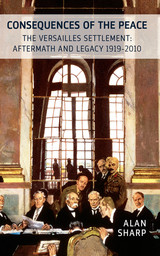 The Consequences of the Peace: The Versailles Settlement: Aftermath and Legacy 1919-2015
Alan Sharp
Haus Publishing, 2015 The Versailles Settlement, at the time of its creation a vital part of the Paris Peace Conference, suffers today from a poor reputation: despite its lofty aim to settle the world’s affairs at a stroke, it is widely considered to have paved the way for a second major global conflict within a generation. Woodrow Wilson’s controversial principle of self-determination amplified political complexities in the Balkans, and the war and its settlement bear significant responsibility for boundaries and related conflicts in today’s Middle East. After almost a century, the settlement still casts a long shadow.
This revised and updated edition of The Consequences of the Peace sets the ramifications of the Paris Peace treaties—for good or ill—within a long-term context. Alan Sharp presents new materials in order to argue that the responsibility for Europe’s continuing interwar instability cannot be wholly attributed to the peacemakers of 1919–23. Marking the centenary of World War I and the approaching centenary of the Peace Conference itself, this book is a clear and concise guide to the global legacy of the Versailles Settlement.
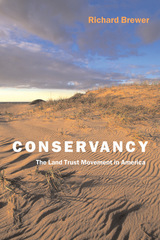 Conservancy: The Land Trust Movement in America
Richard Brewer
Dartmouth College Press, 2004 Land trusts, or conservancies, protect land by owning it. Although many people are aware of a few large land trusts—The Nature Conservancy and the Trust for Public Land, for instance—there are now close to 1,300 local trusts, with more coming into being each month. American land trusts are diverse, shaped by their missions and adapted to their local environments. Nonetheless, all land trusts are private, non-profit organizations for which the acquisition and protection of land by direct action is the primary or sole mission. Nonconfrontational and apolitical, land trusts work with willing land owners in voluntary transactions. Although land trusts are the fastest-growing and most vital part of the land conservation movement today, this model of saving land by private action has become dominant only in the past two decades. Brewer tells why the advocacy model—in which private groups try to protect land by promoting government purchase or regulation— in the 1980s was eclipsed by the burgeoning land trust movement. He gives the public a much-needed primer on what land trusts are, what they do, how they are related to one another and to other elements of the conservation and environmental movements, and their importance to conservation in the coming decades. As Brewer points out, unlike other land-saving measures, land trust accomplishments are permanent. At the end of a cooperative process between a landowner and the local land trust, the land is saved in perpetuity. Brewer’s book, the first comprehensive treatment of land trusts, combines a historical overview of the movement with more specific information on the different kinds of land trusts that exist and the problems they face. The volume also offers a "how-to" approach for persons and institutions interested in donating, selling, or buying land, discusses four major national land trusts (The Nature Conservancy, Trust for Public Land, American Farmland Trust, and Rails-to-Trails Conservancy); and gives a generous sampling of information about the activities and accomplishments of smaller, local trusts nationwide. Throughout, the book is enriched by historical narrative, analysis of successful land trusts, and information on the how and why of protecting land, as well as Brewer’s intimate knowledge of ecological systems, biodiversity, and the interconnectedness of human and non-human life forms. Conservancy is a must-read volume for people interested in land conservation—including land trust members, volunteers and supporters—as well as anyone concerned about land use and the environment.
 Conservation Across Borders: Biodiversity in an Interdependent World
Charles C. Chester
Island Press, 2006 Conservationists have long been aware that political boundaries rarely coincide with natural boundaries. From the establishment of early "peace parks" to the designation of continental migratory pathways, a wide range of transborder mechanisms to protect biodiversity have been established by conservationists in both the public and private sectors.
Conservation Across Borders presents a broad overview of the history of transboundary conservation efforts and an accessible introduction to current issues surrounding the subject. Through detailed examinations of two initiatives, the International Sonoran Desert Alliance (ISDA) and the Yellowstone to Yukon Initiative (Y2Y), the book helps readers understand the benefits and challenges of landscape-scale protection.
In addition to discussing general concepts and the specific experience of ISDA and Y2Y, the author considers the emerging concept of "conservation effectiveness" and offers a comparative analysis of the two projects. The book ends with a discussion of the complex relationships among civil society, governments, and international borders.
By considering the history, goals, successes, and failures of two divergent initiatives, the book offers important insights into the field of transborder conservation along with valuable lessons for those studying or working in the field.
Conservation And The Gospel Of Efficiency: The Progressive Conservation Movement, 1890–1920
Samuel P. Hays
University of Pittsburgh Press, 1999 The relevance and importance of Samuel P. Hay's book, Conservation and the Gospel of Efficiency, has only increased over time. Written almost half a century ago, it offers an invaluable history of the conservation movement's origins, and provides an excellent context for understanding contemporary enviromental problems and possible solutions. Against a background of rivers, forests, ranges, and public lands, this book defines two conflicting political processes: the demand for an integrated, controlled development guided by an elite group of scientists and technicians and the demand for a looser system allowing grassroots impulses to have a voice through elected government representatives.
Conservation and the Gospel of Efficiency: The Progressive Conservation Movement, 1890-1920
Samuel P. Hays
Harvard University Press Many assume that the conservation movement was a part of the population uprising against control by the business community—"the people" versus "the interests." Hays’s special perspective shows that it came about rather as an attempt by scientists and technicians to apply their skills to the development and use of natural resources. The resulting conflicts, far from being concerned with unequal distribution of wealth, were struggles for policy control among groups of resource users.
This book defines two conflicting political processes: the demand for an integrated, controlled development guided by an elite group of scientists and technicians and the demand for looser system allowing grassroots control through elected government representatives.
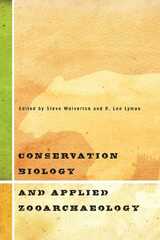 Conservation Biology and Applied Zooarchaeology
Edited by Steve Wolverton and R. Lee Lyman
University of Arizona Press, 2012 Until now, the research of applied zooarchaeologists has not had a significant impact on the work of conservation scientists. This book is designed to show how zooarchaeology can productively inform conservation science. Conservation Biology and Applied Zooarchaeology offers a set of case studies that use animal remains from archaeological and paleontological sites to provide information that has direct implications for wildlife management and conservation biology. It introduces conservation biologists to zooarchaeology, a sub-field of archaeology and ethnobiology, and provides a brief historical account of the development of applied zooarchaeology.
The case studies, which utilize palaeozoological data, cover a variety of animals and environments, including the marine ecology of shellfish and fish, potential restoration sites for Sandhill Cranes, freshwater mussel biogeography and stream ecology, conservation of terrestrial mammals such as American black bears, and even a consideration of the validity of the Pleistocene “rewilding” movement. The volume closes with an important new essay on the history, value, and application of applied zooarchaeology by R. Lee Lyman, which updates his classic 1996 paper that encouraged zooarchaeologists to apply their findings to present-day environmental challenges.
Each case study provides detailed analysis using the approaches of zooarchaeology and concludes with precise implications for conservation biology. Essays also address issues of political and social ecology, which have frequently been missing from the discussions of conservation scientists. As the editors note, all conservation actions occur in economic, social, and political contexts. Until now, however, the management implications of zooarchaeological research have rarely been spelled out so clearly.
 Conservation Biology: Research Priorities For The Next Decade
Edited by Michael E. Soule and Gordon H. Orians; Foreword by P. Dee Boersma
Island Press, 2001 One of the fastest growing scientific disciplines in recent history is conservation biology. A response of the scientific community to the massive environmental changes taking place on Earth, its goal is to enable society to anticipate, prevent, and reduce ecological damage, and to generate the scientific information from which effective conservation strategies and policies can be designed and implemented.In 1989, the Society for Conservation Biology and Island Press produced Research Priorities for Conservation Biology, a slim volume that set forth the findings of experts who had gathered to outline research needs for the near future, and which served as a guidepost for the field throughout the 1990s. In January 2000, leaders of the Society for Conservation Biology convened a similar group to reach consensus on where the field now stands and to determine the major, compelling research priorities for the next decade. Conservation Biology: Research Priorities for the Next Decade presents the results of that gathering.The book: notes progress or changes in the state of global biodiversity over the past decade and discusses overarching themes that influence all areas of conservation offers ten chapters by leading experts that summarize the status of knowledge in key areas ranging from marine conservation to ecological restoration to conservation medicine sets forth research priorities for each area describes gaps in current knowledge that are impeding the ability of conservation practitioners to carry out their workA final synthesis chapter brings together cross-cutting themes that integrate the diverse topics within the context of global biodiversity loss, and presents a call to action for scientists and others working in the field.Conservation Biology: Research Priorities for the Next Decade represents an indispensable guide to the research that is most urgently needed to support effective conservation, and will be must reading for anyone involved with the field of conservation biology.
 Conservation by Proxy: Indicator, Umbrella, Keystone, Flagship, and Other Surrogate Species
Tim Caro
Island Press, 2010 The vast scope of conservation problems has forced biologists and managers to rely on "surrogate" species to serve as shortcuts to guide their decision making. These species-known by a host of different terms, including indicator, umbrella, and flagship species-act as proxies to represent larger conservation issues, such as the location of biodiversity hotspots or general ecosystem health. Synthesizing an immense body of literature, conservation biologist and field researcher Tim Caro offers systematic definitions of surrogate species concepts, explores biological theories that underlie them, considers how surrogate species are chosen, critically examines evidence for and against their utility, and makes recommendations for their continued use. The book clarifies terminology and contrasts how different terms are used in the real world considers the ecological, taxonomic, and political underpinnings of these shortcuts identifies criteria that make for good surrogate species outlines the circumstances where the application of the surrogate species concept shows promise Conservation by Proxy is a benchmark reference that provides clear definitions and common understanding of the evidence and theory behind surrogate species. It is the first book to review and bring together literature on more than fifteen types of surrogate species, enabling us to assess their role in conservation and offering guidelines on how they can be used most effectively.
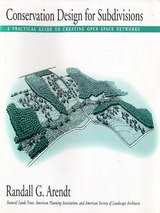 Conservation Design for Subdivisions: A Practical Guide To Creating Open Space Networks
Randall G. Arendt
Island Press, 1996 In most communities, land use regulations are based on a limited model that allows for only one end result: the production of more and more suburbia, composed of endless subdivisions and shopping centers, that ultimately covers every bit of countryside with "improvements." Fortunately, sensible alternatives to this approach do exist, and methods of developing land while at the same time conserving natural areas are available. In Conservation Design for Subdivisions, Randall G. Arendt explores better ways of designing new residential developments than we have typically seen in our communities. He presents a practical handbook for residential developers, site designers, local officials, and landowners that explains how to implement new ideas about land-use planning and environmental protection. Abundantly illustrated with site plans (many of them in color), floor plans, photographs, and renditions of houses and landscapes, it describes a series of simple and straightforward techniques that allows for land-conserving development. The author proposes a step-by-step approach to conserving natural areas by rearranging density on each development parcel as it is being planned so that only half (or less) of the buildable land is turned into houselots and streets. Homes are built in a less land-consumptive manner that allows the balance of property to be permanently protected and added to an interconnected network of green spaces and green corridors. Included in the volume are model zoning and subdivision ordinance provisions that can help citizens and local officials implement these innovative design ideas.
The Conservation Easement in California
Thomas S. Barrett and Putnam Livermore; Trust for Public Land
Island Press, 1983 The conservation easement is an effective and flexible technique for land preservation. The Conservation Easement in California, written by California attorneys expert in conservation law for The Trust for Public Land, is an authoritative legal handbook for the use of conservation easements in California. This book puts the conservation easement in context, discusses the historical and legal background of the conservation easement in California, its state and federal tax implications and the problems involved in drafting easements. Of special importance is the book's clear exposition of the statutory distinction between conservation and open space easements, which should be especially helpful to land trusts and public agencies at all levels who want to put these innovative techniques into practise.
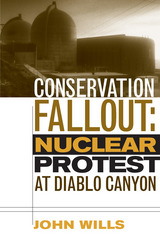 Conservation Fallout: Nuclear Protest At Diablo Canyon
John Wills
University of Nevada Press, 2012 An unprecedented look at nuclear politics in California Vehement, widespread opposition accompanied the rise of the U.S. nuclear industry during the 1960s and 1970s. In Conservation Fallout, John Wills examines one of the most controversial atomic projects of the period: Pacific Gas and Electric Company’s decision to build its premier nuclear power plant at Diablo Canyon, a relatively unsettled, biologically rich, and especially scenic part of the central California coastline. Two competing visions of California emerged while the plant underwent construction. Environmentalists used Diablo as a symbol of impending ecological doomsday, while PG&E envisioned it as the model that would usher in a new age of energy production. The Sierra Club almost disbanded over whether to condone or protest the reactor project. Divisions also emerged in the local community as residents and politicians, enticed by the promise of cheap electricity and lucrative tax revenues, found themselves pitted against others who feared the dangers of radiation in their own backyards. The controversy intensified when a fault line was discovered within three miles of the plant. Grassroots groups The Mothers for Peace, a local women’s group, and The Abalone Alliance, a statewide nonviolent direct-action organization, did their utmost to stop the plant from going on-line. In 1979, an Alliance rally in San Francisco attracted 25,000 people, while 40,000 others gathered in San Luis Obispo. During a two-week-long blockade of the Diablo plant in 1981, over 1,900 activists were jailed, the largest arrest in the history of American antinuclear protest. Despite its significance in the history of twentieth-century environmental issues and the continuing debate over the safety of nuclear power, the full story of Diablo Canyon has not been told until now. Wills bases his account on extensive interviews with the individuals involved, as well as on the archives of the Sierra Club, several protest organizations, public agencies, PG&E, and others. The result is an engaging, balanced examination of nuclear politics in California. By focusing on one of the last wild places in the state and its transformation into a major technological center, and on the evolution and strategies of the little-studied grassroots protest groups determined to protect California and resist the spread of nuclear technology, Wills has made a major contribution to our understanding of America’s nuclear age.
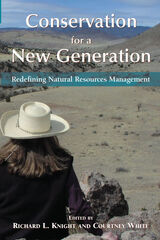 Conservation for a New Generation: Redefining Natural Resources Management
Edited by Richard L. Knight and Courtney White
Island Press, 2008 In hundreds of watersheds and communities across the United States, conservation is being reinvented and invigorated by collaborative efforts between federal, state, and local governments working with nongovernmental organizations and private landowners, and fueled by economic incentives, to promote both healthy natural communities and healthy human communities.
Conservation for a New Generation captures those efforts with chapters that explain the new landscape of conservation along with case studies that illustrate these new approaches. The book brings together leading voices in the field of environmental conservation—Lynne Sherrod, Curt Meine, Daniel Kemmis, Luther Propst, Jodi Hilty, Peter Forbes, and many others—to offer fourteen chapters and twelve case studies that
• demonstrate the benefits of government agencies partnering with diverse stakeholders;
• explore how natural resources management is evolving;
• discuss emerging practices for conservation, including conservation planning, ecological restoration, valuing ecosystem services, and using economic incentives;
• promote cooperation on natural resources issues that have in the past been divisive.
Throughout, contributors focus on the fundamental truth that unites human and land communities: as one prospers, so does the other; as one declines, so too will the other. The book illustrates how natural resources management that emphasizes building strong relationships results in outcomes that are beneficial to both people and land.
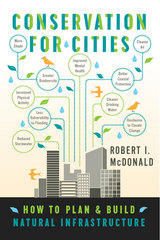 Conservation for Cities: How to Plan & Build Natural Infrastructure
Robert I. McDonald
Island Press, 2015 Urban growth and climate change are reshaping the way cities function—and how they must adapt. As traditional infrastructure struggles to keep pace, forward-thinking planners, engineers, and conservationists are turning to natural systems to help meet urban demands for clean air, safe water, flood protection, and livable neighborhoods.
Conservation for Cities lays out a practical roadmap for weaving nature into the urban fabric. Robert McDonald, a leading scientist at The Nature Conservancy, shows how cities can harness ecosystem services by integrating green and grey infrastructure—from restoring wetlands to cooling heat islands with tree canopy. Through real-world examples, he explains how to identify the most valuable ecosystem services for a given place, weigh tradeoffs, and design cost-effective solutions that work with nature rather than against it.
Each chapter tackles a specific service—stormwater management, water quality, climate regulation, biodiversity, and more—offering insights into policy tools, funding mechanisms, and implementation strategies. For urban planners, landscape architects, engineers, and conservation professionals, Conservation for Cities serves as a clear, actionable guide to building resilient cities with nature at the core.
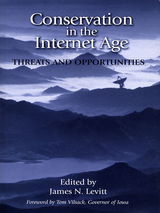 Conservation in the Internet Age: Threats And Opportunities
Edited by James N. Levitt; Foreword by Governor Tom Vilsack
Island Press, 2002 Since the earliest days of our nation, new communications and transportation networks have enabled vast changes in how and where Americans live and work. Transcontinental railroads and telegraphs helped to open the West; mass media and interstate highways paved the way for suburban migration. In our own day, the internet and advanced logistics networks are enabling new changes on the landscape, with both positive and negative impacts on our efforts to conserve land and biodiversity. Emerging technologies have led to tremendous innovations in conservation science and resource management as well as education and advocacy efforts. At the same time, new networks have been powerful enablers of decentralization, facilitating sprawling development into previously undesirable or inaccessible areas. Conservation in the Internet Age offers an innovative, cross-disciplinary perspective on critical changes on the land and in the field of conservation. The book: - provides a general overview of the impact of new technologies and networks
- explores the potentially disruptive impacts of the new networks on open space and biodiversity
- presents case studies of innovative ways that conservation organizations are using the new networks to pursue their missions
- considers how rapid change in the Internet Age offers the potential for landmark conservation initiatives
Conservation in the Internet Age is the first book to examine the links among land use, technology, and conservation from multiple perspectives, and to suggest areas and initiatives that merit further investigation. It offers unique and valuable insight into the challenges facing the land and biodiversity conservation community in the early twenty-first century, and represents an important new work for policymakers, conservation professionals, and academics in planning, design, conservation and resource management, policy, and related fields.
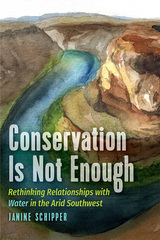 Conservation is not Enough: Rethinking Relationships with Water in the Arid Southwest
Janine Schipper
University of Wyoming Press, 2025 Conservation Is Not Enough reconsiders the most basic assumptions about water issues in the Southwest, revealing why conservation alone will not lead to a sustainable water future. The book undertakes a thorough examination of the prevailing “conservation ethos” deeply ingrained in the culture, critically analyzing its historical roots and shedding light on its problems and inherent limitations. Additionally, it explores deep ecology and an Indigenous water ethos, offering radically different ways of understanding and experiencing water.
Using an exploratory and qualitative approach, the book draws on more than ninety-five interviews conducted over three years, revealing the complex relationships people have with water in the Southwest, and prominently features the voices of participants, effectively illustrating multiple perspectives and diverse ways of thinking about and relating to water. Schipper highlights various perspectives—including a water manager making conservation decisions, a Hopi elder emphasizing our connection to the water cycle, and a ski instructor reflecting on human-made snow—and interweaves personal experiences and reflections on her own relationship with water and conservation efforts.
Conservation Is Not Enough encourages readers to reflect on their personal connections to water and consider new possibilities, and it also urges readers to think beyond conventional conservation approaches. This book helps to transform the collective approach to water and cultivate fresh ways of engaging with and relating to water and is of great interest to scholars, students, and residents concerned with water issues in the Colorado River Basin.
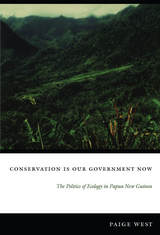 Conservation Is Our Government Now: The Politics of Ecology in Papua New Guinea
Paige West
Duke University Press, 2006 A significant contribution to political ecology, Conservation Is Our Government Now is an ethnographic examination of the history and social effects of conservation and development efforts in Papua New Guinea. Drawing on extensive fieldwork conducted over a period of seven years, Paige West focuses on the Crater Mountain Wildlife Management Area, the site of a biodiversity conservation project implemented between 1994 and 1999. She describes the interactions between those who ran the program—mostly ngo workers—and the Gimi people who live in the forests surrounding Crater Mountain. West shows that throughout the project there was a profound disconnect between the goals of the two groups. The ngo workers thought that they would encourage conservation and cultivate development by teaching Gimi to value biodiversity as an economic resource. The villagers expected that in exchange for the land, labor, food, and friendship they offered the conservation workers, they would receive benefits, such as medicine and technology. In the end, the divergent nature of each group’s expectations led to disappointment for both. West reveals how every aspect of the Crater Mountain Wildlife Management Area—including ideas of space, place, environment, and society—was socially produced, created by changing configurations of ideas, actions, and material relations not only in Papua New Guinea but also in other locations around the world. Complicating many of the assumptions about nature, culture, and development underlying contemporary conservation efforts, Conservation Is Our Government Now demonstrates the unique capacity of ethnography to illuminate the relationship between the global and the local, between transnational processes and individual lives.
 Conservation of Granite in Cultural Heritage
José Delgado Rodrigues
J. Paul Getty Trust, The, 2025 Bridging scholarly research and conservation practice, this volume presents fundamental guidance on the preservation of granite used in built heritage.
The field of stone conservation has long needed a holistic perspective that embraces the needs of conservation professionals and provides scientific support to enable them to better analyze preservation issues and implement efficient, long-lasting treatments. Conservation of Granite in Cultural Heritage offers such a perspective by bridging scholarly research on the available literature related to granite decay and best practices from conservators working in the field and laboratory.
First offering an overview of granitic rocks and their natural weathering, this volume then outlines the issues that arise when removing granite from quarries and incorporating it into what eventually becomes built heritage. Case studies are presented alongside guidelines for assessing conservation problems. This book will serve as a fundamental manual for students, conservation scientists, conservators, and restorers alike.
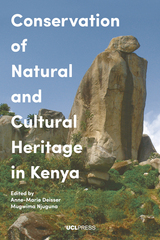 Conservation of Natural and Cultural Heritage in Kenya
Edited by Anne-Marie Deisser and Mugwima Njuguna
University College London, 2016 n Kenya, cultural and natural heritage has a particular value. Its pre-historic heritage not only tells the story of man's origin and evolution but has also contributed to the understanding of the earth's history: fossils and artefacts spanning over 27 million years have been discovered and conserved by the National Museums of Kenya (NMK). Alongside this, the steady rise in the market value of African art has also affected Kenya. Demand for African tribal art has surpassed that for antiquities of Roman, Byzantine, and Egyptian origin, and in African countries currently experiencing conflicts, this activity invariably attracts looters, traffickers and criminal networks. This book brings together essays by heritage experts from different backgrounds, including conservation, heritage management, museum studies, archaeology, environment and social sciences, architecture and landscape, geography, philosophy and economics to explore three key themes: the underlying ethics, practices and legal issues of heritage conservation; the exploration of architectural and urban heritage of Nairobi; and the natural heritage, landscapes and sacred sites in relation to local Kenyan communities and tourism. It thus provides an overview of conservation practices in Kenya from 2000 to 2015 and highlights the role of natural and cultural heritage as a key factor of social-economic development, and as a potential instrument for conflict resolution
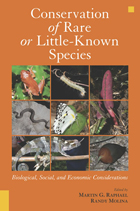 Conservation of Rare or Little-Known Species: Biological, Social, and Economic Considerations
Edited by Martin G. Raphael and Randy Molina
Island Press, 2007 Some ecosystem management plans established by state and federal agencies have begun to shift their focus away from single-species conservation to a broader goal of protecting a wide range of flora and fauna, including species whose numbers are scarce or about which there is little scientific understanding. To date, these efforts have proved extremely costly and complex to implement. Are there alternative approaches to protecting rare or little-known species that can be more effective and less burdensome than current efforts?
Conservation of Rare or Little-Known Species represents the first comprehensive scientific evaluation of approaches and management options for protecting rare or little-known terrestrial species. The book brings together leading ecologists, biologists, botanists, economists, and sociologists to classify approaches, summarize their theoretical and conceptual foundations, evaluate their efficacy, and review how each has been used.
Contributors consider combinations of species and systems approaches for overall effectiveness in meeting conservation and ecosystem sustainability goals. They discuss the biological, legal, sociological, political, administrative, and economic dimensions by which conservation strategies can be gauged, in an effort to help managers determine which strategy or combination of strategies is most likely to meet their needs. Contributors also discuss practical considerations of implementing various strategies.
Conservation of Rare or Little-Known Species gives land managers access to a diverse literature and provides them with the basic information they need to select approaches that best suit their conservation objectives and ecological context. It is an important new work for anyone involved with developing land management or conservation plans.
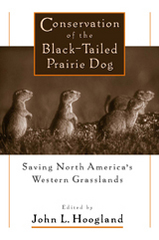 Conservation of the Black-Tailed Prairie Dog: Saving North America's Western Grasslands
Edited by John L. Hoogland
Island Press, 2006 The prairie dog is a colonial, keystone species of the grassland ecosystem of western North America. Myriad animals regularly visit colony-sites to feed on the grass there, to use the burrows for shelter or nesting, or to prey on the prairie dogs. Unfortunately, prairie dogs are disappearing, and the current number is only about 2% of the number encountered by Lewis and Clark in the early 1800s. Part I of Conservation of the Black-Tailed Prairie Dog summarizes ecology and social behavior for pivotal issues such as when prairie dogs breed, how far they disperse, how they affect other organisms, and how much they compete with livestock. Part II documents how loss of habitat, poisoning, plague, and recreational shooting have caused the precipitous decline of prairie dog populations over the last 200 years. Part III proposes practical solutions that can ensure the long-term survival of the prairie dog and its grassland ecosystem, and also are fair to private landowners. We cannot expect farmers and ranchers to bear all the costs of conservation while the rest of us enjoy all the benefits. With 700 references, 37 tables, 75 figures and photographs, and a glossary, Conservation of the Black-Tailed Prairie Dog is a unique and vital contribution for wildlife managers, politicians, environmentalists, and curious naturalists.
 Conservation Paleobiology: Science and Practice
Edited by Gregory P. Dietl and Karl W. Flessa
University of Chicago Press, 2017 In conservation, perhaps no better example exists of the past informing the present than the return of the California condor to the Vermilion Cliffs of Arizona. Extinct in the region for nearly one hundred years, condors were successfully reintroduced starting in the 1990s in an effort informed by the fossil record—condor skeletal remains had been found in the area’s late-Pleistocene cave deposits. The potential benefits of applying such data to conservation initiatives are unquestionably great, yet integrating the relevant disciplines has proven challenging. Conservation Paleobiology gathers a remarkable array of scientists—from Jeremy B. C. Jackson to Geerat J. Vermeij—to provide an authoritative overview of how paleobiology can inform both the management of threatened species and larger conservation decisions.
Studying endangered species is difficult. They are by definition rare, some exist only in captivity, and for those still in their native habitats any experimentation can potentially have a negative effect on survival. Moreover, a lack of long-term data makes it challenging to anticipate biotic responses to environmental conditions that are outside of our immediate experience. But in the fossil and prefossil records—from natural accumulations such as reefs, shell beds, and caves to human-made deposits like kitchen middens and archaeological sites—enlightening parallels to the Anthropocene can be found that might serve as a primer for present-day predicaments. Offering both deep-time and near-time perspectives and exploring a range of ecological and evolutionary dynamics and taxa from terrestrial as well as aquatic habitats, Conservation Paleobiology is a sterling demonstration of how the past can be used to manage for the future, giving new hope for the creation and implementation of successful conservation programs.
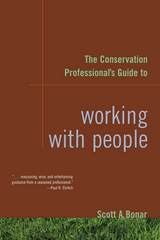 The Conservation Professional's Guide to Working with People
Scott A. Bonar
Island Press, 2007 Successful natural resource management is much more than good science; it requires working with landowners, meeting deadlines, securing funding, supervising staff, and cooperating with politicians. The ability to work effectively with people is as important for the conservation professional as it is for the police officer, the school teacher, or the lawyer. Yet skills for managing human interactions are rarely taught in academic science programs, leaving many conservation professionals woefully unprepared for the daily realities of their jobs. Written in an entertaining, easy-to-read style, The Conservation Professional’s Guide to Working with People fills a gap in conservation education by offering a practical, how-to guide for working effectively with colleagues, funders, supervisors, and the public. The book explores how natural resource professionals can develop skills and increase their effectiveness using strategies and techniques grounded in social psychology, negotiation, influence, conflict resolution, time management, and a wide range of other fields. Examples from history and current events, as well as real-life scenarios that resource professionals are likely to face, provide context and demonstrate how to apply the skills described. The Conservation Professional’s Guide to Working with People should be on the bookshelf of any environmental professional who wants to be more effective while at the same time reducing job-related stress and improving overall quality of life. Those who are already good at working with people will learn new tips, while those who are petrified by the thought of conducting public meetings, requesting funding, or working with constituents will find helpful, commonsense advice about how to get started and gain confidence.
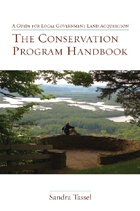 The Conservation Program Handbook: A Guide for Local Government Land Acquisition
Sandra J. Tassel
Island Press, 2009 Between 1996 and 2007, voters approved almost $24 billion for local government park, open space, and other conservation purposes. Despite this substantial sum for land protection, there was at that time no book available to guide officials as they implemented voters’ mandates. The Conservation Program Handbook was written in response to numerous requests to The Trust for Public Land for exactly this type of guidance from community leaders who wanted to know how to effectively conserve their iconic landscapes.
In addition, in November 2008, despite massive doses of terrible financial news, voters across the U.S. approved land conservation funding measures. It was a record-breaking year for land protection financing, with voters demonstrating substantial support for open space ballot measures despite the economic and fiscal crisis of the time.
The Conservation Program Handbook is a manual that provides all of the information—on a broad spectrum of topics—that conservation professionals are likely to encounter. It compiles and distills advice from professionals based on successful conservation efforts across the country, including a list of “best practices” for the most critical issues conservationists can expect to face. By providing information on how to do conservation work in the best possible manner, The Conservation Program Handbook has the goal of increasing the amount, quality, and pace of conservation being achieved by local governments throughout the nation.
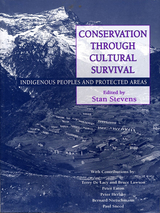 Conservation Through Cultural Survival: Indigenous Peoples And Protected Areas
Edited by Stan Stevens
Island Press, 1997 For more than a century the establishment of national parks and protected areas was a major threat to the survival of indigenous people. The creation of parks based on wilderness ideals outlawed traditional ways of life and forced from their homelands peoples who had shaped and preserved local ecosystems for centuries. Today such tragic conflicts are being superseded by new alliances for conservation. Conservation Through Cultural Survival assesses cutting-edge efforts to establish new kinds of parks and protected areas which are based on partnerships with indigenous peoples. It chronicles new conservation thinking and the establishment around the world of indigenously inhabited protected areas, provides detailed case studies of the most important types of co-managed and indigenously managed areas, and offers guidelines, models, and recommendations for international action. The book: - discusses the goals and development of the global protected area system
- assesses the strengths and limitations of a range of different types of indigenously inhabited protected areas
- discusses key issues and indigenous peoples' concerns
- recommends measures to promote conservation
- suggests international actions that would promote co-managed and indigenously managed areas
Contributors who have been actively involved in projects around the world provide in-depth accounts from Nepal, Australia, New Guinea, Nicaragua, Honduras, Canada, and Alaska of some of the most promising efforts to develop protected areas where indigenous peoples maintain their rights to settlement and subsistence and participate in management. Conservation Through Cultural Survival will be required reading for environmentalists, protected area planners and managers, and all who care about the future of indigenous peoples and their homelands.
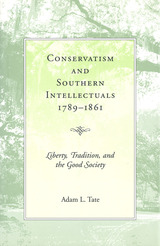 Conservatism and Southern Intellectuals, 1789-1861: Liberty, Tradition, and the Good Society
Adam L. Tate
University of Missouri Press, 2005
In Conservatism and Southern Intellectuals, 1789–1861, Adam L. Tate discusses the nature of southern conservative thought between 1789 and 1861 by examining six conservatives whose lives and careers spanned the antebellum period: John Randolph of Roanoke, John Taylor of Caroline, Nathaniel Beverly Tucker, William Gilmore Simms, Joseph Glover Baldwin, and Johnson Jones Hooper. Tate contends that southern conservatism derived its distinctive characteristics from its acceptance of aspects of John Locke’s political theory as it was articulated during the American Revolution.
Locke argued that the state and society were two entities that could be reformed and manipulated by men. Showing that most southern conservative intellectuals accepted Locke’s premise regarding separation of state and society, Tate examines both the political views and social vision of the six conservatives surveyed. He pays special attention to how these conservatives dealt with states’ rights, republicanism, slavery, sectionalism, and religion, as well as western expansion and migration.
Tate maintains that while southern conservatives forged a common political tradition based on Old Republican interpretations of the Constitution, they did not create a unified tradition of social thought. Even though most of them desired a cohesive southern intellectual movement, as well as a homogenous southern culture, their disagreements over the good society prevented them from creating a common southern social vision to accompany their states’ rights political tradition.
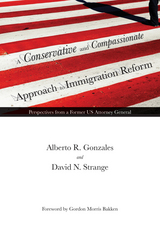 A Conservative and Compassionate Approach to Immigration Reform: Perspectives from a Former US Attorney General
Alberto R. Gonzales
Texas Tech University Press, 2014 A thorough exploration of and compassionate solutions to current U.S. immigration policy
Although the United States is a nation founded by immigrants, Alberto Gonzales and David Strange believe that national immigration policy and enforcement over the past thirty years has been inadequate. This failure by federal leaders has resulted in a widespread introduction of state immigration laws across the country. Gonzales and Strange assert that the solution to current immigration challenges is reform of federal immigration laws, including common sense border control, tougher workplace enforcement, minor (but significant) changes to the Immigration and Nationality Act, and a revised visa process that discourages overstaying the duration of a visa.
Gonzales and Strange embrace many provisions of current pending legislation, but are sharply critical of others. Their proposals call for an expansion of the grounds of inadmissibility to foster greater respect of law and to address the problem of visa overstays, while also calling for a restriction on grounds of inadmissibility in other areas to address the large undocumented population and increasing humanitarian crisis. They explore nationality versus citizenship and introduce a pathway to nationality as an alternative to a pathway to citizenship.
This immigration policy blueprint examines the political landscape in Washington and makes the argument that progress will require compromise and the discipline to act with compassion and respect. Most significantly, it illuminates how following this blueprint can enhance national security and improve the economy in the United States in ways that is consistent with the rule of law.
 The Conservative Ascendancy: How the GOP Right Made Political History
Donald T. Critchlow
Harvard University Press, 2007 Listen to a short interview with Donald CritchlowHost: Chris Gondek | Producer: Heron & Crane
Despite significant losses in the 2006 midterm elections, the Republican Right remains a powerful and defining force in American politics. Donald Critchlow, a leading historian of American conservatism, shows that time and again the GOP Right appeared defeated, only to rebound with explosive force. The ascendancy of the GOP Right was not preordained, nor was its political triumph inevitable. Rather, the history of the postwar Right was one of fierce political warfare as moderate Republicans battled right-wing Republicans for control of their party, and conservatives battled liberals for control of government. In the struggle against the dominant New Deal state, conservatives gained control of the Republican party, but their advance against liberalism and the Democratic party proved less steady. At each point the accident of historical circumstance precluded a predictable outcome.
In this provocative history of the Right in modern America, Critchlow finds a deep dilemma inherent in how conservative Republicans expressed their anti-statist ideology in an age of mass democracy and Cold War hostilities. As the Right moved forward with its political program, partisanship intensified and ideological division widened--both between the parties and across the electorate. This intensified partisanship reflects the vibrancy of a mature democracy, Critchlow argues, and a new level of political engagement despite its disquieting effect on American political debate.
The Conservative Ascendancy boldly captures the twists and turns of the GOP Right over the last sixty years, offering a story of how deeply held beliefs about the nature of the individual and the good society are translated into political power.
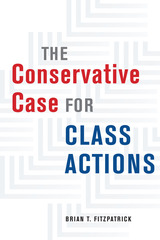 The Conservative Case for Class Actions
Brian T. Fitzpatrick
University of Chicago Press, 2019 Since the 1960s, the class action lawsuit has been a powerful tool for holding businesses accountable. Yet years of attacks by corporate America and unfavorable rulings by the Supreme Court have left its future uncertain. In this book, Brian T. Fitzpatrick makes the case for the importance of class action litigation from a surprising political perspective: an unabashedly conservative point of view.
Conservatives have opposed class actions in recent years, but Fitzpatrick argues that they should see such litigation not as a danger to the economy, but as a form of private enforcement of the law. He starts from the premise that all of us, conservatives and libertarians included, believe that markets need at least some rules to thrive, from laws that enforce contracts to laws that prevent companies from committing fraud. He also reminds us that conservatives consider the private sector to be superior to the government in most areas. And the relatively little-discussed intersection of those two beliefs is where the benefits of class action lawsuits become clear: when corporations commit misdeeds, class action lawsuits enlist the private sector to intervene, resulting in a smaller role for the government, lower taxes, and, ultimately, more effective solutions.
Offering a novel argument that will surprise partisans on all sides, The Conservative Case for Class Actions is sure to breathe new life into this long-running debate.
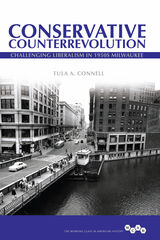 Conservative Counterrevolution: Challenging Liberalism in 1950s Milwaukee
Tula A. Connell
University of Illinois Press, 2016 In the 1950s, Milwaukee's strong union movement and socialist mayor seemed to embody a dominant liberal consensus that sought to continue and expand the New Deal. Tula Connell explores how business interests and political conservatives arose to undo that consensus, and how the resulting clash both shaped a city and helped redefine postwar American politics. Connell focuses on Frank Zeidler, the city's socialist mayor. Zeidler's broad concept of the public interest at times defied even liberal expectations. At the same time, a resurgence of conservatism with roots presaging twentieth-century politics challenged his initiatives in public housing, integration, and other areas. As Connell shows, conservatives created an anti-progressive game plan that included a well-funded media and PR push; an anti-union assault essential to the larger project of delegitimizing any government action; opposition to civil rights; and support from a suburban silent majority. In the end, the campaign undermined notions of the common good essential to the New Deal order. It also sowed the seeds for grassroots conservatism's more extreme and far-reaching future success.
 The Conservative Foundations of the Liberal Order: Defending Democracy Against Its Modern Enemies
Daniel J. Mahoney
Intercollegiate Studies Institute, 2010 Saving Democracy from Its Enemies— from Itself
Western democracy has become increasingly estranged from its crucial historical, political, spiritual, and cultural prerequisites— what author Daniel J. Mahoney calls “the conservative foundations of the liberal order.” In this eloquent and insightful work of political philosophy and cultural criticism, Mahoney offers a vigorous defense of these foundations, and shows the dangers of identifying liberty with a radical project of social and cultural emancipation.
The Conservative Foundations of the Liberal Order takes particular aim at partisans of “pure democracy,” who have transformed the principles of liberty and equality into an unreflective dogma. By reducing liberty to a vague affirmation of equality and individual autonomy, Mahoney shows, such partisans undermine those “contents of life” —, patriotism, philosophical reflection, family and social life— enrich human existence and give purpose to human freedom. What we need instead is a conservative-minded liberalism.
Calling on the wisdom of Winston Churchill, Edmund Burke, Alexis de Tocqueville, Aleksandr Solzhenitsyn, Raymond Aron, and other exemplary leaders and thinkers, Mahoney addresses a wide range of questions related to liberty in the contempo1rary world. He brilliantly analyzes the task of the democratic statesman; the need for prudence, sobriety, and civic courage in confronting the totalitarian enemies of the West; the ties that bind religion and democratic liberty; democracy’s tendency to squander its own inheritance in frenzied efforts to establish a human order that is more and more “democratic”; the follies of the postmodern “culture of repudiation”; the reasons so many intellectuals indulge totalitarianism and terrorism; and much more.
Rejecting the dual temptations of utopianism and despair, Mahoney defends self-government— understood— both democracy’s enemies and its all-too-numerous “immoderate friends.” The Conservative Foundations of the Liberal Order upholds the rich civilized inheritance that allows human beings to lead free and decent lives together.
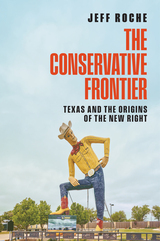 The Conservative Frontier: Texas and the Origins of the New Right
Jeff Roche
University of Texas Press, 2025 How West Texas business and culture molded the rise of conservatism in the United States. Much of what we understand as modern American political conservatism was born in West Texas, where today it predominates. How did the people of such a vast region—larger than New England and encompassing big cities like Lubbock and Amarillo, as well as tiny towns from Anson to Dalhart—develop such a uniform political culture? And why and how did it go national? Jeff Roche finds answers in the history of what he calls cowboy conservatism. Political power players matter in this story, but so do football coaches, newspaper editors, and a breakfast cereal tycoon who founded a capitalist utopia. The Conservative Frontier follows these and other figures as they promoted an ideology grounded in the entrepreneurial and proto-libertarian attitudes of nineteenth-century Texas ranchers, including a fierce devotion to both individualism and small-town notions of community responsibility. This political sensibility was in turn popularized by its association with the mythology and iconography of the cowboy as imagined in twentieth-century mass media. By the 1970s and the rise of Ronald Reagan, Roche shows, it was clear that the cowboy conservatism of West Texas had set the stage for the emergence of the New Right—the more professionalized and tech-savvy operation that dominated national conservative politics for the next quarter century.
 Conservative Ideology in the Making
Ivan Zoltan Denes
Central European University Press, 2009 The fifty years or so preceding the watershed of 1848–49 witnessed the emergence of liberal nationalism in Hungary, along with a transmutation of conservatism which appeared then as a party and an ideological system in the political arena. The specific features of the conservatism, combining the protection of the status quo with some reform measures, its strategic vision, conceptual system, argumentation, assessment criteria and values require an in depth exploration and analysis. Different conservative groups were in the background or in opposition from 1848 to 1918, while in the period between the two World Wars, they constituted the overwhelming majority of ruling parties. During the one-party system, from 1949 to 1989, the liberals and conservatives—like all other political groups—were illegal, a status from which they could later emerge upon the change of the political system. The inheritance of the autocratic system frozen up and undigested by the one-party state was thawed after the peaceful regime change, the constitutional revolution and its discrete components began to be reactivated, including the enemy images of earlier discourses. "Liberal" and "conservative" had become state-party stigmas in line with fascist, reactionary, rightist, and bourgeois. In reaction to that, at first conservative then liberal, intellectual fashions and renascences unfolded in the 1980s. The attempts by liberal and conservative advocates to find predecessors did not favor an objective approach.The first step toward objectivity is establishing distance from the different kinds of enemy images and their political idioms. This is a pressing need because, although several pioneering works have appeared on different variants of the Hungarian liberalisms and conservatisms, there are no serious unbiased syntheses. This work is urgent because the political poles of the constitutional revolution and the ensuing period have up till now been described in terms of different conspiracy theories.
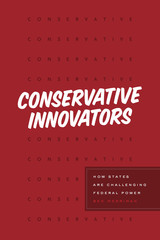 Conservative Innovators: How States Are Challenging Federal Power
Ben Merriman
University of Chicago Press, 2019 As American politics has become increasingly polarized, gridlock at the federal level has led to a greater reliance on state governments to get things done. But this arrangement depends a great deal on state cooperation, and not all state officials have chosen to cooperate. Some have opted for conflict with the federal government.
Conservative Innovators traces the activity of far-right conservatives in Kansas who have in the past decade used the powers of state-level offices to fight federal regulation on a range of topics from gun control to voting processes to Medicaid. Telling their story, Ben Merriman then expands the scope of the book to look at the tactics used by conservative state governments across the country to resist federal regulations, including coordinated lawsuits by state attorneys general, refusals to accept federal funds and spending mandates, and the creation of programs designed to restrict voting rights. Through this combination of state-initiated lawsuits and new administrative practices, these state officials weakened or halted major parts of the Obama Administration’s healthcare, environmental protection, and immigration agendas and eroded federal voting rights protections. Conservative Innovators argues that American federalism is entering a new, conflict-ridden era that will make state governments more important in American life than they have been at any time in the past century.
 Conservative Intellectual Movement: In America Since 1945
George H. Nash
Intercollegiate Studies Institute, 1998 In this revised and updated edition of what Insight magazine recently called "the standard work" on the history of post-World War II American Conservatism, Nash shows how a diverse group of men became an effective intellectual force in American life.
What They're Saying...
"The Conservative Intellectual Movement in America, since 1945 remains since its publication in 1976 the most comprehensive treatment."
-- Choice
"Thorough and scholarly, The Conservative Intellectual Movement in America, since 1945 is a masterpiece of orchestration, skillfully handling a huge literature, drawing on historical events and the conservative thinkers' personalities…"
-- The Social Critic
"Nash's seminal book will remind today's hotheads that the modern conservative movement was made possible by a coalition of traditionalists and libertarians with enough common goals to get along splendidly. Is the corrupt liberal state not enough to keep this unity intact?"
-- The American Spectator
"As always, [Nash's] treatment is evenly balanced and scrupulously fair. Conservatives of all persuasions can be grateful to have George Nash as their historian."
-- First Things
"Today, it is the single best source of information on the intellectuals who built modern American conservatism."
-- Amazon.com, Expert Editor's Recommended Book
The Conservative Intellectual Movement in America Since 1945
George H. Nash
Intercollegiate Studies Institute, 2006
First published in 1976, and revised in 1996, George H. Nash’s celebrated history of the postwar conservative intellectual movement has become the unquestioned standard in the field. This new edition, published in commemoration of the volume’s thirtieth anniversary, includes a new preface by Nash and will continue to instruct anyone interested in how today’s conservative movement was born.
The Conservative Resurgence and the Press: The Media's Role in the Rise of the Right
James Brian McPherson
Northwestern University Press, 2008 Consumers of American media find themselves in a news world that has shifted toward more conservative reporting. This book takes a measured, historical view of the shift, addressing factors that include the greater skill with which conservatives have used the media, the media’s gradual trend toward conservatism, the role of religion, and the effects of media conglomeration. The book makes the case that the media have managed to not only enable today’s conservative resurgence but also ignore, largely, the consequences of that change for the American people.
 Conservative Thought in Twentieth Century Latin America: The Ideas of Laureano Gomez
James D. Henderson
Ohio University Press, 1988 Laureano Gómez was president of Colombia in the early 1950s until overthrown by a military coup. He was also, for some fifty years, the leading exponent of Latin American conservatism, a political philosophy with roots in both nineteenth–century politics and religion. Focusing on Gómez, and other prominent conservative politicians, Henderson traces the evolution of Latin American conservatism and demonstrates the scope of its influence throughout the continent. While much has been written about particular Marxist movements and right–wing regimes in contemporary Latin America, little attention has been devoted, in recent years, to the more moderate political institutions and individuals which dominate twentieth–century Latin America. This first account of Latin American conservatism should be of interest to all students of the history and politics of the region.
 The Conservative Turn: Lionel Trilling, Whittaker Chambers, and the Lessons of Anti-Communism
Michael Kimmage
Harvard University Press, 2009 The Conservative Turn tells the story of postwar America’s political evolution through two fascinating figures: Lionel Trilling and Whittaker Chambers. Born at the turn of the twentieth century, they were college classmates who went on to intellectual prominence, sharing the questions, crises, and challenges of their generation.
A spy for the Soviet Union in the 1930s, Chambers became the main witness in the 1948 trial of Alger Hiss, which ended in Hiss’s conviction for perjury. The trial advanced the careers of Richard Nixon and Joseph McCarthy and marked the beginning of the Cold War mood in America. Chambers was also a major conservative thinker, a theorist of the postwar conservative movement.
Meanwhile, in the 1940s and 1950s, the literary critic Trilling wrote important essays that encouraged liberals to disown their radical past and to embrace a balanced maturity. Trilling’s liberal anti-communism was highly influential, culminating politically in the presidency of John F. Kennedy.
Kimmage argues that the divergent careers of these two men exemplify important developments in postwar American politics: the emergence of modern conservatism and the rise of moderate liberalism, crucially shaped by anti-communism. Taken together, these developments constitute a conservative turn in American political and intellectual life—a turn that continues to shape America’s political landscape.
 Conserving Active Matter
Edited by Peter N. Miller and Soon Kai Poh
Bard Graduate Center, 2022 Considers the future of conservation and its connection to the human sciences.
This volume brings together the findings from a five-year research project that seeks to reimagine the relationship between conservation knowledge and the humanistic study of the material world. The project, “Cultures of Conservation,” was supported by the Andrew W. Mellon Foundation and included events, seminars, and an artist-in-residence.
The effort to conserve things amid change is part of the human struggle with the nature of matter. For as long as people have made things and kept things, they have also cared for and repaired them. Today, conservators use a variety of tools and categories developed over the last one hundred and fifty years to do this work, but in the coming decades, new kinds of materials and a new scale of change will pose unprecedented challenges. Looking ahead to this moment from the perspectives of history, philosophy, materials science, and anthropology, this volume explores new possibilities for both conservation and the humanities in the rethinking of active matter.
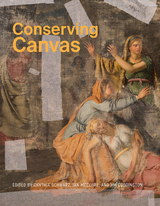 Conserving Canvas
Cynthia Schwarz
J. Paul Getty Trust, The, 2023 The most authoritative publication in nearly fifty years on the subject of conserving paintings on canvas.
In 2019, Yale University, with the support of the Getty Foundation, held an international conference, where nearly four hundred attendees from more than twenty countries gathered to discuss a vital topic: how best to conserve paintings on canvas. It was the first major symposium on the subject since 1974, when wax-resin and glue-paste lining reigned as the predominant conservation techniques. Over the past fifty years, such methods, which were often destructive to artworks, have become less widely used in favor of more minimalist approaches to intervention. More recent decades have witnessed the reevaluation of traditional practices as well as focused research supporting significant new methodologies, procedures, and synthetic materials for the care and conservation of paintings on fabric supports.
Conserving Canvas compiles the proceedings of the conference, presenting a wide array of papers and posters that provide important global perspectives on the history, current state, and future needs of the field. Featuring an expansive glossary of terms that will be an invaluable resource for conservators, this publication promises to become a standard reference for the international conservation community.
The free online edition of this open-access publication is available at getty.edu/publications/conserving-canvas. Also available are free PDF and EPUB downloads of the book.
Conserving Culture: A NEW DISCOURSE ON HERITAGE
Edited by Mary Hufford
University of Illinois Press, 1994 Conserving Culture examines
heritage protection in the United States and how it has been implemented in
specific cases. Contributors challenge the division of heritage into nature,
the built environment, and culture. They describe cultural conservation as an
integrated process for resource planning and recommend supplanting the current
prescriptive approach with one that is more responsive to grass-roots cultural
concerns.
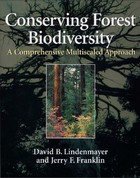 Conserving Forest Biodiversity: A Comprehensive Multiscaled Approach
David B. Lindenmayer and Jerry F. Franklin
Island Press, 2002 While most efforts at biodiversity conservation have focused primarily on protected areas and reserves, the unprotected lands surrounding those area—the "matrix"—are equally important to preserving global biodiversity and maintaining forest health. In Conserving Forest Biodiversity, leading forest scientists David B. Lindenmayer and Jerry F. Franklin argue that the conservation of forest biodiversity requires a comprehensive and multiscaled approach that includes both reserve and nonreserve areas. They lay the foundations for such a strategy, bringing together the latest scientific information on landscape ecology, forestry, conservation biology, and related disciplines as they examine: - the importance of the matrix in key areas of ecology such as metapopulation dynamics, habitat fragmentation, and landscape connectivity
- general principles for matrix management
- using natural disturbance regimes to guide human disturbance
- landscape-level and stand-level elements of matrix management
- the role of adaptive management and monitoring
- social dimensions and tensions in implementing matrix-based forest management
In addition, they present five case studies that illustrate aspects and elements of applied matrix management in forests. The case studies cover a wide variety of conservation planning and management issues from North America, South America, and Australia, ranging from relatively intact forest ecosystems to an intensively managed plantation. Conserving Forest Biodiversity presents strategies for enhancing matrix management that can play a vital role in the development of more effective approaches to maintaining forest biodiversity. It examines the key issues and gives practical guidelines for sustained forest management, highlighting the critical role of the matrix for scientists, managers, decisionmakers, and other stakeholders involved in efforts to sustain biodiversity and ecosystem processes in forest landscapes.
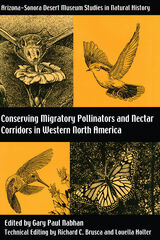 Conserving Migratory Pollinators and Nectar Corridors in Western North America
Gary Paul Nabhan
University of Arizona Press, 2004 When migrating birds and other creatures move along a path of plant communities in bloom, they follow what has come to be known as a nectar trail. Should any of these plants be eliminated from the sequence—whether through habitat destruction, pests, or even aberrant weather—the movement of these pollinators may be interrupted and their very survival threatened. In recent efforts by ecologists and activists to envision a continental-scale network of protected areas connected by wildlife corridors, the peculiar roles of migratory pollinators which travel the entire length of this network cannot be underestimated in shaping the ultimate conservation design.
This book, a unique work of comparative zoogeography and conservation biology, is the first to bring together studies of these important migratory pollinators and of what we must do to conserve them. It considers the similarities and differences among the behavior and habitat requirements of several species of migratory pollinators and seed dispersers in the West—primarily rufous hummingbirds, white-winged doves, lesser long-nosed bats, and monarch butterflies. It examines the population dynamics of these four species in flyways that extend from the Pacific Ocean to the continental backbone of the Sierra Madre Oriental and Rocky Mountains, and it investigates their foraging and roosting behaviors as they journey from the Tropic of Cancer in western Mexico into the deserts, grasslands, and thornscrub of the U.S.-Mexico borderlands. The four pollinators whose journeys are traced here differ dramatically from one another in foraging strategies and stopover fidelities, but all challenge many of the truisms that have emerged regarding the status of migratory species in general. The rufous hummingbird makes the longest known avian migration in relation to body size and is a key to identifying nectar corridors running through northwestern Mexico to the United States. And there is new evidence to challenge the long-supposed separation of eastern and western monarch butterfly populations by the Rocky Mountains as these insects migrate.
Conserving Migratory Pollinators and Nectar Corridors in Western North America demonstrates new efforts to understand migratory species and to determine whether their densities, survival rates, and health are changing in response to changes in the distribution and abundance of nectar plants found within their ranges. Representing collaborative efforts that bridge field ecology and conservation biology in both theory and practice, it is dedicated to safeguarding dynamic interactions among plants and pollinators that are only now being identified.
 Conserving Nature in Greater Yellowstone: Controversy and Change in an Iconic Ecosystem
Robert B. Keiter
University of Chicago Press, 2025 The story of how Yellowstone, established in 1872 as the world’s first national park, has become synonymous with nature conservation—and an examination of today’s challenges to preserve the region’s wilderness heritage.
For more than 150 years, the Yellowstone region—now widely known as the twenty-three million acre Greater Yellowstone Ecosystem—has played a prominent role in the United States’ nature conservation agenda. In this book, Robert B. Keiter, an award-winning public land law and policy expert, traces the evolution and application of fundamental ecological conservation concepts tied to Yellowstone.
Keiter’s book highlights both the conservation successes and controversies connected with this storied region, which has been enmeshed in change. During the 1980s, leaders in Yellowstone embraced ecosystem management concepts to recover a dwindling grizzly bear population and to support wolf reintroduction. Since then, management policies in the region’s two national parks and adjacent national forests have largely followed suit, prioritizing ecosystem-level conservation over industrial activity. Groundbreaking efforts are currently afoot to protect elk, deer, and pronghorn migration corridors and to maintain the park’s bison population, effectively expanding the scope of regional conservation initiatives. But in the face of explosive human population growth and related development pressures, new efforts must also account for the region’s privately owned lands along with accelerating recreational activities that present quite different problems.
Indeed, the Greater Yellowstone Ecosystem—extending across three states and twenty counties and embracing more than sixteen million acres of federal land as well as private and tribal lands —can only be characterized as a complex, jurisdictionally fragmented landscape. As Keiter makes clear, the quest for common ground among federal land managers, state officials, local communities, conservationists, ranchers, Indigenous tribes, and others is a vital, enduring task.
Exploring both notable conservation accomplishments and the ongoing challenges confronting this special place, Keiter’s book explains the many forces—scientific, political, economic, legal, cultural, climatic, and more—at work driving controversy and change across the region. But more than this, Conserving Nature in Greater Yellowstone shows us that the lessons gleaned from Yellowstone’s expansive nature conservation efforts are profoundly important for both the country and the world.
 Conserving Nature in Greater Yellowstone: Controversy and Change in an Iconic Ecosystem
Robert B. Keiter
University of Chicago Press, 2025 This is an auto-narrated audiobook version of this book.
The story of how Yellowstone, established in 1872 as the world’s first national park, has become synonymous with nature conservation—and an examination of today’s challenges to preserve the region’s wilderness heritage.
For more than 150 years, the Yellowstone region—now widely known as the twenty-three million acre Greater Yellowstone Ecosystem—has played a prominent role in the United States’ nature conservation agenda. In this book, Robert B. Keiter, an award-winning public land law and policy expert, traces the evolution and application of fundamental ecological conservation concepts tied to Yellowstone.
Keiter’s book highlights both the conservation successes and controversies connected with this storied region, which has been enmeshed in change. During the 1980s, leaders in Yellowstone embraced ecosystem management concepts to recover a dwindling grizzly bear population and to support wolf reintroduction. Since then, management policies in the region’s two national parks and adjacent national forests have largely followed suit, prioritizing ecosystem-level conservation over industrial activity. Groundbreaking efforts are currently afoot to protect elk, deer, and pronghorn migration corridors and to maintain the park’s bison population, effectively expanding the scope of regional conservation initiatives. But in the face of explosive human population growth and related development pressures, new efforts must also account for the region’s privately owned lands along with accelerating recreational activities that present quite different problems.
Indeed, the Greater Yellowstone Ecosystem—extending across three states and twenty counties and embracing more than sixteen million acres of federal land as well as private and tribal lands —can only be characterized as a complex, jurisdictionally fragmented landscape. As Keiter makes clear, the quest for common ground among federal land managers, state officials, local communities, conservationists, ranchers, Indigenous tribes, and others is a vital, enduring task.
Exploring both notable conservation accomplishments and the ongoing challenges confronting this special place, Keiter’s book explains the many forces—scientific, political, economic, legal, cultural, climatic, and more—at work driving controversy and change across the region. But more than this, Conserving Nature in Greater Yellowstone shows us that the lessons gleaned from Yellowstone’s expansive nature conservation efforts are profoundly important for both the country and the world.
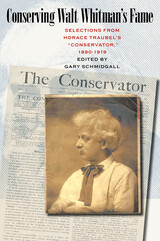 Conserving Walt Whitman's Fame: Selections from Horace Traubel's Conservator, 1890-1919
Schmidgall, Gary
University of Iowa Press, 2006 It is now difficult to imagine that, in the years before Whitman's death in 1892, there was real doubt in the minds of Whitman and his literary circle whether Leaves of Grass would achieve lasting fame. Much of the critical commentary in the first decade after his burial in Camden was as negative as that in Boston's Christian Register, which spoke of Whitman as someone who “succeeded in writing a mass of trash without form, rhythm, or vitality.”That the balance finally tipped toward admiration, culminating in Whitman's acceptance into the literary canon, was due substantially to the unflagging labor of Horace Traubel, famous for his nine volumes of Whitman conversations but less well known for his provocative monthly journal of socialist politics and avant-garde culture, the Conservator.Conserving Walt Whitman's Fame offers a generous selection from the enormous trove of Whitman-related materials that Traubel included in the 352 issues of the Conservator. Among the revelatory, perceptive, and often entertaining items presented here are the most illuminating of the Conservator's more than 150 topical essays on Whitman and memoirs by many of his friends and literary cohorts that shed new light on the poet, his work, and his critical reception. Also important is the richer understanding these pages afford of Horace Traubel's own sophisticated, deeply humane, and feisty views of America.
Considerations for Integrating Women into Closed Occupations in U.S. Special Operations Forces
Thomas S. Szayna
RAND Corporation, 2015 Integrating women into special operations forces poses potential challenges for unit cohesion. The integration of women raises issues of effectiveness, in terms of physical standards and ensuring the readiness, cohesion, and morale essential to high-performing teams. This report assesses those challenges and provides analytical support for validating occupational standards for positions controlled by U.S. Special Operations Command.
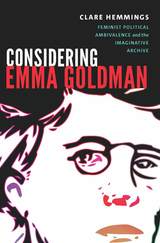 Considering Emma Goldman: Feminist Political Ambivalence and the Imaginative Archive
Clare Hemmings
Duke University Press, 2018 In Considering Emma Goldman Clare Hemmings examines the significance of the anarchist activist and thinker for contemporary feminist politics. Rather than attempting to resolve the tensions and problems that Goldman's thinking about race, gender, and sexuality pose for feminist thought, Hemmings embraces them, finding them to be helpful in formulating a new queer feminist praxis. Mining three overlapping archives—Goldman's own writings, her historical and theoretical legacy, and an imaginative archive that responds creatively to gaps in those archives —Hemmings shows how serious engagement with Goldman's political ambivalences opens up larger questions surrounding feminist historiography, affect, fantasy, and knowledge production. Moreover, she explores her personal affinity for Goldman to illuminate the role that affective investment plays in shaping feminist storytelling. By considering Goldman in all her contradictions and complexity, Hemmings presents a queer feminist response to the ambivalences that also saturate contemporary queer feminist race theories.
Considering Marijuana Legalization: Insights for Vermont and Other Jurisdictions
Jonathan P. Caulkins
RAND Corporation, 2015 Marijuana legalization is a controversial and multifaceted issue that is now the subject of serious debate. In May 2014, Vermont Governor Peter Shumlin signed a bill requiring the Secretary of Administration to produce a report about various consequences of legalizing marijuana. This resulting report provides a foundation for thinking about the various consequences of different policy options while being explicit about the uncertainties involved.
 Considering Maus: Approaches to Art Spiegelman's "Survivor's Tale" of the Holocaust
Deborah R. Geis
University of Alabama Press, 2007 The first collection of critical essays on Maus, the searing account of one Holocaust survivor's experiences rendered in comic book form. In 1992, Art Spiegelmans two-volume illustrated work Maus: A Survivor’s Tale was awarded a special-category Pulitzer Prize. In a comic book form, Spiegelman tells the gripping, heart-rending story of his father's experiences in the Holocaust. The book renders in stark clarity the trials Spiegelman's father endured as a Jewish refugee in the ghettos and concentration camps of Poland during World War II, his American life following his immigration to New York, and the author's own troubled sense of self as he grapples with his father's history. Mixing autobiography, biography, and oral history in the comic form, Maus has been hailed as a daring work of postmodern narration and as a vivid example of the power of the graphic narrative.
Now, for the first time in one collection, prominent scholars in a variety of fields take on Spiegelman's text and offer it the critical and artistic scrutiny it deserves. They explore many aspects of the work, including Spiegelman’s use of animal characters, the influence of other "comix" artists, the role of the mother and its relation to gender issues, the use of repeating images such as smoke and blood, Maus's position among Holocaust testimonials, its appropriation of cinematic technique, its use of language and styles of dialect, and the implications of the work’s critical and commercial success.
Informed readers in many areas of study, from popular culture and graphic arts to psychoanalysis and oral history, will value this first substantial collection of criticism on a revered work of literature.
Considering Students, Teachers, and Writing Assessment, Vol. 1: Technical and Political Contexts
Diane Kelly-Riley
University Press of Colorado, 2024 The editors and authors in this edited collection, available in two volumes, consider the increasing importance of students’ and teachers’ lived experiences within the development and use of writing assessments. Presenting key work published in The Journal of Writing Assessment since its founding in 2003, the collection explores five major themes: technical psychometric issues; politics and public policies shaping large scale writing assessments; automated scoring of writing; fairness; and the lived experiences of humans involved in assessment ecologies. The books also provide reflections from leading writing assessment scholars who examine how these themes continue to shape current and future directions in writing assessment.
Considering Students, Teachers, and Writing Assessment, Vol 2: Emerging Theoretical and Pedagogical Practice
Diane Kelly-Riley
University Press of Colorado, 2024 The editors and authors in this edited collection, available in two volumes, consider the increasing importance of students’ and teachers’ lived experiences within the development and use of writing assessments. Presenting key work published in The Journal of Writing Assessment since its founding in 2003, the collection explores five major themes: technical psychometric issues; politics and public policies shaping large scale writing assessments; automated scoring of writing; fairness; and the lived experiences of humans involved in assessment ecologies. The books also provide reflections from leading writing assessment scholars who examine how these themes continue to shape current and future directions in writing assessment.
 Considering Watchmen: Poetics, Property, Politics
Hoberek, Andrew
Rutgers University Press, 2014 Alan Moore and Dave Gibbons’s Watchmen has been widely hailed as a landmark in the development of the graphic novel. It was not only aesthetically groundbreaking but also anticipated future developments in politics, literature, and intellectual property.
Demonstrating a keen eye for historical detail, Considering Watchmen gives readers a new appreciation of just how radical Moore and Gibbons’s blend of gritty realism and formal experimentation was back in 1986. The book also considers Watchmen’s place in the history of the comics industry, reading the graphic novel’s playful critique of superhero marketing alongside Alan Moore’s public statements about the rights to the franchise. Andrew Hoberek examines how Moore and Gibbons engaged with the emerging discourses of neoconservatism and neoliberal capitalism, ideologies that have only become more prominent in subsequent years.
Watchmen’s influences on the superhero comic and graphic novel are undeniable, but Hoberek reveals how it has also had profound effects on literature as a whole. He suggests that Watchmen not only proved that superhero comics could rise to the status of literature—it also helped to inspire a generation of writers who are redefining the boundaries of the literary, from Jonathan Lethem to Junot Díaz. Hoberek delivers insight and analysis worthy of satisfying serious readers of the genre while shedding new light on Watchmen as both an artistic accomplishment and a book of ideas.
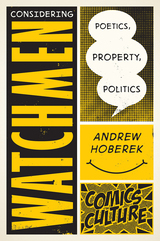 Considering Watchmen: Poetics, Property, Politics: New edition with full color illustrations
Hoberek, Andrew
Rutgers University Press, 2017 Alan Moore and Dave Gibbons’s Watchmen has been widely hailed as a landmark in the development of the graphic novel. It was not only aesthetically groundbreaking but also anticipated future developments in politics, literature, and intellectual property.
Demonstrating a keen eye for historical detail, Considering Watchmen gives readers a new appreciation of just how radical Moore and Gibbons’s blend of gritty realism and formal experimentation was back in 1986. The book also considers Watchmen’s place in the history of the comics industry, reading the graphic novel’s playful critique of superhero marketing alongside Alan Moore’s public statements about the rights to the franchise. Andrew Hoberek examines how Moore and Gibbons engaged with the emerging discourses of neoconservatism and neoliberal capitalism, ideologies that have only become more prominent in subsequent years.
Watchmen’s influences on the superhero comic and graphic novel are undeniable, but Hoberek reveals how it has also had profound effects on literature as a whole. He suggests that Watchmen not only proved that superhero comics could rise to the status of literature—it also helped to inspire a generation of writers who are redefining the boundaries of the literary, from Jonathan Lethem to Junot Díaz. Hoberek delivers insight and analysis worthy of satisfying serious readers of the genre while shedding new light on Watchmen as both an artistic accomplishment and a book of ideas.
Consistency, Choice, and Rationality
Walter Bossert and Kotaro Suzumura
Harvard University Press, 2010 In Consistency, Choice, and Rationality, economic theorists Walter Bossert and Kotaro Suzumura present a thorough mathematical treatment of Suzumura consistency, an alternative to established coherence properties such as transitivity, quasi-transitivity, or acyclicity. Applications in individual and social choice theory, fields important not only to economics but also to philosophy and political science, are discussed. Specifically, the authors explore topics such as rational choice and revealed preference theory, and collective decision making in an atemporal framework as well as in an intergenerational setting.
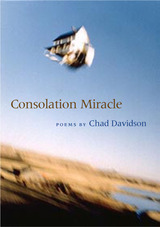 Consolation Miracle
Chad Davidson
Southern Illinois University Press, 2003 Consolation Miracle is a book of visceral, image-driven poems that search for the miraculous in the seemingly ordinary. This collection fashions art out of artless objects as a consolation, or perhaps compensation, for their smallness. Yawns and pears, cockroaches and crows resonate against historically conflated backdrops, while our own hands seem suddenly strange as they hide themselves in our pockets, balance a burning cigarette between two fingers, or grip the gun that shot Lincoln. Other poems address the destruction of empire, the end of old Hollywood, and the hyperbolic fizzling out of entire centuries. Here, consolation miracles are rarely the ones sought after, yet they radiate in their neglect. Davidson’s poems help us understand the inner life of cows, imagine the plight of a banished Kama Sutra illustrator, speculate about Cleopatra’s lingerie. With a title borrowed from Gabriel García Márquez, Consolation Miracle contains a magical realism for the twenty-first century.
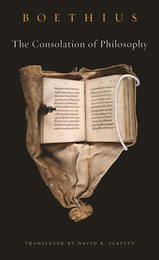 The Consolation of Philosophy
Boethius
Harvard University Press, 2010 In this highly praised new translation of Boethius’s The Consolation of Philosophy, David R. Slavitt presents a graceful, accessible, and modern version for both longtime admirers of one of the great masterpieces of philosophical literature and those encountering it for the first time. Slavitt preserves the distinction between the alternating verse and prose sections in the Latin original, allowing us to appreciate the Menippian parallels between the discourses of literary and logical inquiry. His prose translations are lively and colloquial, conveying the argumentative, occasionally bantering tone of the original, while his verse translations restore the beauty and power of Boethius’s poetry. The result is a major contribution to the art of translation.
Those less familiar with Consolation may remember it was written under a death sentence. Boethius (c. 480–524), an Imperial official under Theodoric, Ostrogoth ruler of Rome, found himself, in a time of political paranoia, denounced, arrested, and then executed two years later without a trial. Composed while its author was imprisoned, cut off from family and friends, it remains one of Western literature’s most eloquent meditations on the transitory nature of earthly belongings, and the superiority of things of the mind. In an artful combination of verse and prose, Slavitt captures the energy and passion of the original. And in an introduction intended for the general reader, Seth Lerer places Boethius’s life and achievement in context.
 Consolation to Stagirius
St. John Chrysostom
Catholic University of America Press, 2025 John Chrysostom (d. 407) was first a priest in Antioch and later the short-lived archbishop of Constantinople. Although best known as a preacher, throughout his career he also wrote a number of letters and treatises, primarily to ascetic and clerical audiences. The Consolation to Stagirius is one of these treatises, written early in his career. Over three books, Chrysostom seeks to comfort his acquaintance, Stagirius, both for the suffered experienced at the hands of a demon – manifesting in nightmares and seizures – and for the melancholy he was experiencing due to estrangement with his father. The sources that Chrysostom draws on for this consolation are primarily biblical narratives: the lives of the scriptural saints. The first book comprises mainly arguments for God’s providence over Stagirius’ life and the lives of all the saints. Stagirius is to find comfort in the fact that God directs all things—including those that seem evil—for the benefit of those whom he loves. The second and third books are then extended narrations of the sufferings of the patriarchs and the prophets and, much more briefly, the apostles. Stagirius is to compare his sufferings to those who went before and to learn that suffering is no indication of a lack of God’s providential care. This treatise thus contributes to our understanding of early Christian attitudes towards the problem of suffering and the means of God’s providence in the lives of the saints.
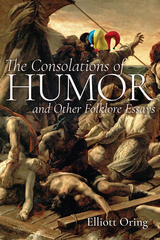 The Consolations of Humor and Other Folklore Essays
Elliott Oring
Utah State University Press, 2023 The Consolations of Humor and Other Folklore Essays unfolds as a series of questions, commentaries, and criticisms of the analysis, interpretation, and explanation of folklore. Can we confidently regard jokes as the catharsis of sexual and aggressive impulses? What is the basis for characterizing a joke as Jewish or Scottish or Japanese? What do we really know about “dirty jokes”? How is a text or behavior constructed so that it is perceived as humorous? Can we get a computer to reliably recognize jokes? What is the relevance of memetics and a Darwinian paradigm to understanding folklore change over time? Can we identify laws operating in the realm of folklore? How can the marginalization, extinction, or continuity of traditions be explained? In the course of addressing these questions, Elliott Oring identifies some fundamental problems, brings new evidence and observations to the discussion, and proffers some original and startling insights.
While recognizing the study of jokes and other forms of folklore as a humanistic endeavor, Oring believes in the relevance of a scientific perspective to the enterprise. He values clear definitions, tests of hypotheses and theories, empirical evidence, experiment, and the search for laws. Written in a sophisticated yet accessible style, The Consolations of Humor and Other Folklore Essays stimulates both scholars and students alike and contributes to the creation of a more robust folkloristics in the twenty-first century.
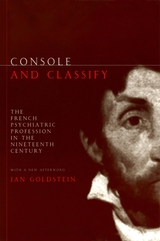 Console and Classify: The French Psychiatric Profession in the Nineteenth Century
Jan E. Goldstein
University of Chicago Press, 2001 Since its publication in 1989, Console and Classify has become a classic work in the history of science and in French intellectual history. Now with a new afterword, this much-cited and much-discussed book gives readers the chance to revisit the rise of psychiatry in nineteenth-century France, the shape it took and why, and its importance both then and in contemporary society.
"Goldstein has raised our understanding of the politics of psychiatric professionalization on to a new plane."—Roy Porter, Times Higher Education Supplement
"[A]n historiographical tour de force, quite simply the most insightful work on the subject in English or any other language. . . . [A] work of distinctive originality. . . . It is written with lucidity and elegance, even a certain confident scholarly panache, that make it a pleasure to read."—Toby Gelfand, Social History
"Exhaustively researched, elegantly written, and persuasively argued, Console and Classify is an excellent example of the . . . sociologically informed intellectual history, stimulated by Kuhn and Foucault."—Robert Alun Jones, American Journal of Sociology
 Conspicuous Bodies: Provincial Belief and the Making of Joyce and Rushdie
Jean Kane
Ohio State University Press, 2014 In Conspicuous Bodies: Provincial Belief and the Making of Joyce and Rushdie, Jean Kane re-examines the literature of James Joyce and Salman Rushdie from a post-secularist perspective, arguing that their respective religions hold critical importance in their works. Though Joyce and Rushdie were initially received as cosmopolitans, both authors subsequently reframed their public images and aligned themselves instead with a provincial religious identity, which emphasized the interconnections between religious devotion and embodiment. At the same time, both Joyce and Rushdie managed to resist the doctrinal content of their religions.
Conspicuous Bodies presents Joyce as a founder and Rushdie as an inheritor of a distinctive discourse of belief about the importance of physical bodies and knowledge in religious practice. In doing so, it moves the reception of Joyce and Rushdie away from what previous critics have emphasized—away from questions of aesthetics and from a narrow understanding of belief—and instead questions the assumption that belief should be segregated from matters of physicality and knowledge. Kane reintroduces the concept of spiritual embodiment in order to expand our understanding of what counts as spiritual agency in non-western and minority literatures.
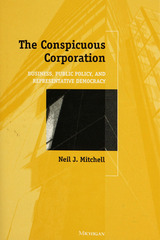 Conspicuous Corporation: Business, Public Policy, and Representative Democracy
Neil J. Mitchell
University of Michigan Press, 1997 Why, despite the political advantages of business in the policy process, do business interests still sometimes lose policy fights in the political system? Money, mobility, connections, and incentives load the political system in favor of business interests. Against the odds, when the conspicuous corporation meets the virtuous politician, business often loses in the policy struggle. In answering this question, Neil J. Mitchell reassesses the dimensions of business power in the political system and provides a fresh consideration of how economic power translates into political power. Charles Lindbloom's analysis of business power provides a point of departure for an examination of the evidence on business influence over public preferences, on the importance of business confidence to politicians, and on the financial and lobbying activities of business interests. Mitchell then considers the position of labor unions--the traditional opposition to business--in contemporary policy making. Finally, he discusses the conditions under which business power breaks down. This is accompanied by an analysis of a variety of cases in which business has attempted to influence the policy making process to test his findings. Extensively researched, this book sheds new light on the activities of business in politics, on the strength of interests opposing business, and on business policy failures in the United States and the United Kingdom. The empirical analysis builds on survey data, extensive interviews, and archival research. The relationship between business and government is a core topic for economists, sociologists and political scientists, taking us from heroic struggles over policy to sordid episodes of political corruption. The book will be of interest to scholars in the social sciences and in business schools as well as to the general reader interested in power and influence in representative democracies. Neil Mitchell is Professor of Political Science, University of New Mexico.
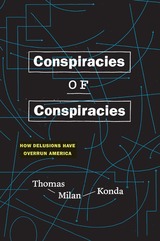 Conspiracies of Conspiracies: How Delusions Have Overrun America
Thomas Milan Konda
University of Chicago Press, 2019 It’s tempting to think that we live in an unprecedentedly fertile age for conspiracy theories, with seemingly each churn of the news cycle bringing fresh manifestations of large-scale paranoia. But the sad fact is that these narratives of suspicion—and the delusional psychologies that fuel them—have been a constant presence in American life for nearly as long as there’s been an America.
In this sweeping book, Thomas Milan Konda traces the country’s obsession with conspiratorial thought from the early days of the republic to our own anxious moment. Conspiracies of Conspiracies details centuries of sinister speculations—from antisemitism and anti-Catholicism to UFOs and reptilian humanoids—and their often incendiary outcomes. Rather than simply rehashing the surface eccentricities of such theories, Konda draws from his unprecedented assemblage of conspiratorial writing to crack open the mindsets that lead people toward these self-sealing worlds of denial. What is distinctively American about these theories, he argues, is not simply our country’s homegrown obsession with them but their ongoing prevalence and virulence. Konda proves that conspiracy theories are no harmless sideshow. They are instead the dark and secret heart of American political history—one that is poisoning the bloodstream of an increasingly sick body politic.
 The Conspiracy Against Hitler in the Twilight War
Harold C. Deutsch
University of Minnesota Press, 1968 The Conspiracy Against Hitler in the Twilight War was first published in 1968. Minnesota Archive Editions uses digital technology to make long-unavailable books once again accessible, and are published unaltered from the original University of Minnesota Press editions. This is the first detailed account in English of the German anti-Nazi plot of September 1939 - May 1940, a conspiracy which involved the services of Pope Pius XII as in intermediary. Much new information is presented, and the book puts the whole story of the German resistance movement in a clearer light than has been possible before. Much of the account is based on the testimony of over fifty witnesses whom Professor Deutsch interviewed or interrogated, comprising virtually all the participants or observers who survived the period. He also had access to previously unavailable French and Belgian documents as well as to diaries and other private material. As the author explains, there were four major rounds of opposition to the Hitler regime, the conspiracy described in this volume being the second. IN many ways it was the round in which circumstances were the most favorable for success. High military quarters were the most fully committed, it was the only plan in which a foreign power at odds with Germany (britain) took a supporting position, and it was the only instance in which a notable outside figure, Pius XII, made his good offices available as an intermediary. The role of the Pope in this conspiracy has been known in a general way since 1946, but Professor Deutsch's investigation is the first intensive study were at the core of the affair, Josef Muller, the Opposition agent who dealt with the Pope and who later became the Bavarian Minister o Justice, and Rev. Robert Leiber, S.F., the Pope's confidential aide. In his conclusion Professor Deutsch points out that the story of this conspiracy clearly testifies to the moral nature of the German resistance movement. The author writes: "No term recurred more often in these months to define the conflict with the Third Reich then 'the decent Germany.'"
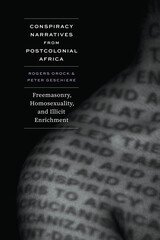 Conspiracy Narratives from Postcolonial Africa: Freemasonry, Homosexuality, and Illicit Enrichment
Rogers Orock and Peter Geschiere
University of Chicago Press, 2024 Decoding conspiracy thinking at the nexus of sexuality, Freemasonry, and the occult.
In this book, anthropologists Rogers Orock and Peter Geschiere examine the moral panic over a perceived rise in homosexuality that engulfed Cameroon and Gabon beginning in the early twenty-first century. As they uncover the origins of the conspiratorial narratives that fed this obsession, they argue that the public’s fears were grounded in historically situated assumptions about the entanglement of same-sex practices, Freemasonry, and illicit enrichment.
This specific panic in postcolonial Central Africa fixated on high-ranking Masonic figures thought to lure younger men into sex in exchange for professional advancement. The authors’ thorough account shows how attacks on elites as homosexual predators corrupting the nation became a powerful outlet for mounting populist anger against the excesses and corruption of the national regimes. Unraveling these tensions, Orock and Geschiere present a genealogy of Freemasonry, taking readers from London through Paris to francophone Africa and revealing along the way how the colonial past shapes present-day anxieties linking same-sex practices to enrichment.
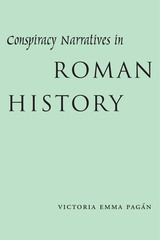 Conspiracy Narratives in Roman History
By Victoria Emma Pagán
University of Texas Press, 2005 Conspiracy is a thread that runs throughout the tapestry of Roman history. From the earliest days of the Republic to the waning of the Empire, conspiracies and intrigues created shadow worlds that undermined the openness of Rome's representational government. To expose these dark corners and restore a sense of order and safety, Roman historians frequently wrote about famous conspiracies and about how their secret plots were detected and the perpetrators punished. These accounts reassured readers that the conspiracy was a rare exception that would not happen again—if everyone remained vigilant. In this first book-length treatment of conspiracy in Roman history, Victoria Pagán examines the narrative strategies that five prominent historians used to disclose events that had been deliberately shrouded in secrecy and silence. She compares how Sallust, Livy, and Tacitus constructed their accounts of the betrayed Catilinarian, Bacchanalian, and Pisonian conspiracies. Her analysis reveals how a historical account of a secret event depends upon the transmittal of sensitive information from a private setting to the public sphere—and why women and slaves often proved to be ideal transmitters of secrets. Pagán then turns to Josephus's and Appian's accounts of the assassinations of Caligula and Julius Caesar to explore how the two historians maintained suspense throughout their narratives, despite readers' prior knowledge of the outcomes.
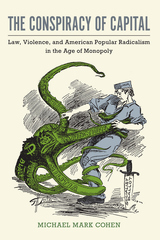 The Conspiracy of Capital: Law, Violence, and American Popular Radicalism in the Age of Monopoly
Michael Mark Cohen
University of Massachusetts Press, 2019 Between the 1880s and 1920s, a broad coalition of American dissidents, which included rabble-rousing cartoonists, civil liberties lawyers, socialist detectives, union organizers, and revolutionary martyrs, forged a culture of popular radicalism that directly challenged an emergent corporate capitalism. Monopoly capitalists and their allies in government responded by expanding conspiracy laws and promoting conspiracy theories in an effort to destroy this anti-capitalist movement. The result was an escalating class conflict in which each side came to view the other as a criminal conspiracy.
In this detailed cultural history, Michael Mark Cohen argues that a legal, ideological, and representational politics of conspiracy contributed to the formation of a genuinely revolutionary mass culture in the United States, starting with the 1886 Haymarket bombing. Drawing on a wealth of primary sources, The Conspiracy of Capital offers a new history of American radicalism and the alliance between the modern business corporation and national security state through a comprehensive reassessment of the role of conspiracy laws and conspiracy theories in American social movements.
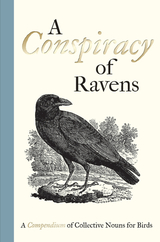 A Conspiracy of Ravens: A Compendium of Collective Nouns for Birds
Compiled by Samuel Fanous
Bodleian Library Publishing, 2014 A charm of goldfinches. An ostentation of peacocks. A murder of crows. The English language brims with witty words for flocks of birds! Thought to have originated from hunting manuals, the practice of inventing collective nouns for birds has since evolved into a sport all its own, with new words striving to perfectly capture the essence of each bird.
A Conspiracy of Ravens presents readers with a compendium of collective bird nouns from the distant and not-so-distant past. Some of the nouns are portentous, like a tiding of magpies. Others, like a murmuration of starlings or a chattering of choughs, convey sound. Still more reflect with literary flourish the beauty of the bird: what could be more celebratory than a crown of kingfishers or an exaltation of larks? Featuring songbirds, aquatic birds, garden favorites, and birds of prey, this book collects more than one hundred of the best and most imaginative expressions and illustrates them with charming woodcuts by the eighteenth-century artist and naturalist Thomas Bewick.
A beautiful and entertaining read, A Conspiracy of Ravens will delight bird-lovers and word-lovers in equal measure.
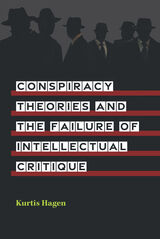 Conspiracy Theories and the Failure of Intellectual Critique
Kurtis Hagen
University of Michigan Press, 2022 Conspiracy Theories and the Failure of Intellectual Critique argues that conspiracy theories, including those that conflict with official accounts and suggest that prominent people in Western democracies have engaged in appalling behavior, should be taken seriously and judged on their merits and problems on a case-by-case basis. It builds on the philosophical work on this topic that has developed over the past quarter century, challenging some of it, but affirming the emerging consensus: each conspiracy theory ought to be judged on its particular merits and faults. The philosophical consensus contrasts starkly with what one finds in the social science literature. Kurtis Hagen argues that significant aspects of that literature, especially the psychological study of conspiracy theorists, has turned out to be flawed and misleading. Those flaws are not randomly directed; rather, they consistently serve to disparage conspiracy theorists unfairly. This suggests that there may be a bias against conspiracy theorists in the academy, skewing “scientific” results. Conspiracy Theories and the Failure of Intellectual Critique argues that social scientists who study conspiracy theories and/or conspiracy theorists would do well to better absorb the implications of the philosophical literature.
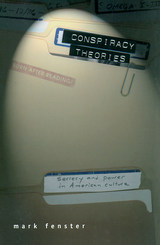 Conspiracy Theories: Secrecy and Power in American Culture
Mark Fenster
University of Minnesota Press, 2001 JFK, Karl Marx, the Pope, Aristotle Onassis, Queen Elizabeth II, Howard Hughes, Fox Mulder, Bill Clinton--all have been linked to vastly complicated global (or even galactic) intrigues. In this enlightening tour of conspiracy theories, Mark Fenster guides readers through this shadowy world and analyzes its complex role in American culture and politics.
Fenster argues that conspiracy theories are a form of popular political interpretation and contends that understanding how they circulate through mass culture helps us better understand our society as a whole. To that end, he discusses Richard Hofstadter's The Paranoid Style in American Politics, the militia movement, The X-Files, popular Christian apocalyptic thought, and such artifacts of suspicion as The Turner Diaries, the Illuminatus! trilogy, and the novels of Richard Condon.
Fenster analyzes the "conspiracy community" of radio shows, magazine and book publishers, Internet resources, and role-playing games that promote these theories. In this world, the very denial of a conspiracy's existence becomes proof that it exists, and the truth is always "out there." He believes conspiracy theory has become a thrill for a bored subculture, one characterized by its members' reinterpretation of "accepted" history, their deep cynicism about contemporary politics, and their longing for a utopian future.
Fenster's progressive critique of conspiracy theories both recognizes the secrecy and inequities of power in contemporary politics and economics and works toward effective political engagement. Probing conspiracy theory's tendencies toward scapegoating, racism, and fascism, as well as Hofstadter's centrist acceptance of a postwar American "consensus," he advocates what conspiracy theory wants but cannot articulate: a more inclusive, engaging political culture.
"Fenster, a lone writer (the literary equivalent of a lone gunman, perhaps), segues from the novels of Thomas Pynchon to the Clinton Death List. . . . Conspiracy Theories is a dangerous book. I suspect 'they' (and you know who I mean, of course) will take care of this lone writer any day now."--Bookforum
"Fenster makes a powerful argument for regarding conspiracism as an integral product of the political system, reflecting inadequacies the establishment itself is blind to and expressing strong desires for the realization of frustrated ideals. Conspiracy Theories is a fascinating look at an important, little-studied topic. Informative and thought-provoking." --Philadelphia City Paper
"Fenster culls the liveliest counterintelligences out there--the Michigan Militia, religious millennialists, Chris Carter, even Oliver Stone--and sets them up as the last idealists. They might be obsessive and maniacal, but they're after a transparent political system, where big business and the government can be held accountable. Their 'paranoid style,' according to Fenster, is just old-school populism refitted for the media age." --Voice Literary Supplement
"Fenster makes a powerful argument for regarding conspiracism as an integral product of the political system, reflecting inadequacies the establishment itself is blind to and expressing strong desires for the realization of frustrated ideals. Conspiracy Theories is a fascinating look at an important, little-studied topic. Informative and thought-provoking." Philadelphia City Paper
"Fenster's careful examination of conspiratorial beliefs as evidence by right-wing groups, by various media, and even by those who devise such theories as a form of ludic or satiric endeavor (like Robert Anton Wilson) is revealing. And his articulation of the set of political-rather than pathological-reasons for their behavior is salutary." --American Book Review
"Fenster's extensive and impressive research provided a means of coming to terms with the radical disjunction between the interpretive framework which I used to understand events such as the one at Littleton, and a framework at odds with my own which was now confronting me on a daily basis." --Canadian Journal of Communication
"In this lively and wide-ranging critique, Fenster argues that conspiracy theories are attempts to engage in a more inclusive political culture." --Religious Studies Review
"Mark Fenster has provided a solid and illuminating study of the public's fascination with conspiracy theories and sets forth a stimulating correlation between the popularity of such theories and the social and political values of our society. This is a comprehensive and intriguing analysis of our often obsessive interest in conspiracy theories." --Gerald Posner, author of Killing the Dream : James Earl Ray and the Assassination of Martin Luther King, Jr. and Case Closed : Lee Harvey Oswald and the Assassination of JFK
"I find the issue of conspiracy theory compelling and appreciate Fenster's fruitful approach to what has been mysteriously ignored by the academy." --Barbie Zelizer, author of Covering the Body: The Kennedy Assassination, the Media, and the Shaping of Collective Memory
"Fenster shines a powerful light on the fantasies of secrecy that pervade American culture, illuminating both the way they originate and how they work. His analysis is theoretically acute, his criticism of previous scholarly studies is compelling, and he offers razor-sharp readings of an impressive array of movements, events, and cultural practices. He stands out, above all, for his ability to capture the power and appeal of conspiratorial understandings of politics even as he explains their fundamental political limitations. The only thing that can keep this book from having the impact it deserves is a vast, academic conspiracy." --Mark T. Reinhardt, Williams College
Mark Fenster received his Ph.D. in communication from the University of Illinois and his law degree from Yale University. He currently lives in Denver.
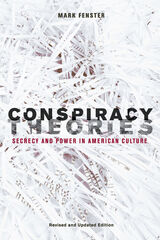 Conspiracy Theories: Secrecy and Power in American Culture
Mark Fenster
University of Minnesota Press, 2008 The popular study of conspiracy theories and why we should pay attention—completely updated for the post-9/11 world JFK, Karl Marx, the Pope, Aristotle Onassis, Howard Hughes, Fox Mulder, Bill Clinton, both George Bushes—all have been linked to vastly complicated global (or even galactic) intrigues. Two years after Mark Fenster first published Conspiracy Theories, the attacks of 9/11 stirred the imaginations of a new generation of believers. Before the black box from United 93 had even been found, there were theories put forth from the implausible to the offensive and outrageous. In this new edition of the landmark work, and the first in-depth look at the conspiracy communities that formed to debunk the 9/11 Commission Report, Fenster shows that conspiracy theories play an important role in U.S. democracy. Examining how and why they circulate through mass culture, he contends, helps us better understand society as a whole. Ranging from The Da Vinci Code to the intellectual history of Richard Hofstadter, he argues that dismissing conspiracy theories as pathological or marginal flattens contemporary politics and culture because they are—contrary to popular portrayal—an intense articulation of populism and, at their essence, are strident calls for a better, more transparent government. Fenster has demonstrated once again that the people who claim someone’s after us are, at least, worth hearing.
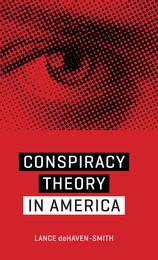 Conspiracy Theory in America
By Lance deHaven-Smith
University of Texas Press, 2013 Ever since the Warren Commission concluded that a lone gunman assassinated President John F. Kennedy, people who doubt that finding have been widely dismissed as conspiracy theorists, despite credible evidence that right-wing elements in the CIA, FBI, and Secret Service—and possibly even senior government officials—were also involved. Why has suspicion of criminal wrongdoing at the highest levels of government been rejected out-of-hand as paranoid thinking akin to superstition? Conspiracy Theory in America investigates how the Founders’ hard-nosed realism about the likelihood of elite political misconduct—articulated in the Declaration of Independence—has been replaced by today’s blanket condemnation of conspiracy beliefs as ludicrous by definition. Lance deHaven-Smith reveals that the term “conspiracy theory” entered the American lexicon of political speech to deflect criticism of the Warren Commission and traces it back to a CIA propaganda campaign to discredit doubters of the commission’s report. He asks tough questions and connects the dots among five decades’ worth of suspicious events, including the assassinations of John and Robert Kennedy, the attempted assassinations of George Wallace and Ronald Reagan, the crimes of Watergate, the Iran-Contra arms-for-hostages deal, the disputed presidential elections of 2000 and 2004, the major defense failure of 9/11, and the subsequent anthrax letter attacks. Sure to spark intense debate about the truthfulness and trustworthiness of our government, Conspiracy Theory in America offers a powerful reminder that a suspicious, even radically suspicious, attitude toward government is crucial to maintaining our democracy.
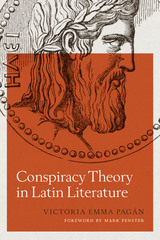 Conspiracy Theory in Latin Literature
By Victoria Emma Pagán
University of Texas Press, 2012 Conspiracy theory as a theoretical framework has emerged only in the last twenty years; commentators are finding it a productive way to explain the actions and thoughts of individuals and societies. In this compelling exploration of Latin literature, Pagán uses conspiracy theory to illuminate the ways that elite Romans invoked conspiracy as they navigated the hierarchies, divisions, and inequalities in their society. By seeming to uncover conspiracy everywhere, Romans could find the need to crush slave revolts, punish rivals with death or exile, dismiss women, denigrate foreigners, or view their emperors with deep suspicion. Expanding on her earlier Conspiracy Narratives in Roman History, Pagán here interprets the works of poets, satirists, historians, and orators—Juvenal, Tacitus, Suetonius, Terence, and Cicero, among others—to reveal how each writer gave voice to fictional or real actors who were engaged in intrigue and motivated by a calculating worldview. Delving into multiple genres, Pagán offers a powerful critique of how conspiracy and conspiracy theory can take hold and thrive when rumor, fear, and secrecy become routine methods of interpreting (and often distorting) past and current events. In Roman society, where knowledge about others was often lacking and stereotypes dominated, conspiracy theory explained how the world worked. The persistence of conspiracy theory, from antiquity to the present day, attests to its potency as a mechanism for confronting the frailties of the human condition.
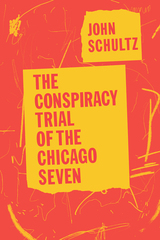 The Conspiracy Trial of the Chicago Seven
John Schultz
University of Chicago Press, 2009 In 1969, the Chicago Seven were charged with intent to "incite, organize, promote, and encourage" antiwar riots during the chaotic 1968 Democratic National Convention in Chicago. The defendants included major figures of the antiwar and racial justice movements: Abbie Hoffman and Jerry Rubin, the madcap founders of the Yippies; Tom Hayden and Rennie Davis, founders of Students for a Democratic Society and longtime antiwar organizers; David Dellinger, a pacifist and chair of the National Mobilization Committee to End the War in Vietnam; and Bobby Seale, co-founder of the Black Panther Party, who would be bound and gagged in the courtroom before his case was severed from the rest.
The Conspiracy Trial of the Chicago Seven is an electrifying account of the months-long trial that commanded the attention of a divided nation. John Schultz, on assignment for The Evergreen Review, witnessed the whole trial of the Chicago Seven, from the jury selection to the aftermath of the verdict. In his vivid account, Schultz exposes the raw emotions, surreal testimony, and judicial prejudice that came to define one of the most significant legal events in American history.
In October 2020, Aaron Sorkin's film, The Trial of the Chicago Seven, will bring this iconic trial to the screen.
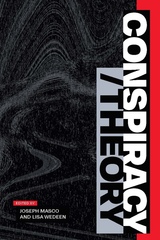 Conspiracy/Theory
Joseph Masco and Lisa Wedeen, editors
Duke University Press, 2024 In an era of intensified information warfare, ranging from global disinformation campaigns to individual attention hacks, what are the compelling terms for political judgment? How are we to build the knowledge needed to recognize and address important forms of harm when critical information is either not to be trusted or kept hidden? Rather than approach conspiratorial narrative as an irrational response to an obviously decipherable reality, Conspiracy/Theory identifies important affinities between conspiracy theory and critical theory. It recognizes the motivation people have—in their capacities as experts, theorists, and ordinary citizens—to search for patterns in events, to uncover what is covert and attend to dimensions of life that might be hiding in plain sight. If it seems strange that so many find themselves living in incommensurable, disorienting realities, the multidisciplinary contributors to Conspiracy/Theory explore how and why that came to be. Across history and geography, contributors inquire into the affects and imaginaries of political mobilization, tracking counterrevolutionary projects while acknowledging collective futures that demand conspiratorial engagement.
Contributors. Nadia Abu El-Haj, Hussein Ali Agrama, Kathleen Belew, Elizabeth Anne Davis, Joseph Dumit, Faith Hillis, Lochlann Jain, Demetra Kasimis, Susan Lepselter, Darryl Li, Louisa Lombard, Joseph Masco, Robert Meister, Timothy Melley, Rosalind C. Morris, George Shulman, Lisa Wedeen
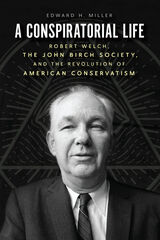 A Conspiratorial Life: Robert Welch, the John Birch Society, and the Revolution of American Conservatism
Edward H. Miller
University of Chicago Press, 2021 The first full-scale biography of Robert Welch, who founded the John Birch Society and planted some of modern conservatism’s most insidious seeds.
Though you may not know his name, Robert Welch (1899-1985)—founder of the John Birch Society—is easily one of the most significant architects of our current political moment. In A Conspiratorial Life, the first full-scale biography of Welch, Edward H. Miller delves deep into the life of an overlooked figure whose ideas nevertheless reshaped the American right.
A child prodigy who entered college at age 12, Welch became an unlikely candy magnate, founding the company that created Sugar Daddies, Junior Mints, and other famed confections. In 1958, he funneled his wealth into establishing the organization that would define his legacy and change the face of American politics: the John Birch Society. Though the group’s paranoiac right-wing nativism was dismissed by conservative thinkers like William F. Buckley, its ideas gradually moved from the far-right fringe into the mainstream. By exploring the development of Welch’s political worldview, A Conspiratorial Life shows how the John Birch Society’s rabid libertarianism—and its highly effective grassroots networking—became a profound, yet often ignored or derided influence on the modern Republican Party. Miller convincingly connects the accusatory conservatism of the midcentury John Birch Society to the inflammatory rhetoric of the Tea Party, the Trump administration, Q, and more. As this book makes clear, whether or not you know his name or what he accomplished, it’s hard to deny that we’re living in Robert Welch’s America.
 A Conspiratorial Life: Robert Welch, the John Birch Society, and the Revolution of American Conservatism
Edward H. Miller
University of Chicago Press, 2021 This is an auto-narrated audiobook edition of this book. The first full-scale biography of Robert Welch, who founded the John Birch Society and planted some of modern conservatism’s most insidious seeds.
Though you may not know his name, Robert Welch (1899-1985)—founder of the John Birch Society—is easily one of the most significant architects of our current political moment. In A Conspiratorial Life, the first full-scale biography of Welch, Edward H. Miller delves deep into the life of an overlooked figure whose ideas nevertheless reshaped the American right.
A child prodigy who entered college at age 12, Welch became an unlikely candy magnate, founding the company that created Sugar Daddies, Junior Mints, and other famed confections. In 1958, he funneled his wealth into establishing the organization that would define his legacy and change the face of American politics: the John Birch Society. Though the group’s paranoiac right-wing nativism was dismissed by conservative thinkers like William F. Buckley, its ideas gradually moved from the far-right fringe into the mainstream. By exploring the development of Welch’s political worldview, A Conspiratorial Life shows how the John Birch Society’s rabid libertarianism—and its highly effective grassroots networking—became a profound, yet often ignored or derided influence on the modern Republican Party. Miller convincingly connects the accusatory conservatism of the midcentury John Birch Society to the inflammatory rhetoric of the Tea Party, the Trump administration, Q, and more. As this book makes clear, whether or not you know his name or what he accomplished, it’s hard to deny that we’re living in Robert Welch’s America.
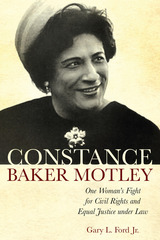 Constance Baker Motley: One Woman's Fight for Civil Rights and Equal Justice under Law
Gary L. Ford Jr.
University of Alabama Press, 2017 When the name Constance Baker Motley is mentioned, more often than not, the response is “Who was she?” or “What did she do?” The answer is multifaceted, complex, and inspiring.
Constance Baker Motley was an African American woman; the daughter of immigrants from Nevis, British West Indies; a wife; and a mother who became a pioneer and trailblazer in the legal profession. She broke down barriers, overcame gender constraints, and operated outside the boundaries placed on black women by society and the civil rights movement. In Constance Baker Motley: One Woman’s Fight for Civil Rights and Equal Justice under Law, Gary L. Ford Jr. explores the key role Motley played in the legal fight to desegregate public schools as well as colleges, universities, housing, transportation, lunch counters, museums, libraries, parks, and other public accommodations.
The only female attorney at the NAACP Legal Defense and Educational Fund, Inc., Motley was also the only woman who argued desegregation cases in court during much of the civil rights movement. From 1946 through 1964, she was a key litigator and legal strategist for landmark civil rights cases including the Montgomery Bus Boycott and represented Martin Luther King Jr. as well as other protesters arrested and jailed as a result of their participation in sit-ins, marches, and freedom rides.
Motley was a leader who exhibited a leadership style that reflected her personality traits, skills, and strengths. She was a visionary who formed alliances and inspired local counsel to work with her to achieve the goals of the civil rights movement. As a leader and agent of change, she was committed to the cause of justice and she performed important work in the trenches in the South and behind the scene in courts that helped make the civil rights movement successful.
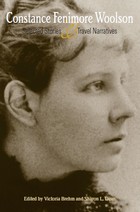 Constance Fenimore Woolson: Selected Stories and Travel Narratives
Victoria Brehm
University of Tennessee Press, 2004 American writer and world traveler Constance Fenimore Woolson (1840–1894) was author of more than fifty short stories, four novels, a novella, and numerous poems and travel essays. During her lifetime, she achieved both popular and critical success, but much of her work is no longer available. This volume, as the first anthology to collect representative samples of her stories, travel sketches, poems, and correspondence, represents a major advance toward re-establishing her place in nineteenth-century literature and letters. As these pieces demonstrate, Woolson offered keen observations on the issues she cared most deeply about, namely the cultural and political transformation of the United States in the wake of the Civil War, the status of women writers and artists in the nineteenth century, and the growing implications of nationalism and imperialism.
Woolson grew up in Cleveland, Ohio, and began her career writing regional travel stories about the closing of the American frontier in the old Northwest Territories (now known as the Great Lakes region). During the Civil War, she worked for a variety of Union causes and in 1873 moved to St. Augustine, Florida. Traveling throughout the South, she wrote stories and travel narratives that highlighted the wholesale changes facing Americans after the Civil War.
In 1879, Woolson left the United States for Europe. There, she engaged her passion for nature and exercised her gift for social satire. In her European writings, she deplored the Americans’ slavish devotion to the ubiquitous guidebooks of the nineteenth century, and she chose instead to spend long periods of time in one place in order to better learn about it. Throughout her time in Europe (including visits to North Africa), Woolson often commented that she could not describe landscapes, only experience them. By the time of her death in Venice at age fifty-three, she had become convinced that the colonial agendas of the United States and Europe would transform landscapes and peoples in far-reaching and ultimately dangerous ways.
This collection features selections from each of the three distinct periods of Woolson’s career and includes a chronology of her life and travels. Focusing primarily on Woolson’s short stories, editors Victoria Brehm and Sharon L. Dean also include a representative letter, poem, and travel sketch for each section.
Victoria Brehm is associate professor of English at Grand Valley State University. She is editor of three anthologies, including “A Fully Accredited Ocean”: Essays on the Great Lakes and Sweetwater, Storms, and Spirits: Stories of the Great Lakes.
Sharon L. Dean is professor of English at Rivier College and is author of Constance Fenimore Woolson: Homeward Bound and Constance Fenimore Woolson and Edith Wharton: Perspectives on Landscape and Art.
 Constance Pascal (1877–1937): Authority, Femininity and Feminism in French Psychiatry
Felicia Gordon
University of London Press, 2014 Constance Pascal’s career in French psychiatry from 1908 to 1937 exemplifies the opportunities open to women in the French Third Republic as well as the prejudices they encountered. As the first woman psychiatrist in France, Pascal, of Romanian origin, attained professional success at the cost of suppressing her personal life. Best known for her work on dementia praecox, she founded one of the first schools in France for children with severe learning difficulties, and made remarkable contributions in the reform of asylum practices and, influenced by Freudian psychoanalysis, in psychotherapeutic intervention. Her feminism is demonstrated by her distinguished, often contentious, career in a hitherto all male profession and by her support for other women in their professional roles. Her unjustly neglected life story illuminates many of the conflicts experienced by women entering the professions during the belle époque and the inter-war years. The study’s scholarly authority and ambitious theoretical range do not detract from its lively sense of the person and life struggles of the subject making this a fine demonstration of life history research enthralling for the general reader and expert alike.
Constance Ring
Amalie Skram
Northwestern University Press, 2002 Initially rejected by the author's scandalized publisher, Constance Ring is now considered a classic of Scandinavian-and world-literature, a passionate condemnation of marriage and moral hypocrisy that has drawn comparisons to Madame Bovary and The Awakening. The story of a naive young woman who sets out to divorce her loving but adulterous husband, Constance Ring is an intimate portrayal of a vibrant woman's refusal to yield to the forces that constrict women's lives in a society that offers them few choices.
 Constancy and Change in Human Development
Orville G. Brim Jr.
Harvard University Press, 1980 How malleable is human nature? Can an individual really change in meaningful ways? Or, are there immutable limits on the possibilities of human growth set in place by the genes and by the early experiences of childhood? These are questions which touch our deepest political and personal concerns; and they have long been a matter of fierce debate in the behavioral sciences.
Constancy and Change in Human Development takes a thorough inventory of the growing body of research which now bears upon these questions. Editors Brim and Kagan have assembled an outstanding group of specialists in human growth and commissioned them to assess questions of change and continuity in physical, mental, and emotional development throughout the life span. Beginning with three general chapters which place the ideas of continuity and discontinuity in historical and philosophical perspective, the book moves across a broad spectrum of developmental issues, ranging from the basic adaptability of the human central nervous system to the effects of social institutions which seek to promote individual change. There are chapters on physical growth, health, cognitive development, personality, social attitudes and beliefs, occupational careers, psychosis, and criminal behavior. Throughout these chapters, the recurring question is whether development can be seen as a continuous process in which early stages reliably predict subsequent events, or whether instead there are sharp discontinuities which render individual development essentially unpredictable. The variety and richness of the answers to this question provide a summary of human development which is unparalleled in any other single volume.
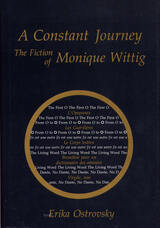 A Constant Journey: The Fiction of Monique Wittig
Erika Ostrovsky
Southern Illinois University Press, 1991
From the creation of a neuter pronoun in her earliest work, L’Opoponax, to the confusion of genres in her most recent fiction, Virgile, non, Monique Wittig uses literary subversion and invention to accomplish what Erika Ostrovsky appropriately defines as renversement, the annihilation of existing literary canons and the creation of highly innovative constructs.
Erika Ostrovsky explores those aspects of Wittig’s work that best illustrate her literary approach. Among the countless revolutionary devices that Wittig uses to achieve renversement are the feminization of masculine gender names, the reorganization of myth patterns, and the replacement of traditional punctuation with her own system of grammatical emphasis and separation. It is the unexpected quantity and quality of such literary devices that make reading Monique Wittig’s fiction a fresh and rewarding experience. Such literary devices have earned Wittig the acclaim of her critics and peers—Marguerite Duras, Mary McCarthy, Alain Robbe-Grillet, Nathalie Sarraute, and Claude Simon, to name a few.
While analyzing the intrinsic value of each of Wittig’s fictions separately, Erika Ostrovsky traces the progressive development of Wittig’s major literary devices as they appear and reappear in her fictions. Ostrovsky maintains that the seeds of those innovations that appear in Wittig’s most recent texts can be found as far back as L’Opoponax. This evidence of progression supports Ostrovsky’s theory that clues to Wittig’s future endeavors can be found in her past.
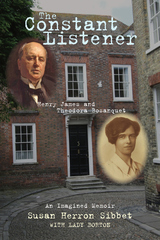 The Constant Listener: Henry James and Theodora Bosanquet—An Imagined Memoir
Susan Herron Sibbet
Ohio University Press, 2017 In 1907, in a quiet English village, Theodora Bosanquet answered Henry James’s call for someone to transcribe his edits and additions to his formidable body of work. The aging James had agreed to revise his novels and tales into the twenty-four-volume New York Edition. Enter Bosanquet, a budding writer who would record the dictated revisions and the prefaces that would become a lynchpin of his legacy. Embracing the role of amanuensis and creative counterpoint cautiously at first, Bosanquet kept a daily diary over the nine years that she worked with James, as their extraordinary partnership evolved. Bosanquet became the first audience for James’s compositions and his closest literary associate—and their relationship ultimately resulted in James’s famed “deathbed dictations.” At the same time, the homosexuality of each was an unspoken but important influence on their mutual support and companionship. Susan Herron Sibbet’s posthumous novel gifts us with the voice of a young woman writer drawn into the intimate circle of an aging master, and is a moving addition to previous literary treatments of James and Bosanquet, even as it hews closer to fact than other works do. The Constant Listener is itself the work of an accomplished poet, and will speak to fans of James, historical fiction, and themes of art, love, sexuality, and identity.
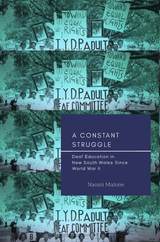 A Constant Struggle: Deaf Education in New South Wales Since World War II
Naomi Malone
Gallaudet University Press, 2019 Deaf education in New South Wales has made tremendous progress since the end of World War II, yet issues remain for students from their early years of education through secondary high school. Naomi Malone traces the roots of these issues and argues that they persist due to the historical fragmentation within deaf education regarding oralism (teaching via spoken language) and manualism (teaching via sign language). She considers the early prevalence of oralism in schools for deaf students, the integration of deaf students into mainstream classrooms, the recognition of Australian Sign Language as a language, and the growing awareness of the diversity of deaf students. Malone’s historical assessments are augmented by interviews with former students and contextualized with explanations of concurrent political and social events. She posits that deaf people must be consulted about their educational experiences and that they must form a united social movement to better advocate for improved deaf education, regardless of communication approach.
Constantine and Eusebius
Timothy D. Barnes
Harvard University Press, 1981 This study of the Roman Empire in the age of Constantine offers a thoroughly new assessment of the part Christianity played in the Roman world of the third and fourth centuries.
Timothy D. Barnes gives the fullest available narrative history of the reigns of Diocletian and Constantine. He analyzes Constantine’s rise to power and his government, demonstrating how Constantine’s sincere adherence to Christianity advanced his political aims. He explores the whole range of Eusebius’ writings, especially those composed before Constantine became emperor, and shows that many attitudes usually deemed typical of the “Constantinian revolution” were prevalent before the new Christian empire came into existence. This authoritative political and cultural history of the age of Constantine will prove essential to students and historians of the ancient world.
 Constantinople and the Latins: The Foreign Policy of Andronicus II, 1282-1328
Angeliki E. Laiou
Harvard University Press, 1972 At the age of twenty-two, Andronicus II became sole ruler of Byzantium. His father, Michael VIII, had been a dashing figure--a good soldier, brilliant diplomat, and the liberator of Constantinople from its fifty-seven-year Latin occupation. By contrast Andronicus seemed colorless and ineffectual. His problems were immense--partly as a result of his father's policies--and his reign proved to be a series of frustrations and disasters.
For forty-six years he fought to preserve the empire against constantencroachments. When he was finally deposed in 1328 by his grandson and co-emperor, Andronicus III, almost all of Asia Minor had been lost to the Turks, Westerners had taken over the defense of the Aegean, and the Catalan army he had invited to help him fight the Turks remained to fight the emperor.
In this penetrating account of Andronicus' foreign policy, Angeliki E. Laiou focuses on Byzantium's relations with the Latin West, the far-reaching domestic implications of the hostility of western Europe, and the critical decision that faced Andronicus: whether to follow his father's lead and allow Byzantium to become a European state or to keep it an Eastern, orthodox power.
The author, who argues that foreign policy cannot be understood without examining the domestic factors that influence, indeed create, it, devotes a large part of her study to domestic developments in Byzantium during Andronicus' reign-the decline of the power of the central government; the spread of semi-independent regional authorities; the state of finances, of the army, of the church.
She concludes that, contrary to common opinion, Andronicus II sincerely desired the union of the Greek and Latin churches, when, in the last years of his reign, he realized that the political situation made such a union necessary. Maintaining also that the conquest of Asia Minor by the Turks was not a foregone conclusion when Andronicus II came to the throne, she discusses at length the errors of policy and the manifold circumstances which combined to precipitate that loss.
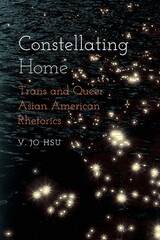 Constellating Home: Trans and Queer Asian American Rhetorics
V. Jo Hsu
Ohio State University Press, 2022 Winner of the 2024 RSA Book Award
Winner of the 2024 Winifred Bryan Horner Outstanding Book Award
Winner of the 2023 NCA Diamond Anniversary Book Award
Winner of the Innovations in Community Writing Book Award from the Conference on Community Writing
Constellating Home: Trans and Queer Asian American Rhetorics explores how race, migration, gender, and disability entwine in conceptions of deserving citizens. V. Jo Hsu explores three archives of trans and queer Asian American (QTAPI) rhetorics, considering a range of texts including oral histories, photography, personal essays, and performance showcases. To demonstrate how QTAPI use personal narrative to critique and revise the conditions of their exclusion, Hsu forwards a critical approach to storytelling, homing, which deliberately engages sites of alienation and belonging. Through a practice of diasporic listening, Hsu tracks confluences among seemingly divergent journeys and locates trans and queer Asian American experiences within broader US and global politics.
The stories at the heart of Constellating Home center the voices of trans and nonbinary people, disabled people, and others often overlooked in conceptions of US citizenry. Hsu’s analyses demonstrate the inextricability of Asian American activism from queer politics, disability activism, and racial justice, and they consider how stories network individual experiences with resonant histories and struggles. Finding unlikely intimacies among individual and communal histories, Constellating Home provides tools for fostering mutual care, revealing harmful social patterns, and orienting shared values and politics.
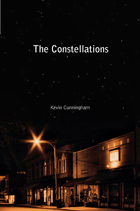 The Constellations
Kevin Cunningham
Northern Illinois University Press, 2012 It’s 1974 in DeKalb County, Illinois and the planets have failed to align for Roy Conlon. Widowed and broke, his eight-year-old son Eric is suddenly a mystery to him. The boy has become aware of a sky awhirl with stars and of the universe outside his small-Midwestern town. And as powerful forces pull Eric away, Roy’s efforts to hold onto his son are threatened by weakness, guilt, and his participation in a foolish crime.
Enter The Constellations, a novel of the diverging paths of a father and his son, and how each copes with the loss of the woman whose love and guidance held them together. Roy and Eric’s parallel journeys take them through a landscape populated by long shot players and kitchen sink philosophers, by ruthless thieves and fierce protectors. A compelling novel of small town America in the shadow of Vietnam and Watergate, Cunningham’s spare prose and deftly drawn heroes complete a portrait of our country reminiscent of Mark Richard and Jim Shepard. Scarred, divided, and damaged, his characters represent all of our false promises and failed dreams.
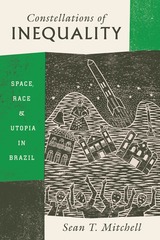 Constellations of Inequality: Space, Race, and Utopia in Brazil
Sean T. Mitchell
University of Chicago Press, 2017 Winner of the 2018 Latin American Studies Association (LASA) Brazil Section Book Prize
In 1982, the Brazilian Air Force arrived on the Alcântara peninsula to build a state-of-the-art satellite launch facility. They displaced some 1,500 Afro-Brazilians from coastal land to inadequate inland villages, leaving many more threatened with displacement. Completed in 1990, this vast undertaking in one of Brazil’s poorest regions has provoked decades of conflict and controversy.
Constellations of Inequality tells this story of technological aspiration and the stark dynamics of inequality it laid bare. Sean T. Mitchell analyzes conflicts over land, ethnoracial identity, mobilization among descendants of escaped slaves, military-civilian competition in the launch program, and international intrigue. Throughout, he illuminates Brazil’s changing politics of inequality and examines how such inequality is made, reproduced, and challenged. How people conceptualize and act on the unequal conditions in which they find themselves, he shows, is as much a cultural and historical matter as a material one. Deftly broadening our understanding of race, technology, development, and political consciousness on local, national, and global levels, Constellations of Inequality paints a portrait of contemporary Brazil that will interest a broad spectrum of readers.
 Constituencies and Leaders in Congress: Their Effects on Senate Voting Behavior
John E. Jackson
Harvard University Press, 1974 This study may be the most sophisticated statistical study of legislative voting now in print. The author asks why legislators, especially U.S. senators, vote as they do. Are they influenced by their constituencies, party, committee leaders, the President? By taking a relatively short time span, the years 1961 to 1963, the author is able to give us answers far beyond any we have had before, and some rather surprising ones at that.
Constituencies played a different, but more important role in senators' voting than earlier studies have shown. Senators appeared to be responding both to the opinion held by their constituents on different issues and to the intensity with which these opinions were held. On the interrelation of constituencies and party, Mr. Jackson finds that Republicans and southern Democrats were particularly influenced by their voters.
The clearest cases of leadership influence were among the non-southern members of the Democratic Party. Western Republicans, on the other hand, rejected the leadership of party members for that of committee leaders. Finally, on Presidential leadership, Mr. Jackson shows that John F. Kennedy influenced senators only during the first two years of his administration. All of these findings challenge conventional wisdom and are bound to influence future work in legislative behavior.
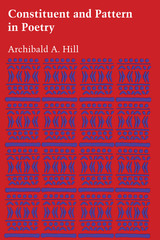 Constituent and Pattern in Poetry
By Archibald A. Hill
University of Texas Press, 1976 Constituent and Pattern in Poetry is a collection of essays on literature and language. It is built on the assumption that works of literature have existence in the real world and that they may be analyzed in a fashion that is not totally subjective. Using models derived from structural linguistics, Archibald A. Hill presents a number of theoretical contributions to the study of poetry, as well as new ways of looking at specific poems. The book as a whole provides an overview of the tools and ideas Hill has developed for analyzing works of literature, and it is the first time the essays have been gathered together in one volume. The book is divided into three sections: Definition of Literature and Study of Its Patterns, Types of Meaning and Imagery, and Principles for Interpreting Meaning. Each section opens with a theoretical essay, followed by three essays that work analytically with specific poets and poems using the methods defined in the first. In his examination of such poets as Hopkins, Browning, Milton, Blake, Keats, and Dickinson, Hill uses such proposals as the law of least lexical contribution and maximal contextual contribution; the hypothesis that, when possible meanings occur together in a cluster, they support each other; and the idea that it is sometimes possible to recover underlying language sequences from which the author has departed for identifiable reasons. By applying these suppositions to the study of particular poems, Hill shows how the reader may arrive at statements about the relative artistic merit of works of literature.
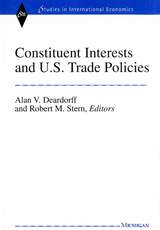 Constituent Interests and U.S. Trade Policies
Alan V. Deardorff and Robert M. Stern
University of Michigan Press, 1998 The contributors to this volume, economists and political scientists from academic institutions, the private sector, and the Ways and Means Committee of the U.S. House of Representatives, came together to discuss an important topic in the formation of U.S. international trade policy: the representation of constituent interests. In the resulting volume they address the objectives of groups who participate in the policy process and examine how each group's interests are identified and promoted. They look at what means are used for these purposes, and the extent to which the groups' objectives and behavior conform to how the political economy of trade policy is treated in the economic and political science literature. Further, they discuss how effective each group has been.
Each of the book's five parts offers a coherent view of important components of the topic. Part I provides an overview of the normative and political economy approaches to the modeling of trade policies. Part 2 discusses the context of U.S. trade policies. Part 3 deals with the role of sectoral producing interests, including the relationship of trade policy to auto, steel, textile, semiconductor, aircraft, and financial services. Part 4 examines other constituent interests, including the environment, human rights, and the media. Part 5 provides commentary on such issues as the challenges that trade policy poses for the new administration and the 105th Congress.
The volume ultimately offers important and more finely articulated questions on how trade policy is formed and implemented.
Contributors are Robert E. Baldwin, Jagdish Bhagwati, Douglas A. Brook, Richard O. Cunningham, Jay Culbert, Alan V. Deardorff, I. M. Destler, Daniel Esty, Geza Feketekuty, Harry Freeman, John D. Greenwald, Gene Grossman, Richard L. Hall, Jutta Hennig, John H. Jackson, James A. Levinsohn, Mustafa Mohatarem, Robert Pahre, Richard C. Porter, Gary R. Saxonhouse, Robert E. Scott, T. N. Srinivasan, Robert M. Stern, Joe Stroud, John Sweetland, Raymond Waldmann, Marina v.N. Whitman, and Bruce Wilson.
Alan V. Deardorff and Robert M. Stern are Professors of Economics and Public Policy, University of Michigan.
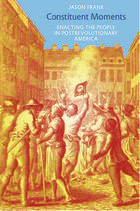 Constituent Moments: Enacting the People in Postrevolutionary America
Jason Frank
Duke University Press, 2010 Since the American Revolution, there has been broad cultural consensus that “the people” are the only legitimate ground of public authority in the United States. For just as long, there has been disagreement over who the people are and how they should be represented or institutionally embodied. In Constituent Moments, Jason Frank explores this dilemma of authorization: the grounding of democratic legitimacy in an elusive notion of the people. Frank argues that the people are not a coherent or sanctioned collective. Instead, the people exist as an effect of successful claims to speak on their behalf; the power to speak in their name can be vindicated only retrospectively. The people, and democratic politics more broadly, emerge from the dynamic tension between popular politics and representation. They spring from what Frank calls “constituent moments,” moments when claims to speak in the people’s name are politically felicitous, even though those making such claims break from established rules and procedures for representing popular voice. Elaborating his theory of constituent moments, Frank focuses on specific historical instances when under-authorized individuals or associations seized the mantle of authority, and, by doing so, changed the inherited rules of authorization and produced new spaces and conditions for political representation. He looks at crowd actions such as parades, riots, and protests; the Democratic-Republican Societies of the 1790s; and the writings of Walt Whitman and Frederick Douglass. Frank demonstrates that the revolutionary establishment of the people is not a solitary event, but rather a series of micropolitical enactments, small dramas of self-authorization that take place in the informal contexts of crowd actions, political oratory, and literature as well as in the more formal settings of constitutional conventions and political associations.
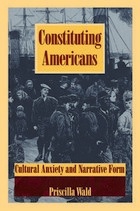 Constituting Americans: Cultural Anxiety and Narrative Form
Priscilla Wald
Duke University Press, 1995 Ever since the founders drafted "We the People," "we" have been at pains to work out the contradictions in their formulation, to fix in words precisely what it means to be American. Constituting Americans rethinks the way that certain writers of the mid-nineteenth and early twentieth century contributed to this project; in doing so, it revises the traditional narrative of U.S. literary history, restoring an essential chapter to the story of an emerging American cultural identity. In diverse ways, very different writers—including Frederick Douglass, Herman Melville, Harriet Wilson, W. E. B. Du Bois, and Gertrude Stein—participated in the construction and dissemination of an American identity, but none was entirely at ease in the culture they all helped to define. Evident in their work is a haunting sense of their telling someone else’s story, a discomfort that Priscilla Wald reads in the context of legal and political debates about citizenship and personhood that marked the emergence of the United States as a nation and a world power.
From early-nineteenth-century Supreme Court cases to turn-of-the-century Jim Crow and immigration legislation, from the political speeches of Abraham Lincoln to the historical work of Woodrow Wilson, nation-builders addressed the legal, political, and historical paradoxes of American identity. Against the backdrop of their efforts, Wald shows how works such as Douglass’s autobiographical narratives, Melville’s Pierre, Wilson’s Our Nig, Du Bois’s The Souls of Black Folks, and Stein’s The Making of Americans responded, through formal innovations, to the aggressive demands for literary participation in the building of that nation. The conversation that emerges among these literary works challenges the definitions and genres that largely determine not only what works are read, but also how they are read in classrooms in the United States today.
Offering insight into the relationship of storytelling to national identity, Constituting Americans will compel the attention of those with an interest in American literature, American studies, and cultural studies.
Constituting Central American–Americans: Transnational Identities and the Politics of Dislocation
Cárdenas, Maritza E
Rutgers University Press, 2018 Central Americans are the third largest and fastest growing Latino population in the United States. And yet, despite their demographic presence, there has been little scholarship focused on this group. Constituting Central American-Americans is an exploration of the historical and disciplinary conditions that have structured U.S. Central American identity and of the ways in which this identity challenges how we frame current discussions of Latina/o, American ethnic, and diasporic identities. By focusing on the formation of Central American identity in the U.S., Maritza E. Cárdenas challenges us to think about Central America and its diaspora in relation to other U.S. ethno-racial identities.
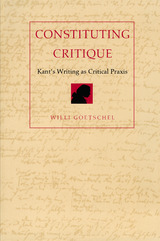 Constituting Critique: Kant’s Writing as Critical Praxis
Willi Goetschel
Duke University Press, 1994 Kant’s philosophy is often treated as a closed system, without reference to how it was written or how Kant arrived at its familiar form, the critique. In fact, the style of the critique seems so artless that readers think of it as an unfortunate by-product—a style of stylelessness. In Constituting Critique, Willi Goetschel shows how this apparent gracelessness was deliberately achieved by Kant through a series of writing experiments. By providing an account of the process that culminated in his three Critiques, this book offers a new perspective on Kant’s philosophical thought and practice.
Constituting Critique traces the stages in Kant’s development to reveal how he redefined philosophy as a critical task. Following the philosopher through the experiments of his early essays, Goetschel demonstrates how Kant tests, challenges, and transforms the philosophical essay in his pursuit of a new self-reflective literary genre. From these experiments, critique emerges as the philosophical form for the critical project of the Enlightenment. The imperatives of its transcendental style, Goetschel contends, not only constitute and inform the critical moment of Kant’s philosophical praxis, but also have an enduring place in post-Kantian philosophy and literature.
By situating the Critiques within the context of Kant’s early essays, this work will redirect the attention of Kant scholars to the origins of their form. It will also encourage contemporary critical theorists to reconsider their own practice through an engagement with its source in Kant.
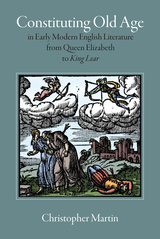 Constituting Old Age in Early Modern English Literature, from Queen Elizabeth to King Lear
Christopher Martin
University of Massachusetts Press, 2012 How did Shakespeare and his contemporaries, whose works mark the last quarter century of Elizabeth I's reign as one of the richest moments in all of English literature, regard and represent old age? Was late life seen primarily as a time of withdrawal and preparation for death, as scholars and historians have traditionally maintained? In this book, Christopher Martin examines how, contrary to received impressions, writers and thinkers of the era—working in the shadow of the kinetic, long-lived queen herself—contested such prejudicial and dismissive social attitudes.
In late Tudor England, Martin argues, competing definitions of and regard for old age established a deeply conflicted frontier between external, socially "constituted" beliefs and a developing sense of an individual's "constitution" or physical makeup, a usage that entered the language in the mid-1500s. This space was further complicated by internal divisions within the opposing camps. On one side, reverence for the elder's authority, rooted in religious and social convention, was persistently challenged by the discontents of an ambitious younger underclass. Simultaneously, the aging subject grounded an enduring social presence and dignity on a bodily integrity that time inevitably threatened. In a historical setting that saw both the extended reign of an aging monarch and a resulting climate of acute generational strife, this network of competition and accommodation uniquely shaped late Elizabethan literary imagination. Through fresh readings of signature works, genres, and figures, Martin redirects critical attention to this neglected aspect of early modern studies.
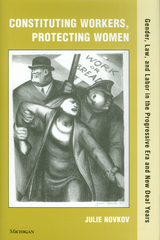 Constituting Workers, Protecting Women: Gender, Law and Labor in the Progressive Era and New Deal Years
Julie Novkov
University of Michigan Press, 2001 Constitutional considerations of protective laws for women were the analytical battlefield on which the legal community reworked the balance between private liberty and the state's authority to regulate. Julie Novkov focuses on the importance of gender as an analytical category for the legal system.
During the Progressive Era and New Deal, courts often invalidated generalized protective legislation, but frequently upheld measures that limited women's terms and conditions of labor. The book explores the reasoning in such cases that were decided between 1873 and 1937. By analyzing all reported opinion on the state and federal level, as well as materials from the women's movement and briefs filed in the U.S. Supreme Court, the study demonstrates that considerations of cases involving women's measures ultimately came to drive the development of doctrine.
The study combines historical institutionalism and feminism to address constitutional interpretation, showing that an analysis of conflict over the meaning of legal categories provides a deeper understanding of constitutional development. In doing so, it rejects purely political interpretations of the so-called Lochner era, in which the courts invalidated many legislative efforts to ameliorate the worst effects of capitalism. By addressing the dynamic interactions among interested laypersons, attorneys, and judges, it demonstrates that no individuals or institutions have complete control over the generation of constitutional meaning.
Julie Novkov is Assistant Professor of Political Science, University of Oregon
 Constituting Workers, Protecting Women: Gender, Law and Labor in the Progressive Era and New Deal Years
Julie Novkov
University of Michigan Press Constitutional considerations of protective laws for women were the analytical battlefield on which the legal community reworked the balance between private liberty and the state's authority to regulate. Julie Novkov focuses on the importance of gender as an analytical category for the legal system.
During the Progressive Era and New Deal, courts often invalidated generalized protective legislation, but frequently upheld measures that limited women's terms and conditions of labor. The book explores the reasoning in such cases that were decided between 1873 and 1937. By analyzing all reported opinion on the state and federal level, as well as materials from the women's movement and briefs filed in the U.S. Supreme Court, the study demonstrates that considerations of cases involving women's measures ultimately came to drive the development of doctrine.
The study combines historical institutionalism and feminism to address constitutional interpretation, showing that an analysis of conflict over the meaning of legal categories provides a deeper understanding of constitutional development. In doing so, it rejects purely political interpretations of the so-called Lochner era, in which the courts invalidated many legislative efforts to ameliorate the worst effects of capitalism. By addressing the dynamic interactions among interested laypersons, attorneys, and judges, it demonstrates that no individuals or institutions have complete control over the generation of constitutional meaning.
Julie Novkov is Assistant Professor of Political Science, University of Oregon
 The Constitution and the New Deal
G. Edward White
Harvard University Press, 2000 In a powerful new narrative, G. Edward White challenges the reigning understanding of twentieth-century Supreme Court decisions, particularly in the New Deal period. He does this by rejecting such misleading characterizations as "liberal," "conservative," and "reactionary," and by reexamining several key topics in constitutional law.
Through a close reading of sources and analysis of the minds and sensibilities of a wide array of justices, including Holmes, Brandeis, Sutherland, Butler, Van Devanter, and McReynolds, White rediscovers the world of early-twentieth-century constitutional law and jurisprudence. He provides a counter-story to that of the triumphalist New Dealers. The deep conflicts over constitutional ideas that took place in the first half of the twentieth century are sensitively recovered, and the morality play of good liberals vs. mossbacks is replaced. This is the only thoroughly researched and fully realized history of the constitutional thought and practice of all the Supreme Court justices during the turbulent period that made America modern.
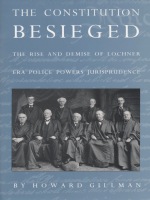 The Constitution Besieged: The Rise & Demise of Lochner Era Police Powers Jurisprudence
Howard Gillman
Duke University Press, 1993 The Constitution Besieged offers a compelling reinterpretation of one of the most notorious periods in American constitutional history. In the decades following the Civil War, federal and state judges struck down as unconstitutional a great deal of innovative social and economic legislation. Scholars have traditionally viewed this as the work of a conservative judiciary more interested in promoting laissez-faire economics than in interpreting the Constitution. Gillman challenges this scholarly orthodoxy by showing how these judges were in fact observing a long-standing constitutional prohibition against "class legislation." Originally published in cloth by Duke University Press, this book received the 1994 C. Herman Pritchett Award for the "Best Book in the Field of Law and Courts," awarded by the Law and Courts Section of the American Political Science Association.
Constitution for a Disunited Nation: On Hungary's 2011 Fundamental Law
Gábor Attila Tóth
Central European University Press, 2013 This collection is the most comprehensive account of the Fundamental Law and its underlying principles. The objective is to analyze this constitutional transition from the perspectives of comparative constitutional law, legal theory and political philosophy. The authors outline and analyze how the current constitutional changes are altering the basic structure of the Hungarian State. The key concepts of the theoretical inquiry are sociological and normative legitimacy, majoritarian and partnership approach to democracy, procedural and substantive elements of constitutionalism. Changes are also examined in the field of human rights, focusing on the principles of equality, dignity, and civil liberties.
The Constitution in Conflict
Robert A. Burt
Harvard University Press, 1992 In a remarkably innovative reconstruction of constitutional history, Robert Burt traces the controversy over judicial supremacy back to the founding fathers. Also drawing extensively on Lincoln’s conception of political equality, Burt argues convincingly that judicial supremacy and majority rule are both inconsistent with the egalitarian democratic ideal. The first fully articulated presentation of the Constitution as a communally interpreted document in which the Supreme Court plays an important but not predominant role, The Constitution in Conflict has dramatic implications for both the theory and the practice of constitutional law.
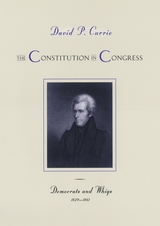 The Constitution in Congress: Democrats and Whigs, 1829-1861
David P. Currie
University of Chicago Press, 2005 The Constitution in Congress series has been called nothing less than a biography of the US Constitution for its in-depth examination of the role that the legislative and executive branches have played in the development of constitutional interpretation. This third volume in the series, the early installments of which dealt with the Federalist and Jeffersonian eras, continues this examination with the Jacksonian revolution of 1829 and subsequent efforts by Democrats to dismantle Henry Clay’s celebrated “American System” of nationalist economics. David P. Currie covers the political events of the period leading up to the start of the Civil War, showing how the slavery question, although seldom overtly discussed in the debates included in this volume, underlies the Southern insistence on strict interpretation of federal powers.
Like its predecessors, The Constitution in Congress: Democrats and Whigs will be an invaluable reference for legal scholars and constitutional historians alike.
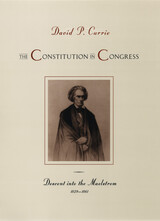 The Constitution in Congress: Descent into the Maelstrom, 1829-1861
David P. Currie
University of Chicago Press, 2005 This acclaimed series serves as a biography of the U.S. Constitution, offering an indispensable survey of the congressional history behind its development. In a rare examination of the role that both the legislative and executive branches have played in the development of constitutional interpretation, The Constitution in Congress shows how the actions and proceedings of these branches reveal perhaps even more about constitutional disputes than Supreme Court decisions of the time.
The centerpiece for the fourth volume in this series is the great debate over slavery and how this divisive issue led the country into the maelstrom of the Civil War. From the Jacksonian revolution of 1829 to the secession of Southern states from the Union, legal scholar David P. Currie provides an unrivaled analysis of the significant constitutional events—the Wilmot Proviso, the Compromise of 1850, the Kansas-Nebraska Act, the Lincoln-Douglas Debates, and "Bleeding Kansas"—that led up to the war. Exploring how slavery was addressed in presidential speeches and debated in Congress, Currie shows how the Southern Democrats dangerously diminished federal authority and expanded states' rights, threatening the nation's very survival.
Like its predecessors, this fourth volume of The Constitution in Congress will be an invaluable reference for legal scholars and constitutional historians alike.
The Constitution in Congress: The Federalist Period, 1789-1801
David P. Currie
University of Chicago Press, 1997 In the most thorough examination to date, David P. Currie analyzes from a legal perspective the work of the first six congresses and of the executive branch during the Federalist era, with a view to its significance for constitutional interpretation. He concludes that the original understanding of the Constitution was forged not so much in the courts as in the legislative and executive branches, an argument of crucial importance for scholars in constitutional law, history, and government.
"A joy to read."—Appellate Practive Journal and Update
"[A] patient and exemplary analysis of the work of the first six Congresses."—Geoffrey Marshall, Times Literary Supplement
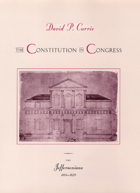 The Constitution in Congress: The Jeffersonians, 1801-1829
David P. Currie
University of Chicago Press, 2001 Because of the judicial branch's tremendous success in reviewing
legislative and executive action in the United States, legal scholars
have traditionally looked only to the courts for guidance in
interpreting the Constitution. This, the second book in David P.
Currie's multivolume series, looks to the legislative and executive
branches for insights into the development of constitutional
interpretation.
Currie examines the period of Republican hegemony from the
inauguration of Thomas Jefferson in 1801 to the election of Andrew
Jackson in 1829. During this time of great leadership and
controversy, many benchmark issues—the abolition of the new Circuit
Courts, the Louisiana Purchase, the Burr conspiracy, the War of 1812,
the Monroe Doctrine, and the Missouri Compromise, among others—were
debated and decided almost exclusively in the legislative and
executive arenas. With its uniquely legal perspective and
comprehensive coverage, The Constitution in Congress
illustrates how the executive and legislative branches matched the
Supreme Court in putting flesh and blood onto the skeleton of the
Constitution.
The Constitution in the Supreme Court: The First Hundred Years, 1789-1888
David P. Currie
University of Chicago Press, 1985 Currie's masterful synthesis of legal analysis and narrative history, gives us a sophisticated and much-needed evaluation of the Supreme Court's first hundred years.
"A thorough, systematic, and careful assessment. . . . As a reference work for constitutional teachers, it is a gold mine."—Charles A. Lofgren, Constitutional Commentary
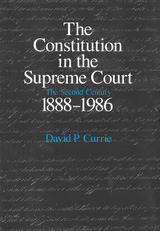 The Constitution in the Supreme Court: The Second Century, 1888-1986
David P. Currie
University of Chicago Press, 1990 The Constitution in the Supreme Court: The Second Century traces the development of the Supreme Court from Chief Justice Fuller (1888-1910) to the retirement of Chief Justice Burger (1969-1986). Currie argues that the Court's work in its second century revolved around two issues: the constitutionality of the regulatory and spending programs adopted to ameliorate the hardships caused by the Industrial Revolution and the need to protect civil rights and liberties. Organizing the cases around the tenure of specific chief justices, Currie distinguishes among the different methods of constitutional exegesis, analyzes the various techniques of opinion writing, and evaluates the legal performance of different Courts.
"Elegant and readable. Whether you are in favor of judicial restraint or judicial activism, whatever your feelings about the Warren Court, or the Renquist Court, this is a book that justifies serious study."—Robert Stevens, New York Times Book Review
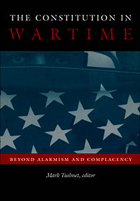 The Constitution in Wartime: Beyond Alarmism and Complacency
Mark Tushnet, ed.
Duke University Press, 2005 Most recent discussion of the United States Constitution and war—both the war on terrorism and the war in Iraq—has been dominated by two diametrically opposed views: the alarmism of those who see many current policies as portending gross restrictions on American civil liberties, and the complacency of those who see these same policies as entirely reasonable accommodations to the new realities of national security. Whatever their contributions to the public discussion and policy-making processes, these voices contribute little to an understanding of the real constitutional issues raised by war. Providing the historical and legal context needed to assess competing claims, The Constitution in Wartime identifies and explains the complexities of the important constitutional issues brought to the fore by wartime actions and policies. Twelve prominent legal scholars and political scientists combine broad overviews of U.S. history and contemporary policy with detailed yet accessible analyses of legal issues of pressing concern today. Some of the essays are broad in scope, reflecting on national character, patriotism, and political theory; exploring whether war and republican government are compatible; and considering in what sense we can be said to be in wartime circumstances today. Others are more specific, examining the roles of Congress, the presidency, the courts, and the international legal community. Throughout the collection, balanced, unbiased analysis leads to some surprising conclusions, one of which is that wartime conditions have sometimes increased, rather than curtailed, civil rights and civil liberties. For instance, during the cold war, government officials regarded measures aimed at expanding African Americans’ freedom at home as crucial to improving America’s image abroad. Contributors. Sotirios Barber, Mark Brandon, James E. Fleming, Mark Graber, Samuel Issacharoff, David Luban, Richard H. Pildes, Eric Posner, Peter Spiro, William Michael Treanor, Mark Tushnet, Adrian Vermeule
The Constitution of Liberty
F. A. Hayek
University of Chicago Press, 1978 "One of the great political works of our time, . . . the twentieth-century successor to John Stuart Mill's essay, 'On Liberty.'"—Henry Hazlitt, Newsweek
"A reflective, often biting, commentary on the nature of our society and its dominant thought by one who is passionately opposed to the coercion of human beings by the arbitrary will of others, who puts liberty above welfare and is sanguine that greater welfare will thereby ensue."—Sidney Hook, New York Times Book Review
In this classic work Hayek restates the ideals of freedom that he believes have guided, and must continue to guide, the growth of Western civilization. Hayek's book, first published in 1960, urges us to clarify our beliefs in today's struggle of political ideologies.
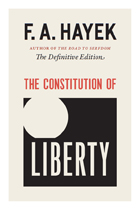 The Constitution of Liberty: The Definitive Edition
F. A. Hayek
University of Chicago Press, 2011 From the $700 billion bailout of the banking industry to president Barack Obama’s $787 billion stimulus package to the highly controversial passage of federal health-care reform, conservatives and concerned citizens alike have grown increasingly fearful of big government. Enter Nobel Prize–winning economist and political theorist F. A. Hayek, whose passionate warning against empowering states with greater economic control, The Road to Serfdom, became an overnight sensation last summer when it was endorsed by Glenn Beck. The book has since sold over 150,000 copies. The latest entry in the University of Chicago Press’s series of newly edited editions of Hayek’s works, The Constitution of Liberty is, like Serfdom, just as relevant to our present moment. The book is considered Hayek’s classic statement on the ideals of freedom and liberty, ideals that he believes have guided—and must continue to guide—the growth of Western civilization. Here Hayek defends the principles of a free society, casting a skeptical eye on the growth of the welfare state and examining the challenges to freedom posed by an ever expanding government—as well as its corrosive effect on the creation, preservation, and utilization of knowledge. In opposition to those who call for the state to play a greater role in society, Hayek puts forward a nuanced argument for prudence. Guided by this quality, he elegantly demonstrates that a free market system in a democratic polity—under the rule of law and with strong constitutional protections of individual rights—represents the best chance for the continuing existence of liberty. Striking a balance between skepticism and hope, Hayek’s profound insights are timelier and more welcome than ever before. This definitive edition of The Constitution of Liberty will give a new generation the opportunity to learn from his enduring wisdom.
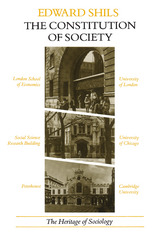 The Constitution of Society
Edward Shils
University of Chicago Press, 1982 Edward Shils's attempt to work out a macrosociological theory which does justice both to the spiritual and intellectual dispositions and powers of the mind and to the reality of the larger society is an enterprise that has spanned several decades. In his steps toward the development of this theory he has not proceeded deductively; rather he has worked from his own concrete observations of Western, Asian, and African societies. Thus, despite the inevitable abstractness of marcrosociological theory, the papers in this volume—which have been published separately since the Second World War—have a quality of vivid substantiality that makes the theoretical statements they present easier to comprehend.
Professor Shils has attempted to develop a theory that has a place for more than those parts of society that are generated from the biological nature of human beings and those parts that are engendered by the desires of individuals, acting for themselves or for groups and categories of individuals, to maintain and increase their power over other human beings and to secure material goods and services for themselves. He has argued that there are constituents of society in which human beings seek and cultivate connections with objects that transcend those needed to satisfy biological necessity and the desire for material objects and power over others. This third stratum of social existence, he concludes, cannot be reduced to the other two and cannot be disregarded in any serious attempt to understand the function of any society. Thus Edward Shils, without disregarding its many valuable achievements, has nevertheless parted ways with much of modern sociology.
For this collection of papers the author has written an introductory intellectual autobiography that places each essay in the setting of the development of his thought and that connects it with his other writings.
 The Constitution of the Federal Republic of Germany
David P. Currie
University of Chicago Press, 1994 A leading scholar of the constitution of the United States, David Currie, in this book turns his attention to one of the most important bodies of constitutional law in the world, the Basic Law of Germany. It is a comprehensive and accessible introduction to the study of the German constitution.
Beginning with an overview of the essential features of the Basic Law of Germany, Currie then elucidates those features by analyzing a number of decisions of the German Constitutional Court. Contrasting German constitutional law with the American model, Currie further illuminates the German system and provides an invaluable comparative perspective on American institutions, judicial methods, and constitutional principles.
The German constitutional court recently has become the object of international attention as it has grappled with controversies involving abortion, ratification of the Maastricht Treaty, and the reunification of East and West. Currie examines these issues and their impact on the German constitution.
An appendix includes (in English translation) the complete Basic Law for the Federal Republic of Germany of May 23, 1949 as amended to December 1, 1993.
The Constitution of the United States, 1787–1962
Putnam F. Jones
University of Pittsburgh Press, 1962 The essays in this collection commemorate the 175th anniversary of the establishment of the United States Constitution. The writings offer perspectives on topics including: the British background of American constitutionalism; reasons why the Constitution has remained so durable; the counterbalance of liberty and authority it maintains through the Supreme Court and the Bill of Rights; and a balance of both liberal and conservative views.
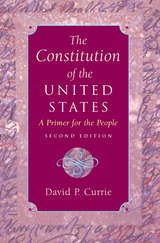 The Constitution of the United States: A Primer for the People
David P. Currie
University of Chicago Press, 2000 A concise, accessible, nonpartisan guide to the United States Constitution
A masterly introduction to the United States Constitution, this slim book leads the reader through a concise overview of the document's individual articles and amendments. With clear and accessible language, Currie then examines each of the three branches of the federal government and explains the relation between the federal and state governments. He analyzes those constitutional provisions that are designed to protect citizens from governmental interference, such as the due process and equal protection clauses and the confusing first amendment provisions respecting the separation of church and state, and includes discussions of judicial review and freedom of speech and of the press.
A sympathetic yet critical guide, Currie's book enables students and laypersons to understand one of the cornerstones of the Western political tradition. The second edition, along with an updated chronology and bibliography, incorporates the Supreme Court decisions over the past decade that have affected constitutional interpretation.
 The Constitution of the United States: A Primer for the People
David P. Currie
University of Chicago Press, 2000 This is an auto-narrated audiobook version of this book.
A masterly introduction to the United States Constitution, this slim book leads the reader through a concise overview of the document's individual articles and amendments. With clear and accessible language, Currie then examines each of the three branches of the federal government and explains the relation between the federal and state governments. He analyzes those constitutional provisions that are designed to protect citizens from governmental interference, such as the due process and equal protection clauses and the confusing first amendment provisions respecting the separation of church and state, and includes discussions of judicial review and freedom of speech and of the press.
A sympathetic yet critical guide, Currie's book enables students and laypersons to understand one of the cornerstones of the Western political tradition. The second edition, along with an updated chronology and bibliography, incorporates the Supreme Court decisions over the past decade that have affected constitutional interpretation.
"Superb . . . highly recommended for those seeking a reliable, understandable, and useful introduction to our constitution."—Appellate Practice Journal and Update
The Constitution of the United States: In Some of its Fundamental Aspects
Gaspar G. Bacon
Harvard University Press Written for the enlightenment of the average citizen of the Republic and with the avowed purpose of bringing about a better understanding of our Constitution in some of its fundamental aspects, this book presents in simple form and in an interesting manner some of the important current problems of citizenship. Gaspar Bacon has been for years a close student of constitutional law, and is able, because of his detailed acquaintance with the subject, to bring out those essential characteristics of the Constitution that everyone should know. The book embodies the first series of lectures delivered at Boston University on the Bacon Lectureship.
 The Constitution, the Law, and Freedom of Expression: 1787-1987
James Brewer Stewart
Southern Illinois University Press, 1987
In recognition of the bicentennial of the Constitution of the United States, former chief justice Warren E. Burger, Justice Antonin Scalia, ACLU president Norman Dorsen, and others delivered papers at the first annual DeWitt Wallace Conference on the Liberal Arts, held at Macalester College, St. Paul.
Joining some of the best legal minds in America were novelist John Edgar Wideman, chemist Harry B. Gray, historian Mary Beth Norton, and psychiatrist and social psychologist Robert Jay Lifton.
Opening the conference and this book, former chief Justice Burger emphasizes the daring of those who drafted the Constitution. Justice Scalia, noting the great reduction in curbs to freedom of expression since World War I, points out that the proliferation of freedom has forced courts to distinguish between types of expression.
Although the views expressed in these essays differ widely, opinion concerning the major issue falls into two definite camps: Burger, Scalia, and Dorsen contend that freedom of expression depends on the legal structure for survival; Wideman, Gray, Lifton, and Norton maintain that social forces determine freedom of expression.
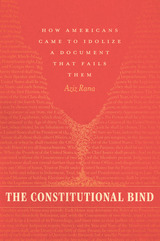 The Constitutional Bind: How Americans Came to Idolize a Document That Fails Them
Aziz Rana
University of Chicago Press, 2024 An eye-opening account of how Americans came to revere the Constitution and what this reverence has meant domestically and around the world. Some Americans today worry that the Federal Constitution is ill-equipped to respond to mounting democratic threats and may even exacerbate the worst features of American politics. Yet for as long as anyone can remember, the Constitution has occupied a quasi-mythical status in American political culture, which ties ideals of liberty and equality to assumptions about the inherent goodness of the text’s design. The Constitutional Bind explores how a flawed document came to be so glorified and how this has impacted American life. In a pathbreaking retelling of the American experience, Aziz Rana shows that today’s reverential constitutional culture is a distinctively twentieth-century phenomenon. Rana connects this widespread idolization to another relatively recent development: the rise of US global dominance. Ultimately, such veneration has had far-reaching consequences: despite offering a unifying language of reform, it has also unleashed an interventionist national security state abroad while undermining the possibility of deeper change at home. Revealing how the current constitutional order was forged over the twentieth century, The Constitutional Bind also sheds light on an array of movement activists—in Black, Indigenous, feminist, labor, and immigrant politics—who struggled to imagine different constitutional horizons. As time passed, these voices of opposition were excised from memory. Today, they offer essential insights.
 The Constitutional Bind: How Americans Came to Idolize a Document That Fails Them
Aziz Rana
University of Chicago Press, 2024 This is an auto-narrated audiobook version of this book.
An eye-opening account of how Americans came to revere the Constitution and what this reverence has meant domestically and around the world. Some Americans today worry that the Federal Constitution is ill-equipped to respond to mounting democratic threats and may even exacerbate the worst features of American politics. Yet for as long as anyone can remember, the Constitution has occupied a quasi-mythical status in American political culture, which ties ideals of liberty and equality to assumptions about the inherent goodness of the text’s design. The Constitutional Bind explores how a flawed document came to be so glorified and how this has impacted American life. In a pathbreaking retelling of the American experience, Aziz Rana shows that today’s reverential constitutional culture is a distinctively twentieth-century phenomenon. Rana connects this widespread idolization to another relatively recent development: the rise of US global dominance. Ultimately, such veneration has had far-reaching consequences: despite offering a unifying language of reform, it has also unleashed an interventionist national security state abroad while undermining the possibility of deeper change at home. Revealing how the current constitutional order was forged over the twentieth century, The Constitutional Bind also sheds light on an array of movement activists—in Black, Indigenous, feminist, labor, and immigrant politics—who struggled to imagine different constitutional horizons. As time passed, these voices of opposition were excised from memory. Today, they offer essential insights.
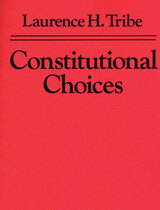 Constitutional Choices
Laurence H. Tribe
Harvard University Press, 1985 Constitutional Choices illuminates the world of scholarship and advocacy uniquely combined by Laurence Tribe, one of the nation’s leading professors of constitutional law and most successful practitioners before the Supreme Court. In his new hook, Tribe boldly moves beyond the seemingly endless debate over which judicial approaches to enforcing the Constitution are “legitimate” and which are not. Arguing that all claims to legitimacy must remain suspect, Tribe focuses instead on the choices that must nonetheless be made in resolving actual constitutional controversies. To do so, he examines problems as diverse as interstate banking, gender discrimination, church subsidies, the constitutional amendment process, the war powers of the President, and First Amendment protection of American Nazis.
Challenging the ruling premises underlying many of the Supreme Court’s positions on fundamental issues of government authority and individual rights, Tribe shows how the Court is increasingly coming to resemble a judicial Office of Management and Budget, straining constitutional discourse through a managerial sieve and defending its constitutional rulings by “balancing” what it counts as “costs” against what it deems “benefits.” Tribe explains how the Court’s “Calculus” systematically excludes basic concerns about the distribution of wealth and power and conceals fundamental choices about the American polity. Calling for a more candid confrontation of those choices and of the principles and perspectives they reflect, Tribe exposes what has gone wrong and suggests how the Court can begin to reclaim the historic role entrusted to it by the Constitution.
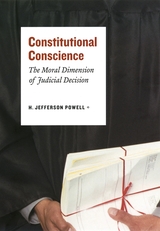 Constitutional Conscience: The Moral Dimension of Judicial Decision
H. Jefferson Powell
University of Chicago Press, 2008 While many recent observers have accused American judges—especially Supreme Court justices—of being too driven by politics and ideology, others have argued that judges are justified in using their positions to advance personal views. Advocating a different approach—one that eschews ideology but still values personal perspective—H. Jefferson Powell makes a compelling case for the centrality of individual conscience in constitutional decision making.
Powell argues that almost every controversial decision has more than one constitutionally defensible resolution. In such cases, he goes on to contend, the language and ideals of the Constitution require judges to decide in good faith, exercising what Powell calls the constitutional virtues: candor, intellectual honesty, humility about the limits of constitutional adjudication, and willingness to admit that they do not have all the answers. Constitutional Conscience concludes that the need for these qualities in judges—as well as lawyers and citizens—is implicit in our constitutional practices, and that without them judicial review would forfeit both its own integrity and the credibility of the courts themselves.
 Constitutional Construction: Divided Powers and Constitutional Meaning
Keith E. Whittington
Harvard University Press, 1999 This book argues that the Constitution has a dual nature. The first aspect, on which legal scholars have focused, is the degree to which the Constitution acts as a binding set of rules that can be neutrally interpreted and externally enforced by the courts against government actors. This is the process of constitutional interpretation. But according to Keith Whittington, the Constitution also permeates politics itself, to guide and constrain political actors in the very process of making public policy. In so doing, it is also dependent on political actors, both to formulate authoritative constitutional requirements and to enforce those fundamental settlements in the future. Whittington characterizes this process, by which constitutional meaning is shaped within politics at the same time that politics is shaped by the Constitution, as one of construction as opposed to interpretation.
Whittington goes on to argue that ambiguities in the constitutional text and changes in the political situation push political actors to construct their own constitutional understanding. The construction of constitutional meaning is a necessary part of the political process and a regular part of our nation's history, how a democracy lives with a written constitution. The Constitution both binds and empowers government officials. Whittington develops his argument through intensive analysis of four important cases: the impeachments of Justice Samuel Chase and President Andrew Johnson, the nullification crisis, and reforms of presidential-congressional relations during the Nixon presidency.
The Constitutional Convention and Formation of Union
Edited by Winton U. Solberg
University of Illinois Press, 1990 The American Constitution was hammered out in debates by the founding fathers at the 1787 Philadelphia Convention. This book contains James Madison's notes on the debates which provide a first-hand view of the drafting of the nation's fundamental charter. An introduction by Winton U. Solberg places the origins of the Constitution in the broader historical perspective of the development of political theory and constitutional practice in Western civilization. The book also links the formation of the Constitution, biographical sketches of each participant in the Philadelphia Convention, and population figures on which representation was to be based.
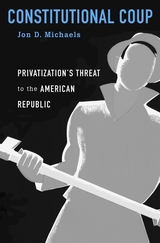 Constitutional Coup: Privatization’s Threat to the American Republic
Jon D. Michaels
Harvard University Press, 2017 Americans have a love-hate relationship with government. Rejecting bureaucracy—but not the goods and services the welfare state provides—Americans have demanded that government be made to run like a business. Hence today’s privatization revolution.
But as Jon D. Michaels shows, separating the state from its public servants, practices, and institutions does violence to our Constitution, and threatens the health and stability of the Republic. Constitutional Coup puts forward a legal theory that explains the modern welfare state as a worthy successor to the framers’ three-branch government.
What legitimates the welfare state is its recommitment to a rivalrous system of separation of powers, in which political agency heads, career civil servants, and the public writ large reprise and restage the same battles long fought among Congress, the president, and the courts. Privatization now proclaims itself as another worthy successor, this time to an administrative state that Americans have grown weary of. Yet it is a constitutional usurper. Privatization dismantles those commitments to separating and checking state power by sidelining rivalrous civil servants and public participants.
Constitutional Coup cements the constitutionality of the administrative state, recognizing civil servants and public participants as necessary—rather than disposable—components. Casting privatization as an existential constitutional threat, it underscores how the fusion of politics and profits commercializes government—and consolidates state power in ways both the framers and administrative lawyers endeavored to disaggregate. It urges—and sketches the outlines of—a twenty-first-century bureaucratic renaissance.
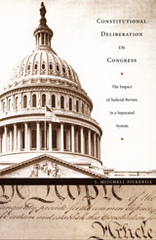 Constitutional Deliberation in Congress: The Impact of Judicial Review in a Separated System
J. Mitchell Pickerill
Duke University Press, 2004 In Constitutional Deliberation in Congress J. Mitchell Pickerill analyzes the impact of the Supreme Court’s constitutional decisions on Congressional debates and statutory language. Based on a thorough examination of how Congress responds to key Court rulings and strategizes in anticipation of them, Pickerill argues that judicial review—or the possibility of it—encourages Congressional attention to constitutional issues. Revealing critical aspects of how laws are made, revised, and refined within the separated system of government of the United States, he makes an important contribution to “constitutionalism outside the courts” debates. Pickerill combines legislative histories, extensive empirical findings, and interviews with current and former members of Congress, congressional staff, and others. He examines data related to all of the federal legislation struck down by the Supreme Court from the beginning of the Warren Court in 1953 through the 1996–97 term of the Rehnquist Court. By looking at the legislative histories of Congressional acts that invoked the Commerce Clause and presented Tenth Amendment conflicts—such as the Child Labor Act (1916), the Civil Rights Act (1965), the Gun-Free School Zones Act (1990), and the Brady Bill (1994)—Pickerill illuminates how Congressional deliberation over newly proposed legislation is shaped by the possibility of judicial review. The Court’s invalidation of the Gun-Free School Zones Act in its 1995 ruling United States v. Lopez signaled an increased judicial activism regarding issues of federalism. Pickerill examines that case and compares congressional debate over constitutional issues in key pieces of legislation that preceded and followed it: the Violence Against Women Act of 1994 and the Hate Crimes Prevention Act of 1997. He shows that Congressional attention to federalism increased in the 1990s along with the Court’s greater scrutiny.
 Constitutional Democracy
János Kis
Central European University Press, 2003 Constitutional democracy addresses the widely held belief that liberal democracy embodies an uneasy compromise of incompatible values: those of liberal rights on the one hand, and democratic equality on the other. Liberalism is said to compromise democracy, while democracy is said to endanger the values of liberalism. It is these theses that János Kis examines and tries to refute. Making the assumption that the alleged conflict is to be resolved at the level of institutions, he outlines a new theory of constitutional democracy. A wide range of problems encountered in constitutional democracy are discussed, such as the popular vote, popular sovereignty, and non-elected justices. The volume is composed of three parts. Part One, "Public Good and Civic Virtue", revisits the debate between liberals and democrats on how to interpret the democratic vote. In Part Two, "Liberal Democracy", the author proves that on the level of principles there is no incompatibility between liberalism and democracy and that liberal theory can demonstrate that democratic values follow from fundamental liberal values. In Part Three, "Constitutional Adjudication in a Democracy", the compatibility of democracy and judicial or constitutional review is analyzed and a theory of constitutionalism is outlined. This volume appeals to scholars in political philosophy, political science, and constitutional law, but is also recommended to all those interested in liberal and democratic theory, and the transition to democracy in Central and Eastern Europe.
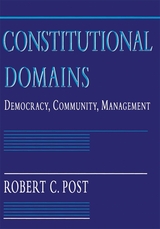 Constitutional Domains: Democracy, Community, Management
Robert C. Post
Harvard University Press, 1995 In a series of remarkable forays, Robert Post develops an original account of how law functions in a democratic society. His work offers a radically new perspective on some of the most pressing constitutional issues of our day, such as the regulation of racist speech, pornography, and privacy.
Drawing on work in sociology, philosophy, and political theory, Post demonstrates that the law establishes distinct and competing forms of social order: democracy, in which the law embodies the possibilities of collective self-determination; community, in which the law articulates and enforces a common social identity; and management, in which the law creates the conditions for accomplishing specific goals. Debates over the boundaries between these distinct domains, Post argues, are central to some of the most intractable problems of modern constitutional law. Here we see, for instance, how the controversy over the regulation of racist speech negotiates the boundary between communitarian and democratic forms of social ordering. We see how public forum doctrine, a crucial but notoriously mysterious component of First Amendment jurisprudence, arbitrates distinctions between the social domains of democracy and management. Taking up specific court cases, such as that against Hustler magazine and that allowing prayers before state legislatures, Post shows us what is actually at stake in these constitutional struggles.
A highly complex and sophisticated account of the operation of constitutional law in modern society, Constitutional Domains is essential reading for lawyers, social theorists, and makers of public policy.
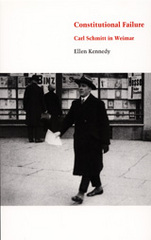 Constitutional Failure: Carl Schmitt in Weimar
Ellen Kennedy
Duke University Press, 2004 Constitutional Failure is a major contribution to studies of the German political philosopher Carl Schmitt (1888–1985), the Weimar Republic, and the relationship of constitutionalism, political economy, and democracy. An internationally renowned scholar of Weimar legal theory, Ellen Kennedy brought Schmitt’s neglected work to the attention of English-speaking readers with her highly regarded translations of his work and studies of its place in twentieth-century political theory. In this eagerly awaited book, she tracks Schmitt’s contribution to the canon of Western political philosophy during its most difficult and dangerous moment—the time of Weimar Germany and the Third Reich—demonstrating the centrality of his thought to understandings of the modern constitutional state and its precarious economic and social foundations. Kennedy reveals how Schmitt’s argument for a strong but neutral state supported the maximization of market freedom at the cost of the political constitution. She argues that the major fault lines of Weimar liberalism—emergency powers, the courts as “defenders of the constitution,” mass mobilization of anti-liberal politics, ethnic-identity politics, a culture of resentment and contested legitimacy—are not exceptions within the liberal-democratic orders of the West, but central to them. Contending that Schmitt’s thought remains vital today because liberal norms are inadequate to the political challenges facing constitutional systems as diverse as those of Eastern Europe and the United States, Kennedy develops a compelling, rigorous argument that unsettles many assumptions about liberalism, democracy, and dictatorship.
Constitutional History of the American Revolution
John Phillip Reid
University of Wisconsin Press, 1995 Designed for use in courses, this abridged edition of the four-volume Constitutional History of the American Revolution demonstrates how significant constitutional disputes were in instigating the American Revolution. John Phillip Reid addresses the central constitutional issues that divided the American colonists from their English legislators: the authority to tax, the authority to legislate, the security of rights, the nature of law, the foundation of constitutional government in custom and contractarian theory, and the search for a constitutional settlement. Reid's distinctive analysis discusses the irreconcilable nature of this conflict—irreconcilable not because leaders in politics on both sides did not desire a solution, but because the dynamics of constitutional law impeded a solution that permitted the colonies to remain part of the dominions of George III.
Constitutional History of the American Revolution - Abridged
John Phillip Reid
University of Wisconsin Press, 1995 Designed for use in courses, this abridged edition of the four-volume Constitutional History of the American Revolution demonstrates how significant constitutional disputes were in instigating the American Revolution. John Phillip Reid addresses the central constitutional issues that divided the American colonists from their English legislators: the authority to tax, the authority to legislate, the security of rights, the nature of law, the foundation of constitutional government in custom and contractarian theory, and the search for a constitutional settlement. Reid's distinctive analysis discusses the irreconcilable nature of this conflict—irreconcilable not because leaders in politics on both sides did not desire a solution, but because the dynamics of constitutional law impeded a solution that permitted the colonies to remain part of the dominions of George III.
Constitutional History of the American Revolution, Volume I: The Authority Of Rights
John Phillip Reid
University of Wisconsin Press, 1987 Constitutional History of the American Revolution
Volume I: The Authority of Rights
Volume II: The Authority to Tax
Volume III: The Authority to Legislate
Volume IV: The Authority of Law
John Phillip Reid addresses the central constitutional issues that divided the American colonists from their English legislators: the authority to tax, the authority to legislate, the security of rights, the nature of law, the foundation of constitutional government in custom and contractarian theory, and the search for a constitutional settlement.
Constitutional History of the American Revolution, Volume II: The Authority To Tax
John Phillip Reid
University of Wisconsin Press, 1987 John Phillip Reid addresses the central constitutional issues that divided the American colonists from their English legislators: the authority to tax, the authority to legislate, the security of rights, the nature of law, the foundation of constitutional government in custom and contractarian theory, and the search for a constitutional settlement.
|
|




